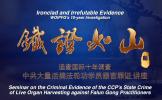Chapter Six :New Evidence Confirms the Live Organ Harvesting of Falun Gong is Proceeding at a Relatively Constant Rate. In Certain Hospitals it is Increasing
Summary: In the last chapter, we made revisions to the liver and kidney transplant data for 712 hospitals. This is because we noticed the discrepancies in official data from reports in China and the fact that some data were never updated. So we revised our report with a focus on transplant data in different time frames. We noticed that the highest number of transplants reported in each hospital’s public announcement was only 200-300 per year. However, with further investigation, we found that these were fabricated and manipulated data and were meant to cover up the crimes committed by the CCP. The size of China’s transplant industry is approximately three times higher than the Chinese medical establishment has portrayed it.
In this chapter we will demonstrate that:
· The majority of the organs that are sourced in China are from Falun Gong practitioners.
· The velocity of the live organ harvesting of Falun Gong is actually on the increase.
· The number of Falun Gong practitioners murdered for their organs over time is far greater than any investigative body, including ours, previously understood.
We have come to this conclusion, based on the evidence of specific hospitals and their decisions over infrastructure and hiring practices, an investigation by Radio Free Asia, and our phone investigative phone conversations with top Party officials.
Contents
I. The Deputy Head of a Large Hospital Reveals that the Number of Transplants in Large Hospitals is as High as 2,000-3,000 Per Year
II. The Reports by the CCP’s Official Media Outlets and Foreign Media Confirm: the Actual Number of Organ Transplants at 11 Hospitals is Significantly Higher than Reported and These Numbers are not Decreasing over Time, but Staying Constant or Increasing.
1. The Facilities for Liver and Kidney Transplants at Tianjin First Central Hospital Has Shown Rapid Growth since 2006
2. The PLA No. 309 Hospital Had Over 3,000 Kidney Transplants Every Year
3. Peking University People’s Hospital once performed 4,000 kidney transplants in one year
4. Wuhan Tongji Hospital performs thousands of kidney transplants each year
5. The Asia-Pacific Journal: Japan Focus confirms that Suzuki Masanori, the president of the Japan Transplant Recipients Organization, has Discovered a Chinese hospital with an Extremely High Volume of Transplants that Caters Specifically to Japanese Organ Tourists.
6. Southern Hospital Suspected of Performing More Than 1,000 Liver and Kidney Transplants in 2004 Alone
7. Central South University’s Xiangya Hospital: The hospital’s transplant figures released to the public are significantly lower than those reported by state media. This national organ project center is suspected of acting as the CCP’s organ deployment center.
8. Zhongshan Hospital, affiliated with Fudan University: Before the 2007 institutional anniversary, the transplant volume maintained a rapid upward growth; Starting in 2008, the number stopped refreshing on the website, and data was tampered with; Physicians openly admitted to using Falun Gong practitioners’ organs; The hospital is suspected to have done several thousand liver transplants per year.
9. In 2004, the total number of kidney transplants conducted at the General Hospital of Nanjing Military Region exceeded 1,000 cases. However, the published number was only around 100 cases.
10. Huang Jiefu himself admitted that the number of liver transplants at the Peking Union Medical College Hospital could be over 2,000 per year.
11. The Affiliated Renji Hospital of Shanghai Jiaotong University: suspected to perform more than one thousand liver transplants; the doctor admitted to retrieving organ donors from the army.
III Another 44 hospitals were also suspected to perform organ transplants at a far higher rate than the published numbers.
1. Beijing Friendship Hospital, the Largest Kidney Transplant Center in Asia, and Beijing Cross-Match Center
2. Beijing Chaoyang Hospital, Beijing Organ Transplant Center
3. The First Affiliated Hospital of Zhejiang University, Largest Organ Transplant Center in the Eastern China Region
4. The First Affiliated Hospital of Sun Yat-sen University, Claimed To Be Ranked Second in the Volume of Transplants in China. Dr. Huang Jiefu Was a Faculty Member There.
5. The Third Affiliated Hospital of Sun Yat-sen University, Guangdong Province Transplant Center
6.The First Affiliated Hospital of Xi’an Jiaotong University, Mid-West Region, Transplant Demonstration Center
7. Shanghai First People's Hospital, Shanghai Clinical Center for Organ Transplantation
8. West China Hospital of Sichuan University, Laboratory of Hepatobiliary and Pancreatic Research of the Ministry of Health, one of the most famous hospitals carrying out liver transplantation
9. Changzheng Hospital, Affiliated with the PLA Second Military Medical University, was the first organ transplant research institute in the Chinese military
10. Fuzhou General Hospital of Nanjing Military Region, the amount of annual transplants ranked in the top three for six consecutive years
11. General Hospital of Armed Police Forces: "The largest liver transplant center in Beijing"
12. People's Liberation Army General Hospital (301 Hospital), leading in kidney transplants in China, leading in liver transplants among top ranking hospitals
13. The First Affiliated Hospital of Xinjiang Medical University, the hospital where Huang Jiefu conducted a liver transplant demo with two living donors as back up in 2005
14. Affiliated Eastern Hepatobiliary Surgery Hospital of Second Military Medical University. Its President Wu Mengchao Has Been Named the‘Father of Chinese Hepatobiliary Surgery’ by the CCP
15.The Southwest Hospital of the PLA’s Third Military Medical University Has a Hepatobiliary Surgery Research Institute for the Entire Army. It Is One of the Military’s Most Important Liver Transplant Hospitals
16. Xinqiao Hospital of the PLA’s Third Medical University is the Renal Disease Center for the Entire Army. It Once Performed 24 Renal Transplant Surgeries in a Single Day
17. The General Hospital of Jinan Military Region, the Army’s Renal Transplant and Dialysis Treatment Center, Has Made a Record of Operating 16 Renal Transplant Surgeries in One Day
18. The General Hospital of Shenyang Military Region, the Army’s Largest Eye Bank
19. The General Hospital of Guangzhou Military Region, the Largest Urology Base in South China, and Is at the Forefront of Liver Transplantation in Guangdong Province
20. The General Hospital of Chengdu Military Region, One of the Largest Renal Transplant Bases in the Western Region
21. The PLA’s No. 303 Hospital, a Key Lab and Research Base for Transplant Medicine in Guangxi Province
22. Affiliated Hospital of the Armed Police Medical School. Its Renal Transplant Volume Placed First in the Armed Police Forces and Is Among the Top 20 Major Hospitals in China
23. The PLA’s No. 474 Hospital in Lanzhou Military Region Could Operate on 12 Renal Transplant Surgeries in a Row During One Setting
24. The Xiangya Second Hospital in Zhongnan University. Huge volume of Transplant Operations CanBe Estimated From its Hectic Surgery Schedule
25. The First Hospital of Jilin University:‘The number of its renal transplant cases ranked within the top 3 in China’
26. Affiliated Zhujiang Hospital of the Southern Medical University:‘One of the nation’s most important transplant centers’
27. Jiangsu People’s Hospital. The Largest Hospital in Jiangsu Province and a Key Liver Transplant Laboratory of the Ministry of Health
28. Xijing Hospital of the Fourth Military University,Overall Ranking Stays in the Top 5 in China in Terms of Heart, Liver, Lung, and Kidney Transplant
29. Navy’s General Hospital. Public Figure From its Official Website Disclosed Several Thousand Liver Transplants
30. People’s Hospital in Zhengzhou: 13 Renal Transplants Performed in 21 Hours. 20 Emergency Transplants in One Year
31. Zhengzhou University’s No. 1 Affiliated Hospital, the Largest Hospital in China, with an annual revenue of 7.5 billion yuan, and 7,000 beds, which ranks first place in the nation. The highest record of its daily clinic visits reached 21,600, 4 times that of similar hospitals in Henan
32. The PLA’s No. 153 Central Hospital. The Army’s Central China Renal Transplantation Coordination Center
33. The PLA’s No. 254 Hospital. Its Renal Transplant Program is Tianjin City’s First Key Leading Medical Study
34. The PLA’s No. 464 Hospital Claimed in 2007 To Have the Highest number of Renal Transplant Cases in Tianjin City
35. The PLA’s No. 452 Hospital. Tops Sichuan in Renal Transplants and Openly Admits To Having Falun Gong Practitioners as Organ Sources
36. The PLA’s No. 281 Hospital in Beijing Military Region. Its Renal Transplants Ranked Among the Top Both in Beijing Military Region and Hebei Province
37. The PLA’s No. 307 Hospital Performed Renal Transplant Operations Overnight and Directly Admitted Using Organs From Falun Gong Practitioners
38. The No. 7 People’s Hospital in Zhengzhou City Claimed To Have the Largest Number of Renal Transplants in Henan Province
39. Shanghai’s Ruijin Hospital, Affiliated With Shanghai Jiaotong University, Has a Strong Team, With a National Ranking of No.4
40. The Yuhuangding Hospital in Yantai City Annual Transplant Volume ranks No. 1 in Shandong Province
41. The Taiping People’s Hospital in Dongguan City, a Township Hospital that Claimed to Have the Second Largest Renal Transplant Volume in China. Its Emergency Transplant Volume Is Astonishing
42. The Peking University Third Hospital: Largest Kidney Transplant Number in Beijing in 2004
43. The Department of Urology at Wuhan General Hospital of Guangzhou Military Region Is the Kidney Transplant Center of Guangzhou Military Region; It Uses Falun Gong Practitioners as Organ Donors
44. The Affiliated Changhai Hospital of Second Military Medical University Has an Ample Supply for Kidney Transplants
IV. More than 40 Military Hospitals are Involved in Organ Harvesting. the Number of Liver and Kidney Transplants Suspected to be Connected with Organ Harvesting is over 100,000
V.The Number of Organ Transplants Performed by Smaller Organ Transplant Center is also Beyond Imagination (China has 86 liver transplant centers, and the number of liver transplants is believed to be 50,000 per year)
VI. The Use of the hospital classification approach and the Calculation Method based on the Ratios of Actual Transplant Number to Publicly Disclosed Numbers both allow us to draw the conclusion that the total number of people killed for their organs exceeds 2 million
1. By using the hospital classification approach based on the hospitals’ numbers of different types of transplant (i.e. their transplant capability), it is derived that the number of Falun Gong practitioners killed by live organ harvesting is suspected to exceed 2 million
2. By using the calculation method based on the ratios of actual transplant numbers to publicly disclosed numbers, we obtain the results showing that the minimum number of the people killed for their organs is 2 million
VII. The latest investigative phone recording: Chinese Vice Premier Zhang Gaoli Confirms that the CCP Harvests Organs from Millions of Living Falun Gong practitioners
VIII. Three CCP Organ Transplant Experts Confirm that the Actual Number of Transplants far Exceeds Official Published Figures
1. Wu Mengchao: The CCP’s quantity of liver transplant is No. 1 in the world
2. He Xiaoshun: “The number of national liver transplant in 2000 is 10 times more than in 1999. In 2005, the number has tripled since 2000.”
3. The secret behind Huang Jiefu’s strange remarks
IX. Illustration on the Calculation to obtain the Conclusion that number of Falun Dafa practitioners slaughtered for their organs is suspected to exceed 2 million
1. The total number of kidney transplant is 3.2 to 6.4 million
2. The proportion of two kidneys being utilized simultaneously is less than 50%
3. The minimum number of Falun Gong practitioners killed for their organs is more than 2 million
X. Case Study: Academician Li Leishi, Vice Dean of Nanjing Military Region General Hospital ; How his Military Research Institute of Nephrology Transplanted over 1,000 Kidneys in 2004and his Subsequent Suicide
1. Li Leishi disclosed publicly in 2008, that he conducted 120 cases of kidney transplants in person each year, which confirmed the existence of organ harvesting.
2. Is the 1,000 kidney transplants which caused the Nanjing Military Region Kidney Disease transplants research Institute to obtain the first class merit, a one- year amount, or a cumulative total amount?
3. The award given to the "PLA Institute of Nephrology", exposed the severity of the CCP shrinking the number of organ transplants? More than 10 times
4. Li Leishi's Institute emphasized technical guidance, rather than the surgical procedure, then how many surgeries did other hospitals conduct?
5. Li Leishi was persecuted during the Cultural Revolution. He did not commit suicide because he said, "I am not a counter-revolutionary, I am not sinful." Why did he commit suicide decades later?
I.The Deputy Head of a Large Hospital Reveals that Falun Gong practitioners are harvested in two Hospitals at a rate of 2,000-3,000 Per Year
According to an exclusive report published by the Epoch Times newspaper on March 16, 2014, Chinese affairs expert Yang Guang revealed the real situation of live organ harvesting in a hospital in China. One of Mr. Yang’s former classmates is the deputy head at a hospital affiliated with a medical university (due to safety concerns, we will not reveal the real name of this hospital or that of the deputy head). He is a medical expert who takes care of hospital logistics. This man told Mr. Yang in person the dark secret of how organs are being transplanted inside this hospital.
Mr. Yang told the Epoch Times, “One of my former classmates is the deputy head of a hospital affiliated to a certain medical university. He is mainly in charge of logistics, and his daily tasks include supplying medical equipment, importing medicines, replenishing the hospital’s blood bank, blood type matching, arranging and setting prices for organ transplants, as well as arranging lodging and meals for foreign patients, who travel to China for organ transplants.”
This person told Mr. Yang, “Since 2000, the 610 Office in Shenyang provided us with organ donors, who were Falun Gong practitioners. These practitioners had no names or addresses, each was given a code number; and only their gender and age information was provided. The medical staff from our hospital went to prisons, labor camps and brainwashing centers to collect blood samples. Since I provide equipment, medicine, devices for freezing and thermostat control, and arrange medical vehicles whenever they go out to collect blood samples, I have kept complete records with me.”
He also said, “The two hospitals affiliated with our medical university each conducted 2,000-3,000 organ transplants per year. Since there is a live organ donors bank, blood type matching can be completed within a month, sometimes even within 48 hours. As soon as our hospital notified the 610 Office, a prison vehicle would immediately send a matching donor to the hospital. After another round of testing to confirm the blood type, this donor would be sent to different divisions for transplant needs. Oftentimes, liver, kidney and cornea transplants were performed simultaneously. After the operations, the donor would be sent to the cremation furnace, without the procedure of collecting ashes. We only have this donor’s code number, and we only know that he or she was a Falun Gong practitioner. Staff members from the 610 Office were always on site to monitor the entire transplant procedure. The Communist Party committee at higher levels set rules for us to keep all the information confidential. We are not allowed to look into the situation or the number of organ transplants in other hospitals, nor are we allowed to tell others about the organ transplant situation in our hospital. At the end of each year, we would report to our higher-level Party Committee the number of transplants conducted within that year and the code numbers of the organ donors. Immediately after we send out the report, monitored by the 610 Office personnel, we are ordered to delete all the data in our computers.[516]”
II. The Reports by the CCP’s Official Media Outlets and Foreign Media Confirm: the Actual Number of Organ Transplants at 11 Hospitals is Significantly Higher than Reported and These Numbers are not Decreasing over Time, but Staying Constant or Increasing.
Since the numbers (2,000 to 3, 000 per hospital) presented in the above report were astonishingly large, and they represented a period that is normally seen as a high-water mark of Falun Gong organ harvesting, we did not trust them to be representative of other hospitals or of other hospitals over time. However, with further research, we have discovered that according to publicly available information, there are several other hospitals performing thousands of liver and kidney transplants every year, with the actual transplant number far exceeding the number of transplants they publicly disclosed.
1. The Facilities for Liver and Kidney Transplants at Tianjin First Central Hospital Has Shown Rapid Growth since 2006
Our estimate is that the number of liver transplants at Tianjin First Central Hospital is over 10,000. However, as this hospital has a high occupancy rate of hospital beds, and a huge recently-built transplant center building, we suspect that the real number of transplants could be much higher.
We conducted analyses on four aspects, and we suspect that the number of liver and kidney transplants at this hospital is currently about 5,000 per year.
1) The organ transplant center’s 8,000 bed turnover rate in 2013 suggests an increased volume of transplants.
In the medical industry, the occupancy rate of hospital beds is an important indicator of the hospital’s management. If the occupancy rate is too low, it means the management performance is poor; on the other hand, if the occupancy rate is too high, the hospital will have to set up temporary hospital beds, which would bring about the problem of decreased patient satisfaction. In the public reports of Tianjin First Central Hospital, there are statements such as, “in 2013, different divisions at our hospital all made progress, to a greater or lesser extent.” “The occupancy rate of hospital beds increased 5.7%, when compared with the same period in 2012, to become 131.1%. So the hospital increased the number of beds from around 1,200 to 1,500; and the transplant center also had an increase in hospital beds[517]. The transplant center’s new building was built relatively recently and started accepting patients on September 1, 2006. At the beginning, there were only more than 500 hospital beds. The main focus of this transplant center is liver and kidney transplants[518].
It can be seen that the occupancy rates of the hospital beds at the transplant center has been increasing all the time, and the rates surpassed the average occupancy rate of the hospital. This means, this transplant center used the hospital beds 239,200+ times a year (=500×365×131.1%). The average hospitalization time for a liver transplant is 25-30 days[519]. In China, the hospitalization time for kidney transplant is also less than 30 days. Therefore, if all the transplants at this center are liver or kidney transplants, the number of patients who received transplant operation at this center would reach 7,973 per year. However, considering that this center also has operations of other types, for example, cornea transplants, the number of liver or kidney transplants could still be as high as 5,000 per year.
As for the average hospitalization time for kidney transplant patients, West China Hospital claimed that “the average hospitalization time for kidney transplants used to be 30 days. Now it is shortened to around 20 days. As a result, the bed turnover rate is greatly enhanced, and made it easier for patients to receive kidney transplant treatment.[520]”
2) From the media coverage of the hospital, the transplant number could reach 5,000 cases per year
This is such an astonishing number that it sounds inconceivable. However, when we review an old report on Phoenix Weekly (Issue 5, 2006) titled “Investigation on Foreigners Going to China for Organ Transplants”, we find this number not so inconceivable[521].
Tianjin First Central Hospital set a record in December 2004 when they completed 44 liver transplants in one week. Forty-four cases of organ transplants per week are equivalent to a daily average of 6.3 cases. If they only performed organ transplants on the five business days every week, then it would be an average of 8.8 cases per day. At that time, the hospital had four liver transplantation teams, each capable of conducting more than two liver transplants per day.
However, by the time when the article was written in 2006, the 2004 record had become a very small number of organ transplants. By then, the transplant surgeons of Tianjin First Central Hospital had almost no days off: “The transplant surgeons at this hospital were so busy shuffling between hospital wards and operation rooms that, they didn’t even have time to greet one another. They were often heard saying ‘too busy these several days, more than 10 operations a day.’ “Some surgeons even performed operations overnight, without having any sleep.” “We performing liver transplants also has peak season and off season.” “However, some surgeons complained that the only slow season for liver transplants is the month after the Chinese New Year. They are very busy for the rest of the year, especially before the Chinese New Year. They didn’t have much time to stay at home.”
From the article excerpts above, “more than 10 operations a day” means 11 to 19 cases. This Chinese number description would generally be more than 13. If we assume there were more than 11 operations per day, in four days, there would be more than 44 cases of organ transplants and more than 77 cases a week.
The hospital mainly performs liver transplants, as well as a small number of kidney transplants. If we base our calculations here on half of the reported number per day, that is, 6 cases of liver and kidney transplant every day. Our calculation shows that at that time, the hospital would conduct up to 2,160 cases per year.
When the report was written, the construction of the new transplant center building was not completed yet, and they had four liver transplant teams, three kidney transplant teams and 120 beds (in addition, they borrowed hospital wards in other hospitals). After the completion of the new transplant center in September 2006, the hospital beds were increased to 500, and the surgeons were able to perform 9 liver transplants and 8 kidney transplants simultaneously. The number of beds is more than four times of the previous number. The working capacity of the operating tables is at least 2.4 times of the capacity prior to the construction completed (calculated as 17/7= 2.42; however, as the new building would arguably optimize the entire workflow, so the capacity would be even higher). Calculating on this basis, after the completion of the new building, the hospital could perform 5,000 cases per year (2160 × 2.42 = 5,227) or more.
In addition, after the completion of the new building, the number of operating rooms would allow the surgeons to perform 17 surgeries simultaneously.
Assuming they conduct 17 surgeries per day, then they would complete 6,205 cases of transplant per year. However, since each of the operating table can be used to conduct several surgeries every day, if all 17 operating rooms are utilized, then the transplant center could theoretically be able to perform 10,000 liver and kidney transplants per year.
3) The number of kidney transplants performed at the hospital in 2006 already exceeded 5,000
Then, when did this hospital start to have such a high volume of transplants? It was between the end of 2005 and the beginning of 2006. We found clues in its instruction manual of hospital renovation project. It reaffirmed our aforementioned calculation and analysis[522].
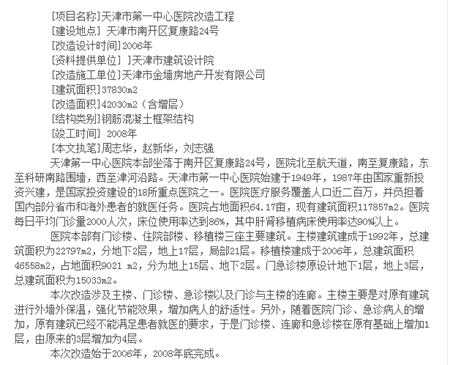
Figure 6.1: The Hospital Renovation Project Manual of Tianjin First Central Hospital, 2006
In 2006, the hospital had just completed the construction of its new transplant center building, which was meant mainly for liver and kidney transplants. However, they soon discovered that “with the increase of patients and emergency patients seeking treatment, the original building could not meet the demand. So one additional level was added to the original three-story building (please refer to the figure above). During that time, around 2,000 patients came to seek treatment every day, the occupancy rate of hospital beds reached 86%. For the liver transplant and kidney transplant divisions, occupancy rate of hospital beds was over 90%.
Based on the calculation method we explained previously, if the occupancy rate of hospital beds is over 90%, in 2006 when the renovation project was started, the transplant center should have completed 5,475 organ transplants (500 X 365/30 x 90%=5475).
Rome wasn’t built in a day. It was impossible for this hospital to reach such a high volume of organ transplants overnight. Therefore we believe when Phoenix Weekly reported on the transplants at this hospital at the end of 2005, the number of transplants was already as high as the 2006 level. It was just that the hospital concealed the real number to outsiders.
4) The hospital’s capabilities – a liver and kidney transplant team of up to 110 surgeons and the number of operating rooms – are staggering.
The WOIPFG published a list of 865 organ transplant hospitals and 9,500 transplant surgeons in 2014. Even so, Tianjin First Central Hospital’s number of transplant surgeons shocked us. Among the liver and kidney transplant surgeons alone, we found in medical theses that 110 had conducted surgeries, including 21 chief surgeons, 25 deputy chief surgeons,13 attending surgeons and 51 others.
The hospital’s organ transplant surgery center is able to perform 9 liver transplants and 8 kidney transplants simultaneously[523].
Such number of operating rooms and such total number of surgeons indicate that the hospital has at least 20 to 30 surgery teams to perform liver and kidney transplants. If the 17 operating rooms are used simultaneously, more than 30 liver and kidney transplants could be theoretically completed overnight – and the hospital likes to work at night. This means that the hospital can theoretically perform 10,800 cases (30×360 = 10800) of liver and kidney transplant per year. Even if the workload is only half of that, there would still be more than 5,400 cases per year.
Based on the above analysis, we believe that the number of liver and kidney transplants at this hospital reached more than 5,000 by 2006, and in recent years to the current day, it could exceed 8,000.
2. The PLA No. 309 Hospital Had Over 3,000 Kidney Transplants Every Year
The People’s Liberation Army’s No. 309 Hospital is very well known for its organ transplant expertise. The transplant center at this hospital was established in April 2002. In October 2005, it was named the PLA Organ Transplant Center by the PLA General Logistics Department of the Ministry of Health. In 2011, it was renamed PLA Organ Transplant Research Institute by the same department[524].
The PLA No. 309 Hospital is also the Data Center for the Management Committee of the Chinese Scientific Registry of Kidney Transplantation (CSRKT). CSRKT was established by the Ministry of Health[525]. The person in charge, Shi Bingyi, is an influential figure in the community of organ transplantation in China. He is also the vice chairman of the PLA Organ Transplant Professional Committee, and he has hosted the PLA Organ Transplant Conferences many times[526].
We calculated in our data revision report that the number of kidney transplants at the hospital at the end of December 2014 was 4,629—for which we did the calculation based on more than 200 transplants per year, after the establishment of the transplant center in April 2002.
However, after we found out that some hospitals had a much higher number of transplants, we analyzed the data for the PLA No. 309 Hospital again, and discovered that the actual number of kidney transplants exceeded 3,000 cases every year. The actual number of transplants is 15 times higher than the officially published data. In addition, this hospital confirmed that inside the CCP’s system, there are at least two ranking charts for the volume of organ transplants: one is the real data, and the other is manipulated data.
We made the aforementioned conclusion based on four deductive analyses. 1) Comparative analysis of all the data available; 2) The No. 309 Hospital ranked No. 1 in kidney transplants in China between 2007 and 2009; 3) The number of hospital beds and turnover rates are much higher than average hospitals; 4) There is a large number of transplant surgeons at this hospital. These four aspects confirm and support our overall thesis.
1)Based on public data of the 309 Hospital and our analysis, there were 968 kidney transplants in 2010 at this hospital.
In 2010, the hospital reported its volume of kidney transplants twice. In one report, the hospital claimed on the CSRKT website that “our hospital started the first kidney transplant operation on February 7, 1988. As of July 31, 2010, we have completed 1,888 kidney transplants.[527]”

Figure 6.2: The PLA No. 309 Hospital’s Introduction to Its Kidney Transplant Division on the CSRKT Website
In an updated report published on November 17, 2010, the official website claimed, “altogether we have completed 2,130 kidney transplants over the years.[528]”
Initially, we were hesitant to believe it because the number of kidney transplants had a big jump in three and half months. In our revision report, we had the following conservative statement: “Between the two reports there were four short months in which 242 kidney transplants were completed. At this rate, the annual transplants would be 726 cases.” We did not use this number as the annual volume, and our conclusion from this figure was that the increase in 2010 could be more than 300 cases.
In retrospect, the commonly seen data we obtained from 865 hospitals were annual data. A few hospitals reported their monthly data. None reported data in the middle of a month. That means, the first number by the PLA No. 309 Hospital was the number at the end of July 2010, and the second number should be at October 31, 2010. Based on these two numbers, the annual transplants would be (2130 – 1888) × 4 = 968 cases. Also, in Chinese hospitals, the website teams usually belong to the propaganda department, and they are not data entry professionals. So the reports usually come out after a lag. It is possible that the second number was for the time one month or two months after the end of July, which translates to 121 transplants or 242 transplants per month; and in a year, the number of transplants could be somewhere between 1,452 and 2,904.
2)The PLA No. 309 Hospital is self-proclaimed to be No. 1 nationwide three years in a row[529]. The number of kidney transplants must be higher than 460 cases per year.
On November 17, 2010, the PLA No. 309 Hospital claimed on its Organ Transplant Center Information web page that the hospital had been “No. 1 nationwide three years in a row.[530]”
Around the same time, on April 20, 2009, Tianjin First Central Hospital’s Organ Transplant Center self-proclaimed that "in the past nearly four years, the number of liver and kidney transplants we completed each year ranked first in China”[531], "368 cases of kidney transplants" in 2004, "436 kidney transplants” in 2005[532]. “As of June 2006, more than 1,300 cases of transplants.[533]” By the end of 2007, nearly 2,000 cases[534].
That means, between 2006 and 2007, the average is 460 per year.
These data indicate that the real number of kidney transplants at the PLA No. 309 Hospital must be more than 460 per year to be able to compare with the data reported publicly by Tianjin First Central Hospital. Our analysis above pointed out that, starting from 2006, Tianjin First Central Hospital’s kidney transplants exceeded 5,000 cases every year. It also claimed to be No. 1 in both liver and kidney transplants in China. Then, as the central organization for organ transplants in the CCP’s PLA system, the 309 Hospital cannot be so stupid as to claim to be No. 1 with its 200+ transplants when Tianjin First Central Hospital’s volume was more than 400 cases a year. There is only one explanation; that is, with the CCP system, there is a ranking based on real data. The 309 Hospital ranked No. 1 in kidney transplants, and Tianjin First Central Hospital ranked No. 1 in liver transplants.
3)Based on the number of hospital beds and turnover rates, it can be calculated that kidney transplant operations are between 3,000 and 4,000 a year.
The 309 Hospital’s Transplant Center was said to have “316 beds” and that “annual capacity and turnover rates are in the leading positions when compared with other divisions of PLA hospitals.[535]”
The 309 Hospital’s Transplant Center focuses on kidney transplantation. Tianjin First Central Hospital has revealed that its hospital bed turnover rate was over 131.1% in 2013. So as a conservative estimate, the 309 Hospital’s turnover rate could be 110% to 130%. The average hospitalization time for kidney or liver transplant patients is 30 days. So the number of kidney or liver transplants was approximately 4,172 to 4,998 cases per year (please refer to the calculation method in the previous section, for Tianjin First Central Hospital). The 309 Hospital focuses on kidney transplants and performs liver transplants on the side, so its volume of kidney transplants should be 3,000 to 4,000 cases per year.
4) With a large and skillful team, the PLA No. 309 Hospital’s capacity is theretically capable of preforming 3,000 transplants every year.
From the data analysis chapter, we learned that Xi’an’s Gaoxin Hospital was a second-tier private hospital in 2005, but it was able to perform 500+ transplants in the first two years with 6 or 7 surgeons, simply because they hired Shi Bingyi from the 309 Hospital as their Principal Consultant. The transplant team in the 309 Hospital is capable, and they have plenty of organ donors, so how could it be possible that the 309 Hospital had fewer operations than a small-scale private hospital?
By searching research papers published by the 309 Hospital, we found there were at least 42 doctors in the kidney transplant division alone. (Please refer to WOIPFG Releases the List of Medical Personnel Suspected of Extracting Organs from Living Falun Gong Practitioners http://www.upholdjustice.org/node/268) In addition, there are many interns, graduate students, trainees, and doctors from other hospitals, according to information on the hospital’s website, which read “60 graduate students were admitted to our institute, including 15 Ph.D. students and postdocs, 10 master’s program students. In the past five years, we also admitted 60 trainees for advanced study.” “We also provide training to Cambodia Wangjiajun General Hospital, PLA No. 307 Hospital, PLA No. 22 Hospital, Beijing No. 254 Military Hospital, Beijing No. 281 Military hospitals, and airborne troops 95944 Medical Team, etc.[536]”
Table 6.1: Major Surgeons in the Kidney Transplant Division of the PLA No. 309 Hospital
|
Teams |
Doctors/Surgeons |
|
Donor Extraction Team (12) |
QianYeyong, Shi Bingyi, Cai Ming, Mo Chunbo, Wang Yawei, Li Zhouli, Chang Jingyuan, Bo Hongwei, Zhan Shengli, Du Guosheng, Song Jiyong, Jin Hailong |
|
Chief Surgeons (4) |
Shi Bingyi, Cai Ming, QianYeyong, Du Guosheng (from the liver transplant team, but has the expertise of extracting organs from the donors) |
|
Deputy Chief Surgeons (12) |
Jin Hailong, Bo Hongwei, Zhan Shengli, Li Zhouli, Yuan Ming, Li Xiang, Wang Qiang, Li Gang, Wang Zhen, Chang Jingyuan, Dai Xin (from the liver transplant team, but has the expertise of extracting organs from the donors), Song Jiyong (from the liver transplant team, but has the expertise of extracting organs from the donors) |
|
Surgeons in Charge (4) |
Fan Yu, Mo Chunbo, Li Chao, Wei Xing |
|
Surgeons in Charge and Resident Doctors (22) |
XieJunjie (resident doctor), Wang Ke, Wang Yawei, Li Pengcheng, Chen Liping, Ouyang Yun, Du Yuan, Wang Hongyang, Yuan Qing, Xu Liang, Cui Hanwen, Liu Dezhong, Liu Kuili, Zhou Wenqiang, Wu Ruojun, Liu Lupeng, JiaJinfeng, Qi Baoyu, ZhengHuili, Han Mengxia, Li Kun, Zhang Chao |
There are 13 chief and deputy chief doctors who lead the kidney transplant team. This transplant center had once completed 12 kidney transplants in one night[537].
The doctors’ capacity at the 309 Hospital is 7 to 10 times more than Xi’an’s Gaoxin Hospital. The donor team and recipient team each have specific assignments in an operation, while at Gaoxin Hospital each of the six or seven doctors would need to perform both extraction and transplantation. In addition, as a well-known hospital, the 309 Hospital can easily attract many patients; while Gaoxin Hospital would have to go all out to find patients. Based on the capacity of the team, if there are plenty of donors, this team can easily perform 2,100 to 4,000 transplants a year.
5) We believe the PLA No. 309 Hospital ranked No. 1 in kidney transplants.
To summarize based on the above analysis, we come to the only reasonable conclusion, which is that the PLA No. 309 Hospital ranked No. 1 in kidney transplants between 2007 and 2009. The data published by the hospital website and related information have been meticulously manipulated, with a year-to-year increase of about 200 cases.
However, what shocked us is not the repeated fraud on numbers, but that so many people in the CCP knew about the live organ harvesting while still showing off their results.
With the above reasons, we would then understand why so many hospitals have claimed at the same time that their own transplantation of a particular organ type is the No. 1 in the country (In April 2009, Tianjin First Center Hospital claimed to be No. 1 in liver and kidney transplants in the country for the past four years), or the province/city[538]. This is because China has at least two ranking lists for organ transplants—one is true and the other is modified.
6)The number of kidney transplants publicly reported by the 309 Hospital is fake: There was a big drop after 2006, from 328 a year to 160 a year, but it was not a real drop.
First of all, we need to specify that for the Transplant Center, after its founding in April 2002, the reported number of transplants did not include the 1,100 operations before its founding:
“Our hospital had 265 kidney transplants between 1988 and 1994.[539]”
“When the transplant center was just founded, the Department of Urology has accumulated clinic experience from 1,100 kidney transplants.” The Medical Journal of Chinese People’s Liberation Army, first issue of 2008[540] and Xinhua News[541] both had reports on this.
A report in Medicine Economic News, August 13 of 2006, said: “So far, the transplant center has completed more than 1,420 kidney transplants.[542]”
Comparing these two numbers, it can be calculated that between 1995 and April 2002, there were 114 kidney transplants every year. If the 1,420 cases included the 1,100 operations before the Transplant Center came into existence, the average number of kidney transplants was 75 cases per year [(1420 – 1100) / 4.25 = 75], which would be a great discrepancy with the explosive increase nationwide after 2000. It was also inconsistent with the tremendous growth after the Transplant Center was established. Therefore, the second number does not include the 1,100 cases before the center was established.
Therefore, between April 2002 and July 2006, there were 1,420 transplants according to public data; on average, the center performed 328 kidney transplants a year.
Secondly, the public data from this hospital had a sudden drop after 2006.
Public data from this hospital showed, up to December 2014, that it had completed 2,766 kidney transplants: “have completed accumulatively 2,766 kidney transplants and 603 liver transplants”[543], but this report was later deleted from the website. However, these data were quoted by the Hospital Experts website, in an article introducing the Transplant Center[544]. The 309 Hospital website published an article from The People's Political Consultative Daily which had the interview with Shi Bingyi, a surgeon at the 309 Hospital. The deleted data can also be confirmed by this interview with Shi, who said, “Between 1988 and 2014, we completed more than 2,700 kidney transplants.[545]”
That is, starting from August 2006, the PLA No. 309 Hospital performed an average of 160 kidney transplants per year. (2766 – 1420) / (8+5/12) = 160.
Did the annual number of kidney transplants really drop after August 2006? In September 2014, Shi Bingyi wrote in his research paper “Risk factor analysis after Kidney Transplants in Cardiovascular Patients,” which was published in the PLA Medical Journal, “We revisited and analyzed the 1,106 cases in which the patient who had cardiovascular diseases received kidney transplant at the 309 Hospital between May 2009 and November 2013.” That means, there were 245 such patients a year who “had cardiovascular diseases.” The total number of transplants must be higher than 245 per year[546].
It can be seen that the data after 2006 have been manipulated; the fabricated data tell the outsiders that each year, the number of transplants is about 2,000 more than the previous year. However, when we put all the information together, it became obvious that these public data are lies. Just as Chinese writer Li Chengpeng said sarcastically about the CCP’s media: “Our newspaper is correct every day, but it would be really embarrassing if we have a one-volume edition which includes the issues from all these years.”
So is it that after the 1,420 cases published in Aug 2006, the figure suddenly dropped? No. Shi Bingyi and others confirmed in their paper titled “Analysis of risk factors on patients with cardiovascular disease after kidney transplant”, which was published on the Medical Journal of Chinese People’s Liberation Army in September 2014 that “An retrospective analysis on 1,106 cases conducted at the PLA No. 309 Hospital between May 2009 and November 2013 that are eligible for inclusion”. The number of the selected transplant cases was 245 per year. So the actual kidney transplant figure must be bigger than the “selected ones that are eligible for inclusion” [547].
If we do not look at the transplant figure of 1,420 cases published in August 2006 that caused other years’ annual figures to appear strange, but only look at each year’s published total, then it can be seen that the published figures after 2006 were modified, each year’s increase is changed to roughly more than 200 cases.
3. Peking University People’s Hospital once performed 4,000 kidney transplants in one year
In September 2013, Zhu Jiye, the head of Peking University Organ Transplantation Research Institute and the director of the Hepatobiliary Surgery Department at Peking University People’s Hospital said in an interview with China Economic Weekly, “Prior to launching the pilot project in 2010, the organs from executed prisoners accounted for almost all donor organ sources in China. Our hospital used to perform 4,000 liver and kidney transplants within one year, and the sources of these organs were all death-row prisoners.[548]”

Figure 6.3 September 2013, “Xinhua Network” article snapshot
The hospital claimed on its official website on July 16, 2014 that it became one of the first Grade A Class 3 hospitals designated by the Ministry of Health to perform kidney transplants in 2007, and that it performed 80-90 transplants every year[549]. Since the hospital started performing liver transplants in 2000, it has performed more than 600 cases of liver transplants[550], with an average of 40 liver transplants per year.

Figure6.4 July 2014, Peking University People's Hospital Cached
Our previous conservative estimate of the total number of kidney transplants was 2,435 over a span of nearly 15 years, with an annual average of only 162 cases. Yet the 4,000 a year figure suggests that the hospital has the capability of performing organ transplants at 24 times the rate of our estimated number based on the information made public by the hospital.
4. Wuhan Tongji Hospital performs thousands of kidney transplants each year
An article first published on KwongWahYitPoh and later reproduced by China’s Sina Global News states that as an important city in central China, Wuhan is also reportedly China’s largest organ transplant center. The most famous local organ transplant hospital is the Wuhan Tongji Hospital, which is one of China’s earliest and most authoritative hospitals that perform live donor kidney transplants. Every year, the hospital performs thousands of kidney transplant surgeries. The hospital’s website claims to have the largest group of living donor kidney transplant recipients (i.e. patients receiving kidney transplants)[551].
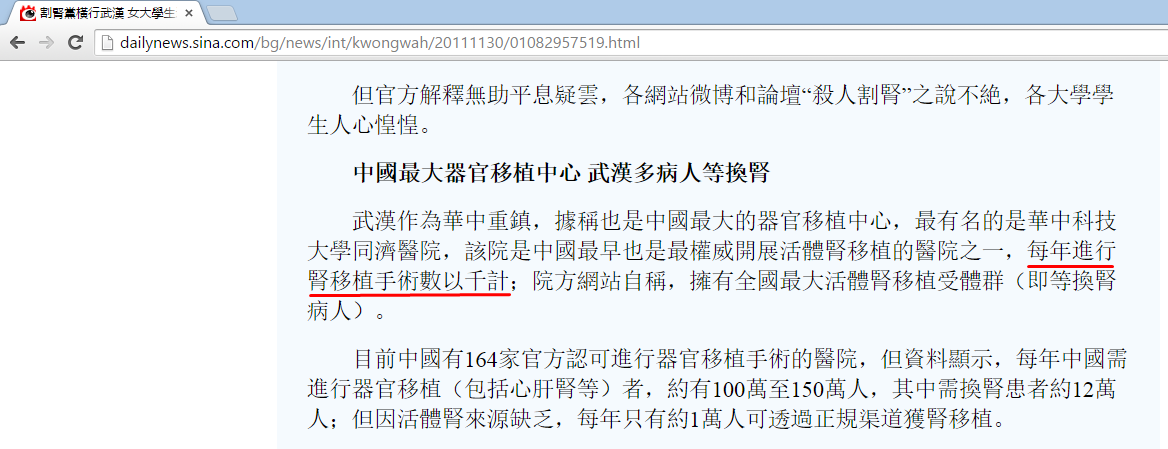
Figure 6.5 November 2011, "Sina Global News" article Snapshot
During our investigation, a surgeon from this hospital admitted that “there is guaranteed to be sufficient live prisoners like Falun Gong practitioners.[552]” He also mentioned that “before the people (i.e. donors) die, the organs are taken out.[553]” One surgeon’s relative who works at this hospital said that there were many donors, and before the crimes of organ harvesting were exposed, the surgeons would work overtime every day to perform organ transplants.
We have previously calculated the number of kidney transplants at this hospital in a conservative way with publicly available information. According to the calculation, after the year 2000, the hospital performed 3,110 cases of kidney transplantation, with an average of 207 cases per year. However, the hospital’s actual annual transplant number is more than a dozen times that of the kidney transplant number we obtained from our calculation.
“Several thousands”,based on Chinese language interpretation, should be more than 3000, perhaps as high as 8000 to 9000. But to be on the conservative side, we will base on 3000. However, since this hospital claimed to be the “largest” organ transplant operation center in the whole country, and take into consideration of the 4000 cases performed by the previously listed Peking University People’s Hospital; and later we discovered the 5000-8000 cases performed by the Tianjin First Central Hospital; and the 3000-5000 cases performed at the 309th Hospital of the Chinese PLA, we believe the Wuhan Tongji Hospital actually performed even larger number of transplants.
5. The Asia-Pacific Journal: Japan Focus confirms that Suzuki Masanori, the president of the Japan Transplant Recipients Organization, has Discovered a Chinese hospital with an Extremely High Volume of Transplants that Caters Specifically to Japanese Organ Tourists.
David McNeill is a Japan Focus coordinator and writes about Japan for the London Independent and other publications. Clifford Coonan is the Independent’s correspondent in Beijing. On April 4, 2006, they published an article titled “Japanese flock to China for organ transplants” on Asia Times. The article stated: “Last May, Suzuki visited a hospital in a ‘major city’ (he declined to specify which city) and learned that 95% of its transplant patients had received organs from executed prisoners. The hospital had conducted 2,000 organ transplants last year alone, Suzuki said”[554].
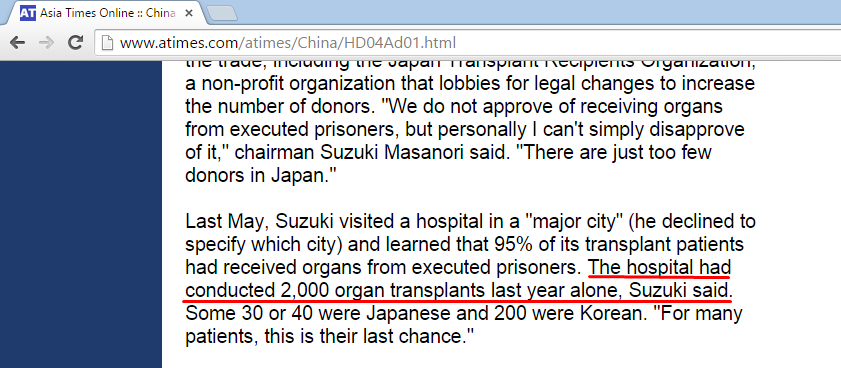
Figure 6.6 April 2006, "Asia Times" article Snapshot
Based on our analysis, the hospital mentioned by Mr. Suzuki should be the First Hospital of China Medical University. This hospital has established an “International Transplant (China) Network Support Center” in 2003, it is located in the Transplant Research Institute of the First Hospital of China Medical University. The organization is dedicated to provide transplant services for foreigners. Most of them were from Japan, and it even has a Japanese language website and advertises on the Internet. After the organ harvesting of Falun Gong practitioners was reported in 2006, the website was removed.
1) Waiting time for organ transplants is extremely short in this hospital
“A liver transplant usually takes, only one month, waiting for around 2 months considers to be the slowest. For Kidney transplants, a HLA matched donor can be found within one week, the longest waiting time is no more than one month. Donors are selected through a variety of rigorous examinations, if in any case their physical condition is abnormal such as fatty liver at the time when their kidney is removed, the surgery will be canceled before the patient’s abdomen is cut open. The center will be responsible for finding a donor for this patient and conducting the transplant again within one week.[555]”
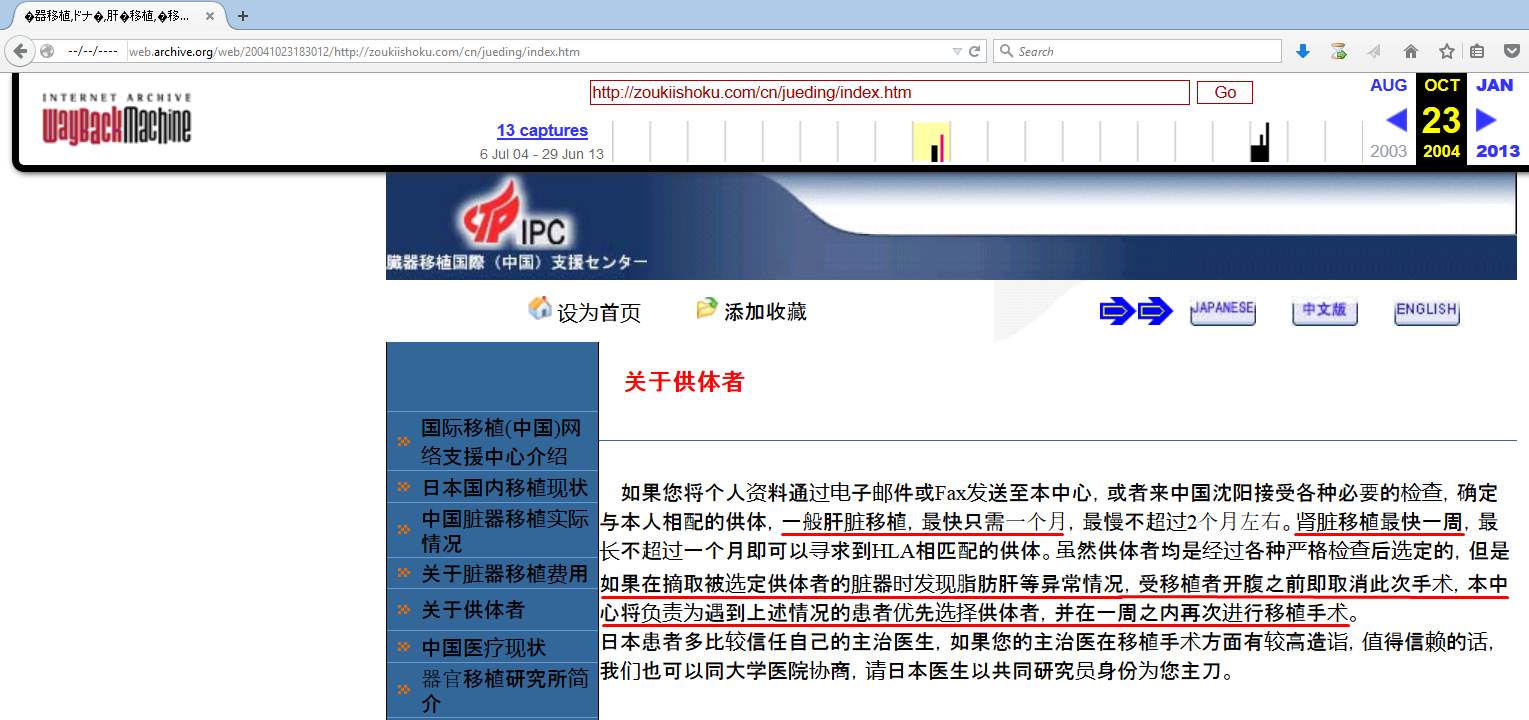
Figure 6.7: Archived International Transplant (China) Network Support Center October 2004’s Webpage
2) The hospital has living donors, its September 2004 archived webpage shows:
a) Good quality organs, living donor: “kidney transplant in this hospital is safer and more reliable compared to cadaveric kidney transplant in Japan.”
b) “China’s living donor kidney transplants is totally different with cadaveric kidney transplants you learn from Japanese hospitals and dialysis centers. [556]”
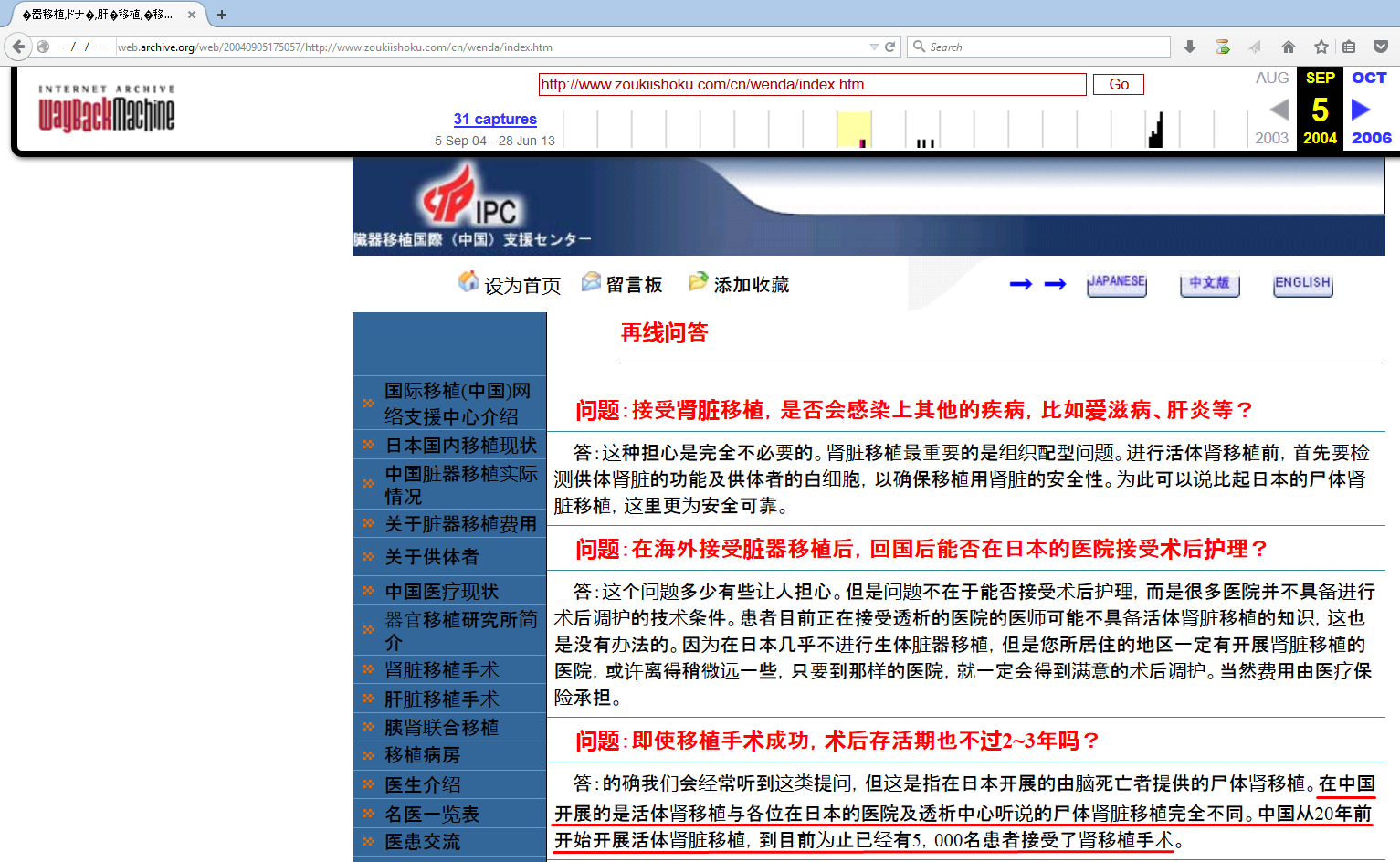
Figure 6.8: Archived International Transplant (China) Network Support Center September 2004’s Webpage
c) The hospital provide special and customized services for Japanese patients
Because the sufficient similarities exist between Japanese and Chinese physique, most patients for our center came from Japan. The Transplant Research Institute had several doctors and head nurses who were educated in Japan, and were very familiar with Japanese culture. Most of the nurses speak Japanese, providing further convenience for Japanese patients. All patients will move into inpatient ward reserved for senior officials to receive further post operation care[557].
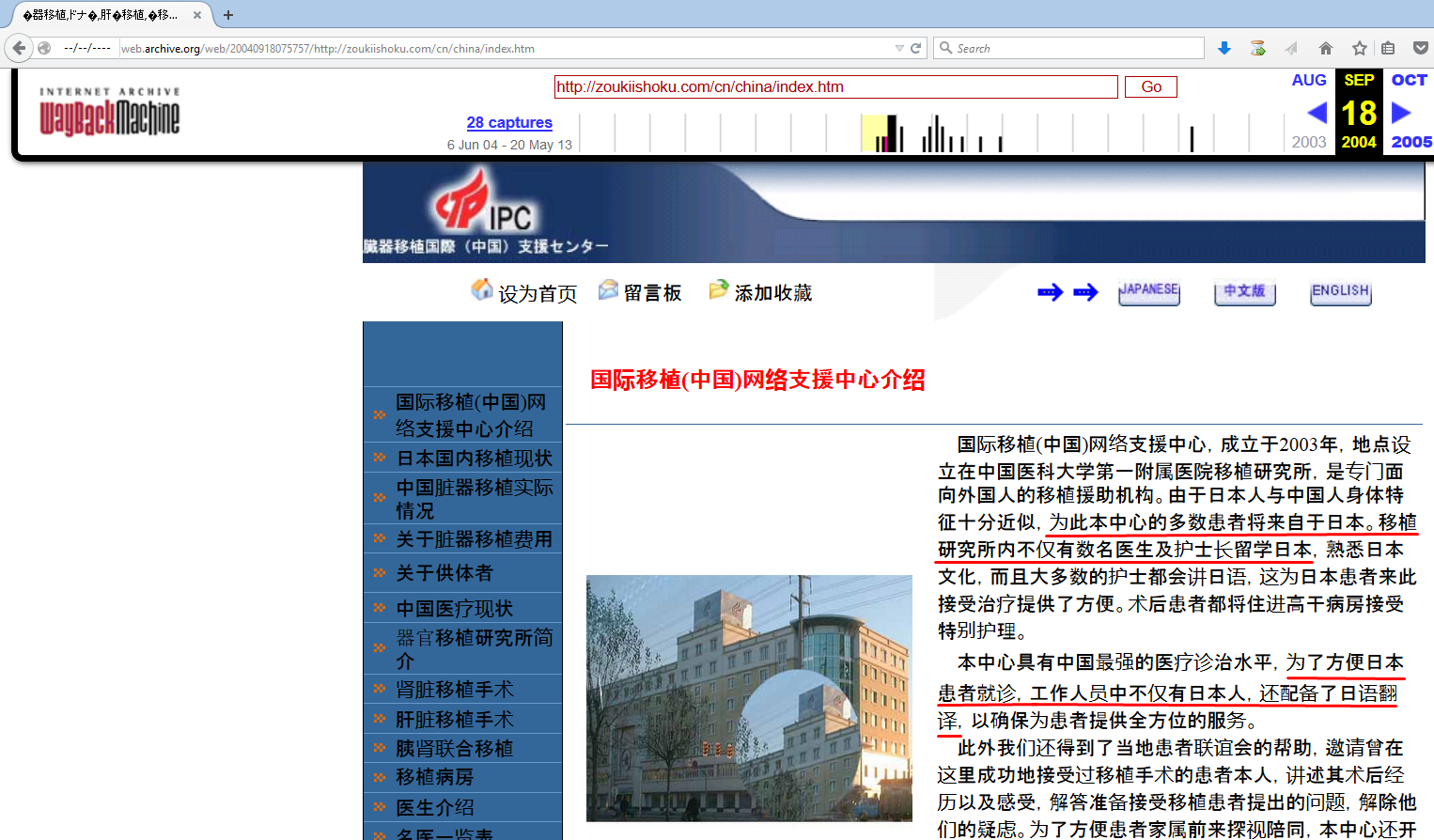
Figure 6.9: Archived introduction webpage for International Transplantation (China) Network Support Center in September 2004
4) This hospital acknowledges organs from the CCP’s government
The hospital “can completed such amount of organ transplants because of the support of the Chinese government.” “Providing organs is one link of support from the government”[558].
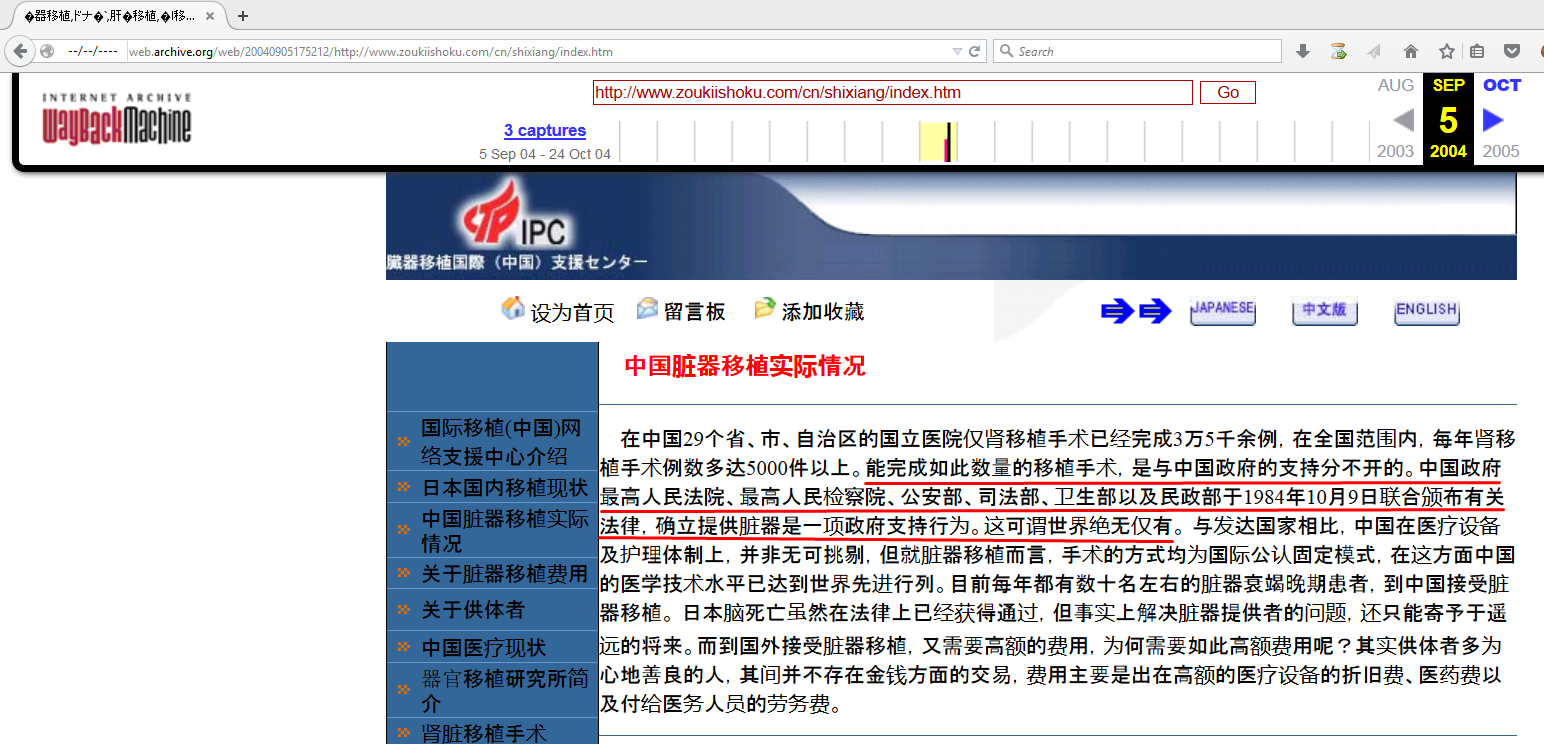
Figure 6.10: Archived introduction webpage for International Transplantation (China) Network Support Center in September 2004
5) This is a Model Hospital for the Foreign Transplant Market
a) Previous evidence demonstrates that the amount of kidney transplants at this hospital is huge, all transplanted kidneys are from living donors and from Chinese government;
b) Tang Junjie, Deputy Secretary of Politics and Law Committee in Liaoning Province, acknowledged after that Bo Xilai has been in charge of organ harvesting from alive Falun Gong practitioners after he received orders from the CCP’s Central Standing Committee. As one of the most important hospitals in Liaoning Province, this hospital is inevitably involved and becomes one of the main hospitals (doing this) (see Chapter Two, evidence three);
c) This hospital has participated in organ transplant experiments in a large scale. Wang Lijun, former Deputy Mayor of Chongqing City, established China’s only Psychological Research Center whose primary goal is organ transplantation experiments while he was Director of Jinzhou City Public Security Bureau, Liaoning Province. Liu Yongfeng, Zhang Jialin, Wu Gang, Liu Shurong, Li Guichen and etc who work at First Affiliated Hospital of China Medical University. Thousands of organs were transplanted in over 2 years at this center. Since it is impossible having so many executed prisoners in small Jinzhou City, the center’s living donors can only be Falun Gong practitioners. (See Chapter VII).
d) This hospital is very strong technically, it belongs to the first batch of hospitals who are able to conduct multiple organ transplant surgeries approved by the Ministry of Health, and also it is the organ transplantation quality control center in Liaoning Province. Organ transplantation laboratory is Liaoning Provincial Key Laboratory[559].
e) This hospital has a large number of staff whose has strong comprehensive skills and at least four kidney transplant teams. In 2004 alone, “many doctors were trained at well-known organ transplant centers in the United States, Canada, Japan, Germany, the Netherlands, Australia, Hong Kong and Taiwan. 4 professor / associate professor have 8 to 11years clinical experience, 9 attending doctors have average 4 to 6 years clinical experience. [560]”
In 2011, “at present, there are 57 medical staff members, including 3 professors, 8 associate professors.17” As long as organ demand and donor supply are adequate, this number of kidney transplants can be achieved. [561]”
f) Hospitals who annually can complete almost 1,000 cases of kidney transplants came into being around the year 2003, 2004.
Witnesses revealed concentrated camps detained Falun Gong practitioners located at Sujiatun, Shenyang City. A senior military doctor exposed concentrated camps located in Northeast region. There are large numbers of Falun Gong practitioners in Northeast region. Therefore, lots of them are detained at prisons around that area;
g) As soon as the facts of organ harvesting was exposed, this hospital deleted its website immediately. It proves there is a high awareness of it’s international standing;
h) Generally other hospitals conduct about 100 cases of organ transplants when donors were actually executed death-row prisoners (no advertisement is necessary at that time. A breakthrough happened after the period of 2000 to 2001, the number reach 300 to 500 cases per year - see Nanfang Hospital);
i)This hospital launched a large campaign of organ transplant advertisement in Japan. Moreover, it is equipped with a large number of doctors and nurses who can speak Japanese.
This hospital’s official website claims that “the Institute of Organ Transplantation is established in 2002, approved by Shenyang City Multiple Organ Technology Research Center, and named Liaoning Province Key Laboratory of organ transplantation. “In the past five years, (this hospital) operated hundreds of various organ transplants surguries annually. In 2002, the Institute of Organ Transplantation is established[562].
Therefore, the hospital is suspected transplanting over 2,000 organs in 2005, 20 times more than the so-called public number on its official website. We found no evidence of any let-up in this rate over time.
6. Southern Hospital Suspected of Performing More Than 1,000 Liver and Kidney Transplants in 2004 Alone
The First Affiliated Hospital of The First Army Medical University of the Chinese People’s Liberation Army was turned over to Guangdong Province in August of 2004, and renamed The Affiliated Southern Hospital of The Southern Medical University[563]. In March 1995, this very hospital was given the honorary title of “Exemplary Medical Care that Benefits Overseas Chinese” by Jiang Zemin. It was the army’s sole “Foreign Medical Center” and a convenient instrument for the CCP to bring overseas Chinese and foreign countries around the world to a united front via the utilization of organ transplantation. Before the end of 2006, “(It) had already admitted nearly 70,000 patients from more than 70 countries and regions for hospitalization and physical checkups.[564]”
On May 23, 2007, the Ministry of Health designated this hospital as a center for kidney and liver transplantation[565].
In 2004, the provincial government of Guangdong announced that the hospital was a center for Grade A kidney transplants, Grade A liver transplants, and Grade B heart transplants[566].
1) According to the testimonial of Bai Shuzhong, the Minister of the People’s Liberation Army’s Department of Health in General Logistics, this hospital was the main force in the army for live organ harvesting.
BaiShuzhong served as the Minister of the People’s Liberation Army’s Department of Health in General Logistics between 1998 and 2004. During a telephone investigation conducted by the WOIPFG, Bai admitted that during his tenure, Jiang Zemin had personally ordered live organ harvesting from Falun Gong practitioners. The Medical College’s Affiliated Hospital is the army’s main force that executed this order from Jiang Zemin (for transcription of the recording and the download link for the audio clip, please refer to section 1 in Chapter 2 of the report)[567]. Under the CCP’s rule, once Jiang Zemin had given his commands, this hospital would spare no effort to carry out the bloody mission.
“It was Chairman Jiang at that time.” “There was a memo and instruction that is,” “to carry out this matter, which was organ harvesting.” He also claimed: “(It) could be managed by our handful of medical colleges. Several medical colleges affiliated with our General Logistics work units had repeatedly requested so, because at that time Jiang paid a lot of attention to this issue. He attached a great deal of importance to it.”
2)Public figures from the hospital disclosed that between December 2001 and August 2003, new kidney transplants averaged 501 cases per year. Taking into consideration compound annual growth rate, by 2004 the number of kidney transplants would likely reach 1,000 cases per year.
i. In August 2003, the Yangcheng Evening News reported that Yu Lixin, a person in charge of the hospital’s kidney transplant center, claimed: “From the first ever human kidney transplant surgery successfully completed in 1978 to August 2003, more than 3,000 kidney transplants were conducted. In recent years, kidney transplant surgeries averaged about 250 per year.[568]”
ii. In his thesis paper “Progess of the Clinical Allograft Renal Transplantation in Our Country” published in Armed Police Medical Science in 2004, Yu Lixin claimed that his hospital had completed 2,123 kidney transplants, as early as November 2001[569].
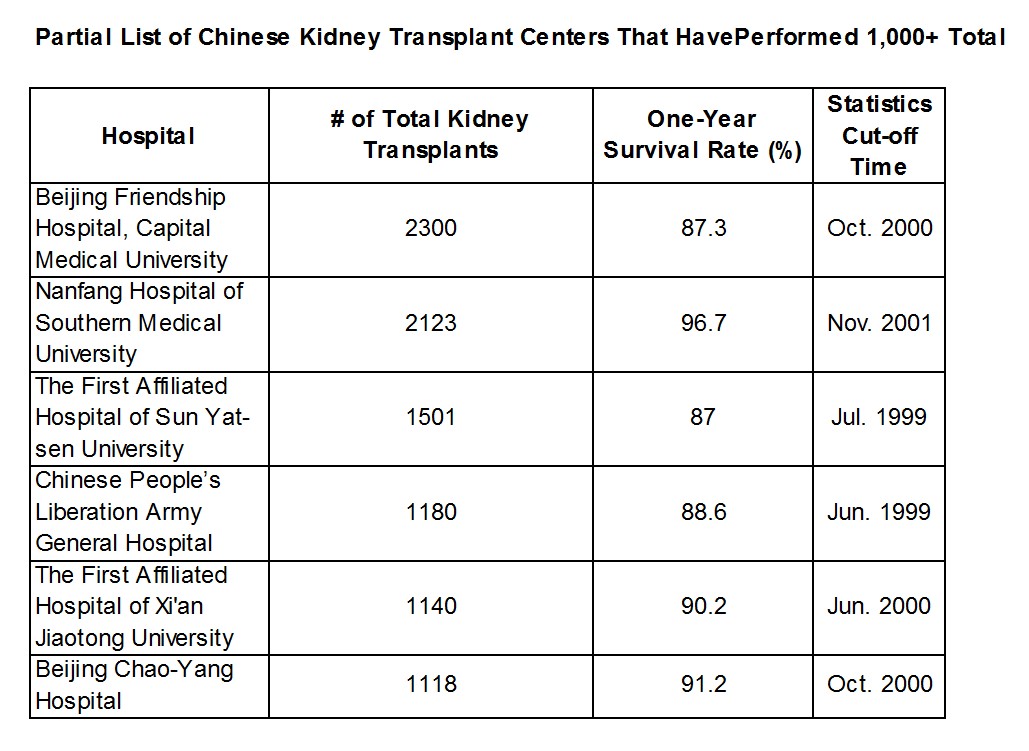
Figure 6.11: Overview of transplant surgeries in selected Chinese hospitals that performed more than 1,000 kidney transplants
iii. From the statements above, we conclude that between December 2001 and August 2003, new kidney transplants exceeded 877 in 1 year and 9 months at this hospital, with an average of more than 501 per year.
iv. From April 1978 to January 1997, this hospital performed 1,051 cadaveric renal transplants[570]. From statements above, we could conclude that between February 1997 and November 2001, the number of kidney transplants at this hospital was 1,072—which was 222 cases per year on average.
v. Keeping in mind that organ transplantation in China experienced an explosive growth in year 2000, we hoped to find the average annual growth rate prior to it. At that time, the main source of organs came from death-row inmates. The annual figure was pretty stable. According to an article by Yu Lixin, “Our Hospital Has Performed 444 Cadaveric Renal Transplants from January 1991 to Present” published in the Journal of Nephrology Dialysis & Transplantation, Vol. 6 1995, and taking into account the fact that most article submissions are due 2 months before publication, we could conclude that the average number of annual kidney transplants between January 1991 and April 1995 for this hospital was 102 cases.
From this we could deduct that by December 1999, the number of kidney transplants at the hospital was 1,349. Therefore, the annual compound increase rate from January 2000 to November 2001 (2,123 cases) is 26.69%. We could further conclude that by the end of 2004, the transplant volume would reach 1,000 cases per year.
Table 6.2 : Southern Hospital’s Renal Transplant Volume by Year, with an Annual Compound Growth Rate of 26.69%
|
Year |
1999 |
2000 |
2001 |
2002 |
2003 |
2004 |
2005 |
|
Annual New Cases |
102 |
360 |
456 |
578 |
732 |
928 |
1,175 |
|
Grand Total |
1,349 |
1,709 |
2,165 |
2,743 |
3,475 |
4,403 |
5,578 |
vi. Taking in consideration that in 2000 the massive organ harvesting among Falun Gong practitioners for transplant surgeries had just began, the actual annual compound increase rate should be more than 26.69%. We believe that by 2004, the number of kidney transplants could have exceeded 1,000.
3) The organ transplant team in the hospital includes 6 to 7 kidney teams and 4 to 6 liver teams.
The transplant department at the hospital is very strong. For the kidney and liver transplant centers alone, we obtained direct evidence that led to 48 physicians who performed liver or kidney transplants. There are six to seven kidney transplant teams and four to six liver teams.
Table 6.3: Number of Physicians Involved with Liver or Kidney Transplants in Southern Hospital
|
Transplant |
Transplant Surgeons |
Chief Physicians |
Deputy Chief Physicians |
Attending Physicians |
Other Physicians |
|
Kidney |
21 |
1 |
6 |
3 |
11 |
|
Liver |
27 |
4 |
2 |
4 |
16 |
4) We believe that as late as 2004, the annual kidney transplant surgeries performed at this hospital had exceeded 1,000 cases.
Following the reasoning above and taking into account the following factors:
A.After 2000, the organ transplant volume exhibited an explosive growth, not an average increase, nationwide in China.
B.Between December 2001 and August 2003, within 1 year and 9 months, the number of kidney transplants at the hospital amounted to 877, with an average of 501 cases per year.
C.Beginning in December 2001, the average number of transplant surgeries surged to an increase of 125% at its minimum, compared to previous years. The annual compound increate rate was at least 26.69%.
D.This hospital is the major force in the army that executed Jiang Zemin’s killing order.
E.This hospital has a powerful transplant team structure.
F.This hospital maintained a No. 2 national ranking in terms of kidney transplant volume for a long period of time (after the Chaoyang Hospital. Please refer to the figure from Yu Lixin’s thesis paper).
We conclude that the number of kidney and liver transplants performed at the Southern Hospital well exceeded 1,000 cases by 2004, at its latest.
The following fact serves as circumstantial evidence to support our analysis above:
G. The Nanjing Main Hospital in Nanjing Army District is a self-proclaimed research institute that does not regard surgery as its main focus. However, its kidney transplant surgeries exceeded 1,000 cases in 2004.
7. Central South University’s Xiangya Hospital: The hospital’s transplant figures released to the public are significantly lower than those reported by state media. This national organ project center is suspected of acting as the CCP’s organ deployment center.
This is a Grade A Class 3 hospital[571]. On May 23, 2007, this hospital was appointed by the Ministry of Health to develop liver and kidney transplant programs[572]. In December 1992, the hospital began its test operation. In August 1996, it was fully opened to the public. Currently the hospital’s featured programs are Transplant Medicine and Minimally Invasive Medicine[573].
On September 18, 2003, the Public Health newspaper reported that the Hunan Transplantation Medicine Engineering Research Center was established in Xiangya Hospital. In 2005, the Xinhua News Agency reported that Xiangya Hospital was promoted to be the first Transplantation Medicine Research Center in China. In April 2006, a new building for the Ministry of Health’s Hepatobiliary and Enteric Surgery Research Center broke ground in the Xiangya Hospital in Changsha. In recent years, the name “Changsha Xiangya” has become a dark horse that suddenly emerged in the transplantation industry in China.
1)The transplant numbers published on the hospital’s official website are far below those reported by the CCP’s state media. The year before 2003, this hospital had already reached the capacity of performing 400 kidney transplant surgeries.
Thesis papers published by the hospital and its official website all reported a relatively lower number for kidney and liver transplants, 100 cases per year at the most.
a)Kidney Transplant: 321 kidney transplants performed between January 1998 and May 2003[574].
b)1,238 different kinds of kidney transplants completed between January 2001 and April 2011[575].
c)Liver Transplant: 260 piggyback liver transplants completed between January 2001 and April 2006[576].
However, reports from the CCP’s state media and the campus newspaper revealed that the actual transplant numbers are large:
d) The Ministry of Health’s Transplantation Medicine Engineering Research Center (abbreviated as “the Center” from here on) was first discussed among an expert panel formed by the Ministry of Health, later approved by the Ministry of Health, and then formally established in Central South University’s Xiangya Hospital. “After three years of development, the Center has carried out several hundreds of piggyback liver transplants and over 1,000 kidney transplants. In addition, more are under way, including combined liver and kidney, liver and pancreas, pancreas and kidney, and other combined multi-organ transplantation, spleen transplant, pancreas transplant, heart transplant, split and relatives liver transplant, as well as thyroid and parathyroid transplant, and cell transplantation of liver, spleen and pancreas.[577]”
e) The same figure could also be found in the old version of Xiangya Hospital’s official website: “After three years of development, the Center has successfully completed several hundred cases of piggyback liver transplants and more than a thousand kidney transplants. Among them, the total number of piggyback liver transplants and its survival rate play a leading role in the country.[578]”
f) In August 2001, Xiangya Hospital finished construction of the Hunan Transplantation Medicine Center building[579]. On its official sign-posting day, the Xinhua News Agency published a news report on September 19, 2003, “The Deputy Minister of Health Held the Scalpel Himself for a Liver Transplant at Central South University”: “Within three years, (the Center) has completed 300 liver transplants and 600 kidney transplants. On this day, the Center made a special arrangement for 7 liver and kidney transplant operations. What Huang Jiefu operated on was a liver transplant surgery.[580]” According to this report, more than 200 kidney transplants and over 100 liver transplants were conducted every year at that time.
However, in actuality, our investigation revealed that the time lapse between August 2001 when the transplant center was first built and September 18, 2003, when Huang Jiefu attended the sign-posting event, was less than 2 years and 2 months. In addition, “In October 2002, the nationally known transplant expert and professor Ye Qifa led an 8-person transplantation expert team to join the Xiangya Hospital.[581]”
Without doubt, it was only after the arrival of Ye Qifa that the power of the organ transplant center strengthened. As a result, the real transplant numbers surged. It should have occurred in the window between October 2002 and September 18, 2003, a mere one-year period. Therefore, under the most conservative estimates, the average number for liver transplants might have reached 200 cases per year, and 400 per year for kidney transplants.
Huang Zufa, the president of Xiangya Hospital, also emphasized the vital role of Ye Qifa’s team, during his interview with the Central South University newspaper’s reporter: “In 2002, led by organ transplant expert and professor Ye Qifa, 8 high-level organ transplant experts joined our hospital…”; “Up till now, we had already carried out heart, liver, kidney, islet cell, hempatopoietic stem cell, and small intestine transplant surgeries”; “In our hospital, we had simultaneously performed 2 liver and 5 kidney transplant surgeries. We have the capability to operate 6 or 7 transplant surgeries at the same time. The annual operations reached more than 200.[582]”
The president’s declaration of more than 200 kidney transplants per year may have been a result of averaging the numbers over a longer period of time in order to cover up the truth.
2)The potential of this hospital is enormous. It has the facility and personnel to perform over 1,000 organ transplants every year.
Affiliated with Xiangya Hospital, the Transplantation Medicine Research Center spent 80 million yuan to establish an 8-thousand-square-meter building solely for transplantation purposes, as early as August 2001. There were special care units with advanced facilities and 150 beds in the building[583]. From the number of beds, we could estimate that the hospital has the potential to perform 1,800 liver and kidney transplant surgeries every year.
The hospital has a stong transplant team. The Centre has more than 20 professors, associate professors, and nearly a hundred doctors, nurses and technical staff[584]. The hospital is capable of conducting at least seven surgeries at the same time. Xinhua News reported on September 19, 2003 that "Vice Minister of the Ministry of Health conducted liver transplant at Central South University”: In the past three years, it had completed 300 cases of liver transplants, and 600 cases kidney transplants. On that very day, the transplant centers had arranged seven liver and kidney transplants. Huang Jiefu did a liver transplant[585].
3)The hospital is suspected to have acted as the CCP’s organ deployment center.
Affiliated with Hunan Daily, the Public Health newspaper[586] reported on September 24, 2003, that Huang Jiefu had delivered a speech at Xiangya Hospital about building an organ deployment network and mentioned the centralized detainment of organ sources and building a deployment center: “At the Hunan Transplantation Medicine Engineering and Research Center established on September 18, gradually develop a management network at the provincial, regional and national level, to play a vital role in terms of information sharing, resource optimization and allocation. In addition, the increasing volume of operations will advance the technological development of the entire transplant society. More importantly, the controlled organ source market drives transplant surgeries that greatly reduce the patients’ medical cost. Transportation of organ sources is not needed and this will cut the operation cost down by half. The quality of the transplant will also improve greatly because the waiting time is shortened.”
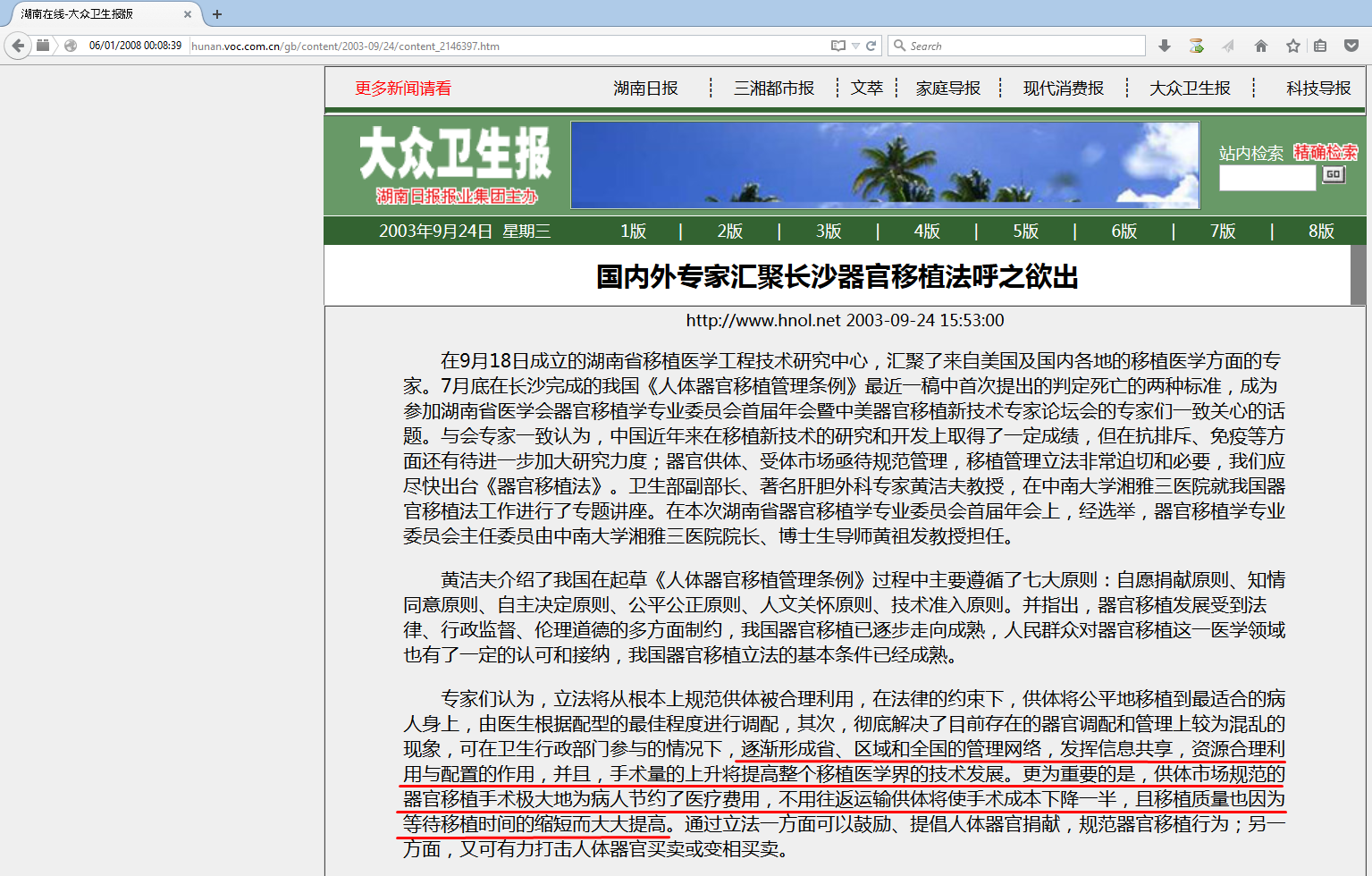
Figure 6.12 September 2003, public health newspaper webpage Cached
According to the analysis, the Ministry of Health, joined by the army, set up several large organ banks nationwide in China. However, in order to deploy and coordinate these organ banks to fully utilize their potential, there needed to be a national deployment center. It was highly likely that the Xiangya Hospital, with its leading position in the organ transplant industry, had acted as the national organ deployment center. Otherwise how could it dare to declare, “Transportation of organ sources is not needed and this will cut the operation cost down by half”?
8. Zhongshan Hospital, affiliated with Fudan University: Before the 2007 institutional anniversary, the transplant volume maintained a rapid upward growth; Starting in 2008, the number stopped refreshing on the website, and data was tampered with; Physicians openly admitted to using Falun Gong practitioners’ organs; The hospital is suspected to have done several thousand liver transplants per year.
On May 23, 2007, the hospital was appointed by the Ministry of Health to perform liver, kidney and heart transplant surgeries[587]. It was the only hospital in Shanghai to obtain certification for heart, liver and kidney transplants all at once. On October 30, 2001, the Organ Transplant Center was established[588].
1)The hospital has a strong transplant team
a)27 kidney-transplant doctors, 6 high-ranking (chief physician or professor), 5 deputy chief physicians
b)10 high-ranking (chief physician or professor) liver-transplant surgeons, 9 deputy chief physicians
c)Heart surgeons, 3 are high-ranking
d)At least 6 kidney-transplant teams, 10 liver-transplant teams, 3 heart-transplant teams
2)The large volume and rapid growth-rate of transplant surgeries at the hospital is shocking. Before September 22, 2007, media and hospitals made the following statements:
a) The Sina online media reported in December 2003: The total number of organ transplants at Fudan University’s Organ Transplant Center has reached 100 cases per year, with an annual growth rate of 50 percent. On December 8, 2003, it cooperated with the world’s largest organ-transplant institute and cofounded the “Fudan University Zhongshan Hospital—US Pittsburg University Thomas E. Starzl Collaborating Transplant Research Center.” It claimed it was “looking forward to reaching new milestones in the area of organ transplantation.[589]”

Figure 6.13 December 2003, Sina news webpage Cached
b)In August 2006 (article submitted on February 10), Qin Xinyu, Fudan University Zhongshan Hospital’s party secretary, vice president, and director of general surgery, published a paper in Chinese Hospitals stating that at the time, major organ transplant operations on heart, lung, liver and kidney had reached about 400 cases[590].
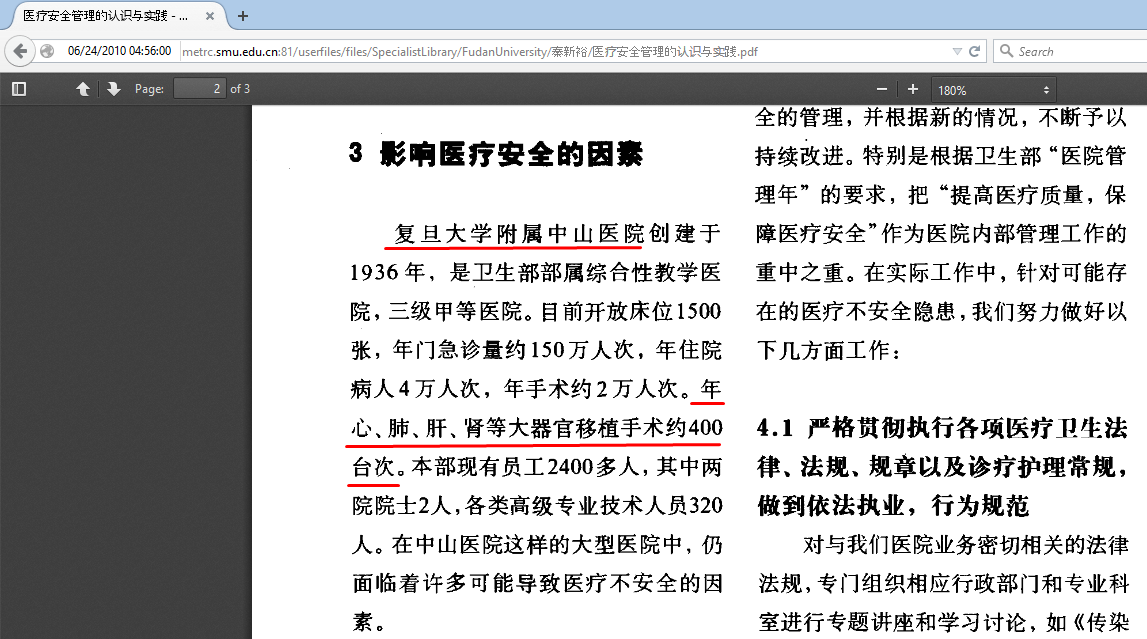
Figure 6.14 August 2006, "Chinese Hospital" Articles Snapshot
c)An online archiving website (www.archive.org) disclosed that as early as 2005, the following statements appeared on the hospital’s official website: “Zhongshan Hospital has completed a grand total of nearly 1,000 kidney transplants, more than 200 liver transplants, 107 heart transplants, 6 cases of combined heart and lung transplants, and 11 cases of liver and kidney transplants. The number of organ transplants is rapidly increasing every year.” The words on the website, “In 1991, [the hospital] successfully completed the country’s first case of pediatric kidney transplant for an 8-year-old child. Right now the patient is 22,” clearly indicate that the time stamp for the web page is year 2005[591].
d)On September 22, 2007, the following statement appeared in the special edition of the Zhongshan Hospital Newspaper celebrating Fudan University Zhongshan Hospital’s 70-year anniversary. “Currently, the hospital has completed a grand total of more than 2,000 kidney transplants, more than 570 liver transplants (11 cases of living-donor liver transplants), over 200 heart transplants, 9 cases of combined heart and lung transplants and 13 cases of combined liver and kidney transplants. The number of organ transplants at the hospital is increasing rapidly every year. This will offer new chances and lives to more and more patients with advanced kidney, liver, heart and lung diseases.[592]”
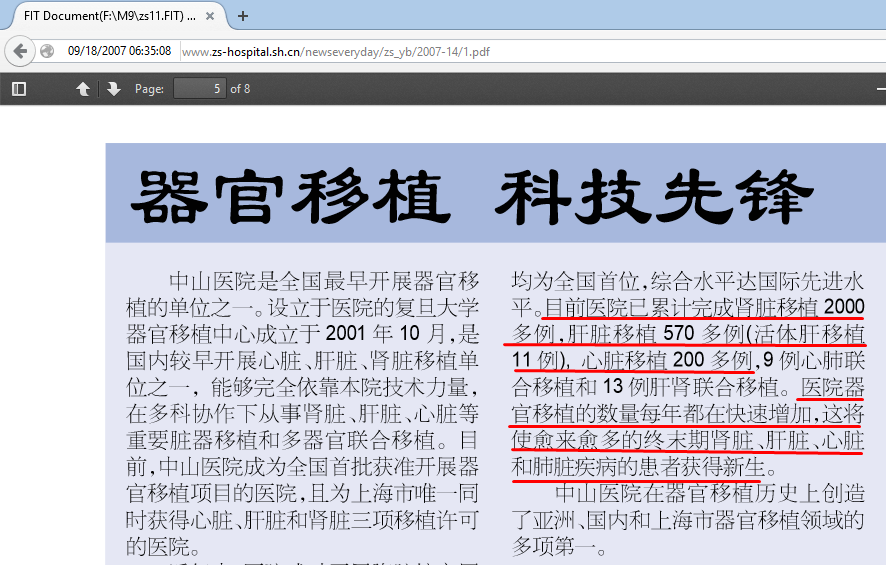
Figure6.15 September 2007, "Zhongshan Hospital" article Snapshot
e)The reports above seem to confirm each other.
f)However, thereafter, until July 24, 2014, the introductory page of the hospital’s website remained unchanged[593]. Beginning in 2008, the hospital started to release tampered data in its external reports, always saying that kidney transplant surgeries numbered over 1,000.
g)In September 2007, the hospital newspaper’s special edition mentioned that kidney transplants had reached over 2,000 cases. However, now the hospital’s official website states, “Currently the Zhongshan Hospital’s kidney transplant surgeries have reached a grand total of over 1,000.[594]”
3)The hospital has always maintained an abundance of organ donors.
“Due to a shortage of organ donors in recent years, the volume of organ transplant surgeries is decreasing nationwide. Zhongshan Hospital’s kidney transplant, however, is staging a single show. In 2004, the hospital had completed 60 cases of all sorts of kidney transplant operations, and in 2005, the number climbed to 153.[595]”
4)By December 2006, one chief physician personally operated on more than 500 cases of liver transplants. The hospital now has 10 liver-transplant teams and is suspected to operate several thousand liver transplants every year.
a)Fan Jia is deputy director of Fudan University’s Organ Transplant Center, a professor, and chief physician[596]. On April 16, 2001, Fan Jia finished his first liver-transplant surgery[597]. By December 2006, he had completed a total of more than 500 liver transplants[598]. By 2012, he had completed over 1100 liver transplants[599].
b)The figure above is for just one doctor. The hospital has at least 10 liver-transplant teams.
c)However, the number of liver transplants released by the hospital is rather small. In March 2014, the media reported that “Shanghai’s Zhongshan Hospital has completed a total of more than 1,200 liver transplants.[600]” This seems to be Fan Jia’s figure alone. “In more than 20 years, he has led over 7,000 surgeries for all kinds of rare and difficult liver cancers and over 1,300 liver transplant operations.[601]” Fan Jia, the current president of Zhongshan Hospital, “works over 80 hours per week and can finish more than 600 operations on liver tumors every year. Among them, over 100 cases are liver transplants.[602]”

Figure 6.16 March 2015, "Liberation Daily" article Snapshot
d)Fan Jia’s thesis paper disclosed that “In China, less than 10 percent of liver cancer patients qualify for surgery removal.[603]” Because of an abundant liver supply and the so-called “Fudan standard” set by Fu Jia’s team, “The liver-transplant rate for liver-cancer patients is between 30 and 40 percent, significantly higher than in foreign countries. The liver-transplant rate for liver-cancer patients at our hospital exceeded 70 percent.” Although Fan Jia could perform over 600 liver-cancer surgeries every year, with more than 100 liver-transplant operations, perhaps other doctors’ workloads are not as heavy. His colleagues who specialized in liver transplant, however, should actually have a much higher rate of liver transplants (Fan Jia’s figure is estimated to be 100/600 = 16 percent). Taking into account Zhongshan Hospital’s 9 other liver-transplant teams, even if they reached only half of Fan Jian’s surgery volume per year, according to the 70-percent liver-transplant rate, the hospital would perform about 600/2×70%×9+100=1990 cases of liver transplants.

Figure6.17 July 2006, "Journal of Hepatology in China" article Snapshot
5)A doctor from the hospital openly admitted that the organ source is Falun Gong practitioners:
During the investigation by the WOIPFG, a doctor at the Liver Transplant Center in Fudan University’s Zhongshan Hospital was asked “whether you have the kind of [organs] from those who practice Falun Gong.” The answer was: “What we have here are all of this kind.[604]”
9. In 2004, the total number of kidney transplants conducted at the General Hospital of Nanjing Military Region exceeded 1,000 cases. However, the published number was only around 100 cases.
While we were researching the real number of kidney transplants at the Nanjing General Hospital of Nanjing Military Region, we felt like we were working as detectives on a criminal case based on the official reports released by the CCP. Therefore, we will present the entire reasoning process at the end of this article, so the readers will see how the CCP has concealed the actual numbers of organ transplants in a cunning way, as well as the astounding crimes behind this.
As the description of our reasoning process is a bit long, we’ve decided to put it at the end of this chapter. We will briefly explain our methods of reasoning below:
1) When the CCP awarded the Group First-Class Merit to the kidney disease research and transplant center at the Nanjing General Hospital of Nanjing Military Region, they used a vague statement claiming that the number of kidney transplants the hospital performed has exceeded 1,000 cases;
2) We found that just Li Leishi alone performed 120 cases of kidney transplant each year;
3) In 2001, Li Leishi punished three surgeons, who worked on the same shift and had a medical accident. Prior to that, the three surgeons conducted several hundred cases of kidney transplant every year. However, Li Leishi didn’t think that punishing them would have any fundamental impact on the number of kidney transplant cases at the hospital;
4) The hospital’s organ transplant center has nearly 30 kidney transplant experts, including two academicians, five to six professorial experts and more than 20 surgeons with master degrees;
5) In 2000, this center was designated as a “top priority” research institute by the CCP’s Central Military Commission[605].
10.Huang Jiefu himself admitted that the number of liver transplants at the Peking Union Medical College Hospital could be over 2,000 per year.
The Peking Union Medical College only reported the first liver transplant[606]。

Figure 6.18 Beijing Union Medical College Hospital Cached
In 2013, Huang Jiefu revealed during his interview by Guangzhou Daily that in 2012, he personally conducted more than 500cases of liver transplant. Among them, there was only one case of voluntary organ donation[607]. Huang Jiefu is the former deputy minister of the CCP’s Ministry of Health[608], director of OTC (July 2006[609]) and the chairman of CODC (2008)[610].

Figure 6.19 March 2013, "Dayang" webpage Cached
2012 was the 6th year following the exposure of the CCP’s evil crimes of live organ harvesting from Falun Dafa practitioners. It is also the year, in which the publicaly-known scale of China’s organ transplant industry started to downsize. It should be a regular year for China’s organ transplant industry, instead of a peak year. Nevertheless, Huang Jiefu still conducted more than 500 liver transplants. It would not be hard to imagine the numbers of organ transplants conducted during the peak years, 2000 to 2006.
Huang Jiefu is the former deputy minister of the CCP’s Ministry of Health, and he also held multiple other positions at the same time. As such, he was involved in a considerable number of governmental and social affairs. Each year, he also had to make several business trips within and outside of China. Therefore, he could not be the surgeon, who performed the largest number of organ transplants. He was just a liver transplant surgeon at the well-known Peking Union Medical College Hospital. Huang Jiefu joined the hospital in 2001. The hospital’s liver transplant department also has a strong team consisting of surgeons who have studied and worked overseas. Currently, the department has two doctorial supervisors, three master student supervisors, five professors and associate professors and five chief surgeons. All of them have doctoral degrees. The Peking Union Medical College Hospital recruits a certain number of trainee surgeons every year and provides them with theoretical and practical training. In the meantime, it is also responsible for teaching the undergraduate and graduate students enrolled in the 8-year academic program at the Peking Union Medical College[611].
The well-known liver transplant surgeons at Peking Union Medical College Hospital include Mao Yilei, Sang Xinting and Zhong Shouxian.
Mao Yilei was named one of the 10 best surgical professors by Peking Union Medical College Hospital. In 1990, he completed his residency training at Australia’s Modbury Hospital; in 1997, he earned his doctoral degree in surgery from Lund University in Sweden; he also studied under StigBengmark, who is a member of the Academia Europaea and was the founder and president of the World Association of Hepato-Pancreato-Biliary (HPB) Surgery; in 1999, he completed his postdoctoral training at Harvard University in the U.S. and at the same time finished his clinical training at the Surgical Oncology Department of the MGH in the U.S[612].
Sang Xinting is a chief surgeon, professor, master student supervisor and the current deputy director of the hospital’s liver surgical division. He is good at diagnosing liver and gallbladder diseases and surgical treatment, especially those difficult diseases related to liver and gallbladder. He graduated from Zhongshan Medical College in 1986 with a clinical bachelor degree in medicine. That year, he joined the surgical team at Peking Union Medical College Hospital. He was a visiting scholar at the Karolinska Institute in Sweden between 1993 and 1995. In 2007, he earned his doctor degree from the Xiangya School of Medicine at China’s Central South University[613].
ZhongShouxian led his team to perform the first liver transplant case at Peking Union Medical College Hospital. He is a chief surgeon, professor and doctorial supervisor. In his early years, he graduated from the Kharkov Medical College in the Soviet Union, and thereafter, he studied at the MGH of Harvard University and the surgical division of the John Hopkins Hospital. He has been a member of the China Medical Society and International Surgical Society and the deputy chairman of the Beijing chapter of China Medical Society. He is also a deputy editor, editing committee member and consultant for a total of more than 10 medical journals, including the Chinese Journal of General Surgery, Chinese Medical Journal, China Journal of Oncology, Chinese Journal of Practical Surgery, Journal of Hepato-Pancreato Biliary Surgery and Journal of Chinese Clinical Medicine[614].
Therefore, based on the fact that Huang Jiefu performs more than 500 cases of organ transplant per year; his time to perform surgeries at the Peking Union Medical College Hospital every year is limited; and the hospital has a strong liver transplant team.Our analysis reveals that Huang Jiefu cannot be the surgeon who performs the largest number of organ transplants. Also, his transplant number should not be the lowest among all the surgeons. So, we base our calculations by treating his transplant amount as moderate. Huang Jiefu performed 500 cases of liver transplantation in 2012. This can be considered the workload of one surgery team. A well-known large hospital like Peking Union Medical College Hospital should have 4-6 surgery teams, with its number of organ transplants ranging from 2,000 to 3,000 every year.
The tricky part regarding the Peking Union Medical College Hospital is that now you can no longer find any medical papers on liver transplants conducted at this hospital in any thesis or dissertation databases in China, and there are only a very few papers on the hospital’s kidney transplant operations. The hospital’s website has also removed all the webpages containing the liver transplant data and the data on kidney transplants has not been updated for 10 years.
11. The Affiliated Renji Hospital of Shanghai Jiaotong University: suspected to perform more than one thousand liver transplants; the doctor admitted to retrieving organ donors from the army.
This is a Grade 3 Class A hospital[615]. This hospital was appointed by the Ministry of Health to conduct liver and kidney transplant on May 23, 2007. It was the first in the Shanghai area to perform kidney transplant surgeries. The hospital’s official website claimed that its Department of Urology Surgery has currently completed more than 1,000 cases of kidney transplants[616]. Every year it performs about one hundred cases[617].
1)The hospital claims that for the past 4 years, its liver transplants rank No. 1 nationwide, and pediatric liver transplants topped the world in number performed.
a)The Department of Hepatobiliary Surgery in Renji Hospital is the country’s largest organ transplant treatment center, in terms of surgery volumes and clinic visits. In 2004, 38-year-old Xia Qiang led a group of physicians in the hepatobiliary team. Starting from scratch, with an average age of 34 years, by October 2014, they had finished more than 1800 cases of liver transplant surgeries[618].
b)For eight consecutive years, the hospital ranked No. 1 in Shanghai, and since 2011 ranked the nation’s No.1 for 4 consecutive years[619].
c)Since 2006 up until now, it has completed 316 cases of pediatric liver transplants and has become the nation’s largest pediatric liver transplant center. Its pediatric living donor liver transplant volumes ranked No.1 in the world, for four consecutive years[620].
d)It promoted its technical experiences to 16 first-class grade 3 hospitals or hospitals affiliated with medical colleges in 12 provinces in China, and assisted first-class grade 3 hospitals in several provinces to carry out their first pediatric liver transplant surgeries[621].
e)However, we are also aware of the liver transplant volumes in the Tianjin, First Central Hospital in China. In 2014, it openly admitted to almost 10,000 cases of liver transplants. Since 2006, the annual number of liver transplants reached about 1,000[622].
2)The busy schedule at the hospital gives reasons to suspect that the actual transplant volume is extraordinary.
a)“Just how many liver transplant surgeries he had performed on earth, Xia Qiang lost count himself. He only remembered his highest record was finishing 6 liver transplant surgeries in a single day.[623]”

Figure 6.20 June 2006, "People's Daily" article Snapshot
b)Xia Qiang said, “I adopted a military style management for my team. Every health care professional must have his cellphone on 24 hours a day. Because liver transplant surgery requires you to go out to retrieve the donor organ at any time, we must be prepared to operate accordingly. Our doctors are on call all the time.” One doctor who was responsible for harvesting the donated liver logged over 60,000 flight-kilometers in 3 months. What frequently occurred was “on his way to exit the airport, the person was instructed to transfer to a flight for another place.[624]”
c)“Inside the Renji Hospital, there are two big rooms full of kids waiting painstakingly for a liver donor. 60% of pediatric patients with biliary atresia waiting for liver donation in the entire country are gathered here. Because of large volumes of operations, the Renji Liver Transplant Center was immediately notified once a liver source is identified around the country. Therefore, doctors here must make sure their cellphones are on 24 hours a day, and be ready to travel for organ harvesting anytime, anywhere.[625]”
d)From media report on Renji Hospital, “busy” is the most common word used. In an article published in 2013, “Non-Stop Liver Transplant Surgeries in Renji Hospital Made Doctors Unable to Leave through the Night”, it was said “This summer, Professor Xia Qiang at Renji Hospital’s Organ Transplant Center has been extremely busy. Operations were scheduled one after another, and he wasn’t able to leave the hospital throughout the evening. The annually increasing volume of surgeries is making Renji Hospital the nation’s largest liver transplant center.[626]”
e)Although the hospital staff is getting busier every day, and the 2013 report claimed that “The annually increasing volume of surgeries is making Renji Hospital the nation’s largest liver transplant center.” The official report from the hospital however kept saying only “over 200 cases of liver transplant” are done at this hospital. This is not credible[627].
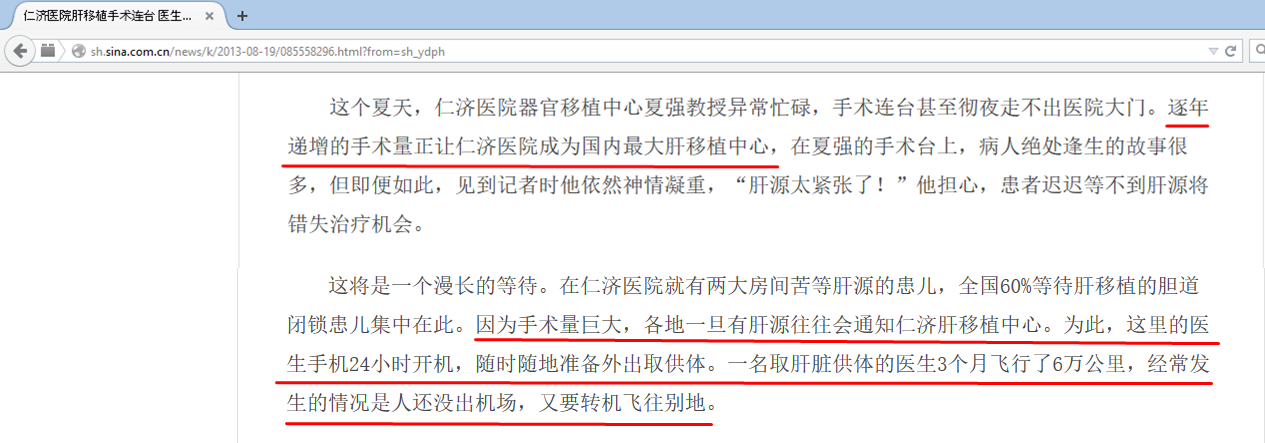
Figure 6.21 August 2013, "Sina Shanghai," article Snapshot
3) Both the number of beds at the hospital’s liver transplant center and its high turnover rate made one suspect that its annual number of liver transplants could be as much as one thousand.
a)In October 2004, 13 liver transplant beds became 23: “The fourth day after I arrived at the Renji Hospital, I performed the first liver transplant surgery. In the following week, we successfully carried out 4 liver transplant surgeries.” Leaders at the hospital witnessed Xia Qiang’s capability, as well as the potential of this young transplant team. They immediately made the decision to expand the number of beds at the liver transplant center from 13 to 23, during the “October 1st” holiday[628].
b)On June 28, 2007, according to the China’s Organ Transplant website, the number of beds for liver transplant has reached 90.
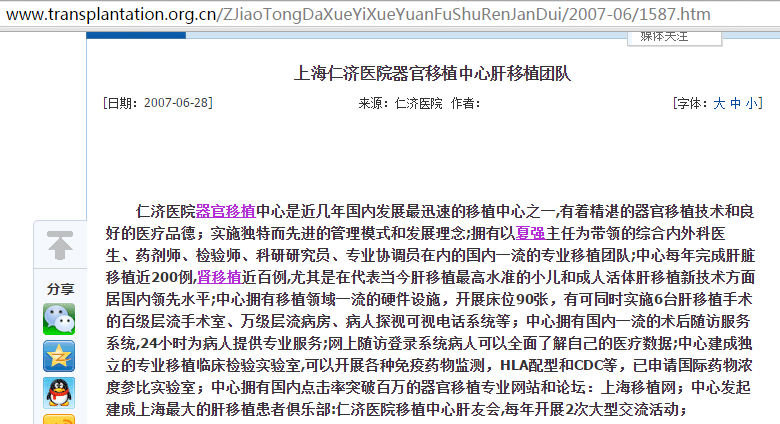
Figure 6.22 June 2007, China organ transplants webpage Cached
c)There were 110 hospital beds for liver transplants. “Up to now, Renji Hospital has 3 inpatient areas, 110 hospital beds and more than 70 health care personnel. It has become the key specialist hospital among national clinics, under the ‘211 National Project’. It also became the National Clinical Pharmacology Institution and priority key to clinical discipline by Shanghai Health and Planning Commission.[629]”
d)In China, the liver transplant hospitalization takes an average of 30 days. Potentially, suppose the turnover rate of the hospital beds is 100%, in 2004, 23 beds can have 276 cases of liver transplantation; in 2006, 90 beds can have 1080 cases of liver transplantation; now 110 beds can have 1320 cases of liver transplantation.
e)Renji Hospital introduced itself in 2007 that “(The transplant) Center completes almost 200 cases of liver transplantation each year.[630]” In July, 2013, “The liver surgery department at Renji Hospital did more than 200 cases of liver transplantation.[631]”
f)If the statement of keeping 200 cases of liver transplantation each year is true, with the increasing number of available hospital beds to 110 recently, the bed turnover rate is surprisingly low. It is not consistent with the hospital’s paying high attention to bed turnover rate. In Shanghai where the hospital beds are tight, the hospital had only 2000 beds even after its expansion. Therefore, it invented a lot of ways to speed up the beds turnover, including the famous “Ambulatory Surgery Center”, which means the patients only stay 24-48 hours in hospital. In this case, the bed turnover rate increased a lot and the hospitalization costs for the patients decreased by 10%-30%[632].
g)Having 200 cases of liver transplantation each year is inconsistent with its own statement that the hospital ranks No.1 for liver transplants nationally in the past 4 years (It must have done at least higher number of liver transplants than the Oriental Organ Transplant Center with publicly announced cases in order to be qualified to be the first). It is also inconsistent with the statement that starting from 2006, the liver transplant cases are around 200 each year while the hospital
beds increased sharply, “With the annually increased number of operations, Renji Hospital becomes the biggest liver transplant center in China.” Therefore, we doubt that the actual number of its liver transplantation each year is more than 1,000.
4)The hospital admitted that they obtained the organs directly from military Until Feb 7, 2015, the liver transplant nurse on duty at Renji Hospital still admitted the military source of organs[633]. As we all know, military does not control the prisons and so-called death penalty criminals. So it can only be connected to the live organs library from the detained Falun Gong practitioners, which has been suspected for long time. There is little public information about kidney transplants at this hospital. But according to the current liver transplant situation, and that kidney transplant techniques are comparatively easier and with higher demand, the kidney transplant cases should be extremely large in number. There should be at least 2000 cases of kidney transplantation each year.
III Another 44 hospitals were also suspected to perform organ transplants at a far higher rate than the published numbers.
We described the above local hospitals and military units in detail in order to illustrate the methods and level of cover up of organ harvesting by the Chinese Communist regime. Other than Tianjin Organ Transplant Center that showed obviously very high volume of transplants, other hospitals were not among high volume transplant medical establishments.
For example, the Beijing University People’s Hospital, which performed 4,000 transplants in 2010 alone, is only a hospital that performed slightly above the average volume of transplants. With many large hospitals concentrated in Beijing, there are hospitals that performed even more transplants (with details outlined below), such as the Beijing Friendship Hospital that was ranked as the number one kidney transplant in China. There is also Beijing Chaoyang Hospital and Beijing Organ Transplant Center (located within Chaoyang Hospital).
In the field of liver transplants in China, Peking Union Medical College Hospital is just one of the larger hospitals. There are even more hospitals renowned for liver transplants. For example, the First Affiliated Hospital of Zhejiang University, the First Affiliated Hospital of Sun Yat-sen University, Tianjin First Central Hospital, and the West China School of Medicine/West China Hospital, Sichuan University[634].
Another case, the PLA’s No. 309 Hospital is not the largest transplant hospital in the military. Rather, the Shanghai Changzheng Hospital was the No. 1 organ transplant institution publicized by the Chinese military in 2003. The Third Military Medical University Hospital was identified as the major liver transplant research institute in 2001, while the PLA’s No. 309 Hospital only established transplants center in 2004, and its own research institute was established in 2010. We analyzed the PLA’s No. 309 Hospital transplant operations not because its large volume but because Beijing is the political center, and the PLA’s No. 309 Hospital was under the auspices of the Headquarters of the General Staff, deeply trusted by the Chinese Communist regime.
The number of large university affiliated hospitals was higher than the witness had revealed. Many hospitals in China are affiliated to universities. Some universities had 20 affiliated hospitals. Under the reform of Commercialization and Industrialization of Education, many hospitals are now under the management of universities. They became part of the educational institutions. The only exceptions are some of the very famous hospitals who are still using their original names and did not get changed into “XXX Affiliated Hospitals.” So most people still recognize these hospitals by their old names, but do not realize they were also part of some university. We believe this is why the “deputy head of hospital witness” mentioned there were around 20 very large hospitals because he only knew part of the overall scheme. The true scope of the entire operation of organ harvesting may only be revealed by the 610 Office.
For example, The Capital Medical University has 20 affiliated hospitals[635]. Many well- known hospitals in Beijing are all affiliated with it, including Ministry of Health-designated transplant hospitals such as Beijing Friendship Hospital, Beijing Chaoyang Hospital, Beijing Anzhen Hospital, Beijing YouAn Hospital, and Beijing Tongren Hospital. These hospitals are more renowned than the Beijing People’s Hospital.
Furthermore, Shanghai Jiao Tong University has 14 affiliated hospitals. Among them we discovered the first four of them were designated transplant centers by the Ministry of Health: Shanghai Renji Hospital, Shanghai Ruijin Hospital, Shanghai General Hospital, Xin Hua Hospital, and Shanghai Sixth People’s Hospital[636]. The Shanghai Jiaotong University was Jiang Zemin’s alma matter and was given great attention by Jiang.
Examples of 44 Other Hospitals Performing a Large Volume of Transplants.
We attempted to classify the hospitals based on their ranking in the field of transplants within that city or province and their ranking on the national scale, their doctors qualified to perform transplants, number of hospital beds, etc. Based on these criteria, we can see these hospitals are indeed transplant centers of significant volume.
1.Beijing Friendship Hospital, the Largest Kidney Transplant Center in Asia, and Beijing Cross-Match Center
It is designated to be the Beijing Organ Transplant Cross-Match Center by Beijing City Department of Health in 1997. In 1998 the Sino-US Terasaki Research Institute Cross-Match Center was established.
It is China’s first hospital to perform 1,000 cases, 2,000 cases and 3,000 cases of organ transplants[637].
By November 2004, this self-proclaimed Asia’s largest kidney transplant center had completed over 3,000 cases of organ transplant[638].
2.Beijing Chaoyang Hospital, Beijing Organ Transplant Center
Beijing transplant center is located in the hospital’s liver and gallbladder surgical department. It is the only establishment that can conduct simultaneous liver, heart, kidney, lung, small intestine, and pancreas organ transplants[639].
3. The First Affiliated Hospital of Zhejiang University, Largest Organ Transplant Center in the Eastern China Region
It is the major research institute on combined organ transplants established by the Ministry of Health in March 2001. It is one of the largest organ transplant establishments and the largest one in Eastern China[640].
This hospital boasted the most talented and capable transplant faculty. Just from a dissertation paper, we discovered that there were 35 doctors who have performed transplants. Among them, 12 were chief surgeons and 6 associate surgeons.
4. The First Affiliated Hospital of Sun Yat-sen University, Claimed To Be Ranked Second in the Volume of Transplants in China. Dr. Huang Jiefu Was a Faculty Member There.
Currently, the transplant center within the First Affiliated Hospital of Sun Yat-sen University is renowned for their transplantation program in China. The total volume is ranked second in China. Their transplant center is among the largest in the type of transplants and its scale in China[641]. This hospital was one of the places Huang Jiefu worked. In 2006, this transplant center became one of the three CMB (Chinese Medical Board)-certified training centers. More than 42 organizations came to this center to visit and study[642].
5. The Third Affiliated Hospital of Sun Yat-sen University, Guangdong Province Transplant Center
This transplant research institute is the Guangdong Province transplant center[643]. It is very well-known in the field of liver transplants.
6.The First Affiliated Hospital of Xi’an Jiaotong University, Mid-West Region, Transplant Demonstration Center
The Institute of Genomics & Forensic Science was authorized by the Ministry of Health Bureau of Science and Education and established at the Xi’an Jiaotong University’s Department of Forensics. This major institute was jointly established by the Ministry of Health and Ministry of Public Security and Supreme People’s Court. They claim “reaching the advanced level on an International scale in the research of organ cross-matching[644].
In 2001, they established the Xi’an Jiaotong University Organ Transplant Research Institute[645]. By December 2012, they had provided advice to 23 hospitals in 13 provinces and cities on more than 10,000 kidney transplants. It also brought about related development in the transplant of liver, heart, lungs, and intestines. It served as good exampleof the mid-west region organ transplant effort in China[646]. As of April 15, 2015, the First Affiliated Hospital of Xi’an Jiaotong University had performed a total of 4,023 kidney transplants[647].
7. Shanghai First People's Hospital, Shanghai Clinical Center for Organ Transplantation
Shanghai Clinical Center for Organ Transplantation was established in August 2001, affiliated to the Shanghai First People's Hospital. It was built based on the Shanghai Tissue Type Matching Center and the Shanghai Organ Transplant Research Center, and is a venture that relies mostly on kidney transplants. The center first carried out an allogeneic kidney transplant in 1976.
The hospital claims that currently it carries out various kidney, heart and liver transplants, liver-kidney, pancreas-kidney and kidney-adult islet cell co-transplants and other substantive large organ transplants. Other transplants performed include corneal, allogeneic finger, fetal islet cell, bone marrow, peripheral blood stem cell and cord blood stem, a total of twelve major types[648].This hospital carries out the greatest number and the most types of organ transplants in Shanghai[649].
8. West China Hospital of Sichuan University, Laboratory of Hepatobiliary and Pancreatic Research of the Ministry of Health, one of the most famous hospitals carrying out liver transplantation
The Kidney Transplant Center at West China Hospital, Sichuan University, is one of the first hospitals in China to carry out kidney transplants. It is the key project of Sichuan University of Chengdu, and of Sichuan Province[650]. The Liver Transplant Center relies on the Department of General Surgery in West China Hospital and Research Laboratory of Hepatobiliary & Pancreatic Surgery of the Ministry of Health, which are main projects of the Ministry of Education. Its foundation is from the West China Hospital liver transplant coordination group which combines talents and technologies from various disciplines and interdisciplinary professionals. It is a medical and research institution consisting of health care, teaching and scientific research[651].
Yan Lunan, the leading specialist in liver transplants, claimed that the hospital can perform three to five liver transplants simultaneously per day, up to seven liver transplants in one day are on record[652]. A nurse from West China Hospital responded to the WOIPFG investigation with a recorded message saying they did six kidney transplants a day, with an abundant source of kidneys[653].
9. Changzheng Hospital, Affiliated with the PLA Second Military Medical University, was the first organ transplant research institute in the Chinese military
The Organ Transplant Center was established in early 2003 by the combination of a kidney transplantation group in the Department of Urology and a liver transplantation group in the Department of General Surgery. It was approved on December 17, 2003, as the first PLA institute of organ transplant, by the PLA Department of General Logistics. Kidney transplants at the center started in June 1978[654].The official website of the Organ Transplant Center, Changzheng Hospital, affiliated with the PLA Second Military Medical University claimed within nine days, from April 22 to April 30, 2005, the hospital organ transplant center completed 16 liver transplants and 15 kidney transplants[655].
In April 2006, the Changzheng Hospital stated, "In three years of operation, our department has cured 120 patients with severe hepatitis by emergency liver transplantation". The shortest waiting time to get a liver transplant was four hours after admission[656].

Figure 6.23 The cached webpage of the article published on "Journal of Clinical Surgery" in June 2006
10. Fuzhou General Hospital of Nanjing Military Region, the amount of annual transplants ranked in the top three for six consecutive years
The hospital’s cumulative number of kidney transplants ranked No. 1 in the nation. The number of transplants performed annually ranked in the top three nationally for six consecutive years. It became the PLA Institute of Cells and Organ Transplantation in 2011. They have performed eleven types of organ transplantation[657].
11. General Hospital of Armed Police Forces: "The largest liver transplant center in Beijing"
The Institute of Organ Transplantation, formerly the Liver Transplant Center of the General Hospital of Armed Police Forces, was established in 2001. Jointly run by the General Hospital of Armed Police Forces and the Oriental Organ Transplant Center, it is the largest liver transplant center in Beijing. The hospital performs 200 to 300 liver transplants each year[658].
12. People's Liberation Army General Hospital (301 Hospital), leading in kidney transplants in China, leading in liver transplants among top ranking hospitals
The hospital claimed its kidney transplantation has always been at a leading level in China[659]. Yu Lixin from Nanfang Hospital, published an article in the "Medical Journal of the Chinese People’s Armed Police Forces" in 2004 about the progress of clinical allogeneic kidney transplant in China. He reported by June 1999, the hospital had completed 1,180 kidney transplants, the number was among the highest of hospitals around the country[660].
The top ranked Liver Transplant Center was developed from the Department of Hepatobiliary Surgery of the General Hospital. It functions interactively among multiple disciplines. The center also has the duty to perform liver transplantation and hepatobiliary care for high ranking central, provincial and military leaders[661].
13. The First Affiliated Hospital of Xinjiang Medical University, the hospital where Huang Jiefu conducted a liver transplant demo with two living donors as back up in 2005
The Organ Transplant Research Institute was established in July 2002. Director: Wen Hao. The institute has a total of 38 staff members, including 32 with senior professional titles and 6 with intermediate professional titles. It consists of subordinate research laboratories for liver transplant, bone marrow transplant, kidney transplant and corneal transplant. Their main research areas were liver transplant, kidney transplant, bone marrow transplant, corneal transplant and heart transplant[662].
The medical thesis “Preliminary Experiences of Monitoring 4,207 Patients after Liver Transplant" revealed that the hospital had conducted over 4,200 liver transplants before March 2003,[663] which is in line with the scale of the hospital. However, the strange thing is that when we later reviewed this thesis on Chinese websites, its title remained the same, but its contents had become the caring for five patients of liver transplants, which was completely different from the title.
Although the Chinese Communist Party began harvesting organs from living prisoners of conscience in the 1960s, Xinjiang is the place, where large-scale organ harvesting were carried out in the early stage. According to Ethan Gutmann’s report entitled “The Starting Point of Massive Organ Harvesting - Xinjiang Surgeries”, the CCP built the world's largest labor camps in Tarim Desert, detaining about 50,000 Uighurs and felons. At least before 1994, the Chinese Communist Party began to do bulk organ harvesting from prisoners of conscience, and later this practice (organ harvesting for transplant) spread all over China. By the end of 1999, Falun Gong practitioners being illegally detained here became a new source of vast amounts of healthy organs[664].
This is the hospital where Huang Jiefu conducted autologous liver transplant demo with two living donors as back up in 2005[665].

Figure 6.24 The cached webpage of the article published on “Endemic Diseases Bulletin 2003 Vol.18, Issue No.2 "
14. Affiliated Eastern Hepatobiliary Surgery Hospital of Second Military Medical University. Its President Wu Mengchao Has Been Named the‘Father of Chinese Hepatobiliary Surgery’ by the CCP
President Wu Mengchao was the chief advisor of the military’s Organ Transplantation Conference and academician of Chinese Academy of Sciences. He was named as “Father of Chinese Hepatobiliary Surgery” by the CCP. He is also the deputy head of the expert team at General Logistics Department of PLA, and deputy chairman of the PLA Medical Science and Technology Committee[666]. Jiang Zemin received him five times[667], and personally signed an order to award him. The CCP Central Military Commission especially held a general assembly to grant Wu the title of “Model Medical Expert” and awarded him the so-called Class A Hero Medal.
He won the highest Science and Technology Award of China in 2006.
All the media in mainland China have deleted the data from their websites about the number of liver transplants that Wu Mengchao had conducted. Minghui.org reported that as of 2010, Wu had performed more than 4,000 cases of liver transplantation[668].
On May 11, 2011, Wu Mengchao and his student Wang Hongyang were interviewed by Sina. The host Yin Jun asked, “At what level is our country’s current liver transplant?" Wu Mengchao replied, “At present, our number of liver transplants is No. 1 in the world. Both the quality and results are good and have caught up with the international level.[669]"
15.The Southwest Hospital of the PLA’s Third Military Medical University Has a Hepatobiliary Surgery Research Institute for the Entire Army. It Is One of the Military’s Most Important Liver Transplant Hospitals
Dong Jiahong, Director of the Southwest Hospital’s Hepatobiliary Surgery Institute claimed that his hospital “operated on 6 cases of liver transplant surgeries simultaneously in a single day. [670]” It was recognized in 2001 as the PLA’s key laboratory for liver transplant. In 2004, the Southwest Hepatobiliary Surgery Hospital and Pittsburg University’s Starzl Transplant Institute jointly established an International Collaboration Liver Transplant Center[671].
16.Xinqiao Hospital of the PLA’s Third Medical University is the Renal Disease Center for the Entire Army. It Once Performed 24 Renal Transplant Surgeries in a Single Day
The second department of urology in Xinqiao Hospital, which is affiliated with the PLA’s Third Medical University, is the renal disease center for the entire army[672]. It has first-class personnel and equipment and has marked a record of 24 kidney transplant surgeries in one day[673].
17.The General Hospital of Jinan Military Region, the Army’s Renal Transplant and Dialysis Treatment Center, Has Made a Record of Operating 16 Renal Transplant Surgeries in One Day
The department of urology in the General Hospital of Jinan Military Region was approved by the general logistics department in 2005 as the army’s renal transplant and dialysis treatment center[674].
In December 2008, Dazhong Net’s report titled “the General Hospital of Jinan Military Region” stated: “(The hospital) is capable of operating on 6 renal transplant surgeries at the same time and has made a national record of continuously operating on 16 renal transplant surgeries within 24 hours[675].
18.The General Hospital of Shenyang Military Region, the Army’s Largest Eye Bank
This hospital is one of China’s largest military hospitals. Due to the fact that web pages were deleted from the hospital’s official website, we were unable to gather sufficient information on its renal and liver transplants. However, from the cornea transplantation data, we could easily detect the hospital’s large volume of transplants in general:
The ophthalmology department of the General Hospital of Shenyang Military Region contains the largest eye bank in the army, as well as within the Northeast region[676]. It has several decades’ history of cornea transplant development and the eye bank’s organ source is abundant[677]. Its cornea transplant volume tops all major hospitals in the Northeast region, and it is the only hospital in the Shenyang region that can provide cornea transplant patients with corneal materials at any given time. It’s considered as the lead hospital in Northeast region for developing cornea transplant programs and currently holds the highest number of cornea transplant cases in the Shenyang region[678].
19.The General Hospital of Guangzhou Military Region, the Largest Urology Base in South China, and Is at the Forefront of Liver Transplantation in Guangdong Province
In 2005, the hospital was approved to establish the Guangzhou Military Urology Research Institute. In 2008, it was awarded Guangdong’s Specialty Program by the provincial government. Currently, it stands as the largest urology department in Guangdong province and the region’s largest base for urology related education, research, treatment, prevention, and a post-doc research station. At present, there are 1 Ph.D. supervisor 3 master’s degree supervisors, 1 person with State Council allowance, 2 persons with military allowance, 1 military general-rank specialist, 4 key talented personnel from Guangzhou Military Region, 1 well-known surgeon from the military region, 1 outbound post-doctor, 6 doctors (with Ph.D.’s), 8 persons with master’s degrees, and 10 Ph.D. or master’s degree candidates[679].
Its Hepatobiliary Surgery Department’s Liver Transplant Center has become one of the most technically strong and comprehensive organ transplant centers at the hospital[680].
20.The General Hospital of Chengdu Military Region, One of the Largest Renal Transplant Bases in the Western Region
The department of urology at the General Hospital of Chengdu Military Region is a renal transplant base for medical treatment, research, and education that serves Sichuan province and China’s West region (Yunnan, Guizhou, Sichuan, Tibet)[681] .
21.The PLA’s No. 303 Hospital, a Key Lab and Research Base for Transplant Medicine in Guangxi Province
The hospital’s public data disclosed that its annual transplant volume is huge, which includes roughly 200 renal transplants, 30 to 50 liver transplants, and about 10 heart and lung transplants. To date, it has developed transplant programs focused on kidney, liver, heart, lung, multi-organ, and cornea. The first case of a kidney transplant was performed in 1993. The first liver transplant was completed in 2004, and the program became independent. In 2005, the first combined liver and kidney transplant was performed. The organ transplant building was constructed and went into operation in 2006.The first heart transplant was done in 2009. In 2010, the Transplantation Medicine Research Institute was founded, and the Autonomous Region’s Transplant Medicine Key Laboratory Development Base was established. The team is very strong, with “over 20 high-ranking research individuals, 3 postdocs, 30 Ph.D.’s, and more than 80 per cent of its research team holds at least a master’s degree.[682]”
22.Affiliated Hospital of the Armed Police Medical School. Its Renal Transplant Volume Placed First in the Armed Police Forces and Is Among the Top 20 Major Hospitals in China
The department of renal disease in the Hospital Affiliated with the Armed Police Force is a multi-disciplinary center that combines renal transplantation, urology, nephrology, blood purification, and a tissue matching laboratory into one section. With its renal transplant program, the nephrology department spearheaded the development of renal transplantation technology[683]. In the past few years, under Li Huisuo’s leadership, the team completed more than 200 renal transplant operations every year. Over 150 cases involved only a single surgeon. This placed the hospital first in the armed police forces and among the top 20 main hospitals in China[684].
23.The PLA’s No. 474 Hospital in Lanzhou Military Region Could Operate on 12 Renal Transplant Surgeries in a Row During One Setting
The PLA’s No. 474 Hospital in Lanzhou Military Region could operate on 12 renal transplant surgeries in a row during one setting[685].
24.The Xiangya Second Hospital in Zhongnan University. Huge volume of Transplant Operations CanBe Estimated From its Hectic Surgery Schedule
“The organ donor network has gradually expanded to the entire country and established an organ-source sharing relationship with more than 10 transplant centers in the nation.[686]”
An extraordinarily large volume of transplants can be observed from the hospital’s hectic workload. “As a transplant surgeon, they often work more than 20 hours straight, non-stop. After resting for three or four hours, another around of operations await. The scrub nurse has changed shifts several times, yet the surgeon still remains active at the operating table. It was not uncommon to have finished more than a dozen surgeries after only two or three days. Once a record of 9 renal transplant surgeries finished in a single day was made[687].
25.The First Hospital of Jilin University: ‘The number of its renal transplant cases ranked within the top 3 in China[688]’
This is the biggest hospital in Jilin Province. Fu Yaowen established the Renal Transplantation and Blood Purification Center and supervised a series of innovative and practical research projects that greatly enhanced the human kidney survival rate in renal transplantation. The volume and quality of transplant operation within the hospital ranked in the top 10 amongst more than 300 renal transplant facilities around China. Its renal transplant case total ranked within the top 3[689].
26.Affiliated Zhujiang Hospital of the Southern Medical University:‘One of the nation’s most important transplant centers’
According to the official website of Zhujiang Hospital’s organ transplant center, “(It) is one of the nation’s most important transplant centers. Its medical technology in areas of cadaveric and related renal transplantation, liver transplantation, and combined pancreas and kidney transplantation has reached advanced levels in foreign countries.[690]”
27.Jiangsu People’s Hospital. The Largest Hospital in Jiangsu Province and a Key Liver Transplant Laboratory of the Ministry of Health
Jiangsu People’s Hospital(Nanjing Medical School’s No. 1 Affiliated Hospital, Jiangsu Clinical Medicine Research Institute, Jiangsu Red Cross Hospital) is the largest first-class grade 3 general hospital in Jiangsu province[691].
The Liver Surgery Research Institute includes 2 in-patient areas, more than 110 hospital beds, and 1 key laboratory of the Ministry of Health. This facility mainly targets research in liver transplants, living donor liver transplants, and the assessment, decision-making and handling of various related pre-op and post-op issues[692].
The medical team is under the leadership of Professor Wang Xuehao, a fellow of the Chinese Academy of Engineering. It includes 9 members with a professor title, 12 with associate professor title, a total of 62 health professionals, and among those 90 per cent holds a doctorate degree. Wang Xuehao, the team lead, is a fellow at the Chinese Academy of Engineering, a professor at the department of surgery in Nanjing Medical School, a Ph.D. advisor, the nation’s well-known organ transplant and hepatobiliary surgery expert, and a pioneer in China’s living donor liver transplantation. Wang now serves as the Director for the Ministry of Health’s Living Donor Liver Transplant Key Laboratory and the academic committee, Chairman of Chinese Medical Microbiology and Immunology’s Subchapter of Transplant Immunology, a member of Ministry of Health’s human organ transplant exerts team, Associate Director of the Medical Association in Jiang Su province[693].Wang promoted his living donor liver transplant techniques in more than 20 provinces around the nation, and has led and motivated further development in our country’s living donor liver transplant programs[694].
28.Xijing Hospital of the Fourth Military University,Overall Ranking Stays in the Top 5 in China in Terms of Heart, Liver, Lung, and Kidney Transplant
Its technical strength in heart, liver, lung, and kidney transplant is very strong. Presently, the hospital is qualified to join all of the 4 major organ transplant programs, namely heart, liver, lung, and kidney transplantation. The hospital’s overall performance ranks among China’s top 5[695].
29.Navy’s General Hospital. Public Figure From its Official Website Disclosed Several Thousand Liver Transplants
“Presently, several thousand patients with advanced liver cancer have acquired a second chance in life through liver transplant operations at the nation’s first group of grade 3 hepatobiliary surgery in the Navy’s General Hospital.[696]”
30.People’s Hospital in Zhengzhou: 13 Renal Transplants Performed in 21 Hours. 20 Emergency Transplants in One Year
On Dec. 27, 2007, a team led by Qu Qingshan, the director of the nephrology and organ transplant center, completed 13 renal transplant surgeries within 21 hours[697]. The department of nephrology completes almost a hundred liver transplants annually. At the same time, it successfully undertook over 10 combined liver and kidney transplant and pancreas and kidney transplant. It conducted the first case of intestine transplant in Henan province and actively engages in the cluster transplantation of abdominal organs. The annual emergency liver transplant saved more than 20 patients with acute liver failure[698].
31.Zhengzhou University’s No. 1 Affiliated Hospital, the Largest Hospital in China, with an annual revenue of 7.5 billion yuan, and 7,000 beds, which ranks first place in the nation. The highest record of its daily clinic visits reached 21,600, 4 times that of similar hospitals in Henan
According to public records, the hospital revenue rapidly increased from 680 million yuan in 2008 to 6 billion in 2013. By 2014, the number skyrocketed again to 75 billion yuan, which easily tops the health industry in Henan province. In merely 6 years, its revenue exceeded the second facility in line, the Henan People’s Hospital (with a revenue of 4.58 billion yuan) by 3 billion yuan.
In 2014, the hospital had 4.26 million clinic visits, 310 thousand inpatients, and 196,000 operations, which ranked first place in China. Its liver transplant reached over 100 cases and renal transplant broke though 230 cases. Both transplant surgeries ranked in the top 5 in the China.
“This is only the tip of the iceberg in the humongous business volume of Zhengzhou University’s No. 1 Affiliated Hospital.” An anonymous industry expert disclosed to a reporter from China Economy Weekly. During its peak time, the hospital’s daily clinic visit volume reached 21,600. The average annual visit is about 16,000 per day. By contrast, other reputed hospitals such as the Henan Chinese Medicine Hospital and People’s Hospital in Zhengzhou, the daily clinic visit was only around 5,000[699].
32.The PLA’s No. 153 Central Hospital. The Army’s Central China Renal Transplantation Coordination Center
The PLA’s No. 153 Central Hospital was established by merging the PLA’s No. 153 Hospital and the former PLA’s No. 460 Hospital (Air force in Zhengzhou) [700]. The Chinese Army’s Central China Renal Transplantation Coordination Center (the former PLA’s No. 460 Hospital’s Urology Department) advertised in Chinese Medicine Network: “The Chinese Army’s Central China Renal Transplantation Coordination Center website invites you to watch the renal transplant video online. In order to make it more convenient to compatriots from Hong Kong, Macao, and Taiwan to receive treatment here, our center has specifically set up a Taiwan contact center… Our center has completed more than 100 renal transplant surgeries three years in a row! In the immediate future, we plan to develop techniques for combined liver and kidney transplantation, and combined liver and kidney transplant… For detailed information, please visit http://www.china-kidney.com/[701].
33.The PLA’s No. 254 Hospital. Its Renal Transplant Program is Tianjin City’s First Key Leading Medical Study
Its renal transplant study is Tianjin city’s first key leading medical program. In 1972, the hospital began its research in renal transplant and dialysis. In 1974, it started dialysis in clinic phase. In 1976, cadaveric renal transplantation began in clinic. It’s one of the nation’s early hospitals that started transplantation and dialysis treatment. Types of transplant includes autologous renal transplant, related living donor renal transplant, cadaveric renal transplant, combined liver and kidney transplant, combined pancreas kidney transplant, and combined kidney and adult islet cell transplant. By December 2009, the accumulated cases of renal transplantation reached 2012, and the annual transplant volume was 120 cases[702].
34.The PLA’s No. 464 Hospital Claimed in 2007 To Have the Highest number of Renal Transplant Cases in Tianjin City
The PLA’s No. 464 Hospital has established its own renal transplant center[703]. The department of urology has set a record in Tianjin regarding renal transplant as having the earliest development and the highest 5-year survival rate[704].
35. The PLA’s No. 452 Hospital. Tops Sichuan in Renal Transplants and Openly Admits To Having Falun Gong Practitioners as Organ Sources
The hospital’s department of nephrology and urology was established quickly and it claimed to have the largest number of renal transplant surgeries in Sichuan province[705]. Director Xu (Yahong) said, “After mid-May 2006, there was still a batch of kidney sources from voluntary donor who could provide organs from young healthy Falun Gong practitioners.” Beijing Qinghua University’s Affiliated No. 2 Hospital, the Yuquan Hospital is a renal transplant center. Director Li (Honghui) said they could operate on more than 100 cases per year. Because the organ sources in Beijing became limited recently, one or two months ago, he was dispatched to Chengdu City in Sichuan where more kidney donors could be found. He was to assist with the renal transplantation at a local military hospital – the Air Force Hospital[706].
36. The PLA’s No. 281 Hospital in Beijing Military Region. Its Renal Transplants Ranked Among the Top Both in Beijing Military Region and Hebei Province[707]
The hospital’s renal transplant ranked among the top both in Beijing Military Region and Hebei province[708]. The center was equipped with class 100 laminar flow operating rooms, state-of-the-art tissue-matching labs for organ transplantation and ICUs for post-op care after renal transplant surgeries. There were 40 beds used for transplant patients[709]. There were 28 times where the hospital operated on 6 to 9 renal transplant surgeries simultaneously[710].
37. The PLA’s No. 307 Hospital Performed Renal Transplant Operations Overnight and Directly Admitted Using Organs From Falun Gong Practitioners
In 2000, the PLA’s No. 307 Hospital established a renal transplant center[711].Since then, it has completed nearly 1,000 allogeneic renal transplant. Experts from the center helped multiple times to guide renal transplant business affairs in other hospitals[712]. According to doctors from Beijing’s No. 307 Hospital, currently the No. 307 Hospital performs renal transplant surgeries every night[713]. The World Organization to Investigate the Persecution of Falun Gong (WOIPFG) once conducted an investigation with Chen Qiang, the contact person for kidney source in the transplant center at PLA’s No. 307 Hospital stationed in Fengtai, Beijing. He clearly stated: “If the real name could not be found, only a substitute number could be left instead. Understand?” He also emphasized that they “are providing a one-stop service to trade organs coming from Falun Gong practitioners, which involves the government, police and the prison. (They) could provide documents that verify the identity of Falun Gong practitioners.[714]”
38. The No. 7 People’s Hospital in Zhengzhou City Claimed To Have the Largest Number of Renal Transplants in Henan Province
The renal transplant and nephrology department in the No. 7 People’s Hospital in Zhengzhou City was formerly known as Zhengzhou Urology Medical Research Institute. It began its allogeneic renal transplant program relatively early in China. “For the past 20 years, the number and quality of renal transplant operations in our hospital stayed firmly on top in the entire province.” In 1995, the department of health in Zhengzhou appointed the hospital as the “Zhengzhou Renal Transplant and Blood Purification Center.” The specialist team consists of 38 medical professionals. The team structure is complete and fully staffed. Currently within the center, there are 13 physicians at all levels, among them, 2 chief physicians, 8 attending physicians, and 5 master’s degree candidates[715].
39. Shanghai’s Ruijin Hospital, Affiliated With Shanghai Jiaotong University, Has a Strong Team, With a National Ranking of No.4
The organ transplant center in Ruijin Hospital affiliated with Shanghai Jiaotong University was formally established in February 2003. Under the leadership of Li Hong, the hospital attracted a number of elite figures in the transplant industry around China, including Professors Peng Chenghong, Yin Lu, Xu Da, Wang Xianghui, etc. Together with the young faculty at the hospital, and clinical and research personnel in the areas of operating room, anesthesiology, ICU, hematology, and pathology, a technically skilled and competent transplant team has been built. Presently, there are 57 beds in total, of which 14 are for ICU. The center is equipped with a laminar flow system and negative pressure rooms. Its annual transplant cases average over 200[716]. In 2013, Ruijin Hospital ranked No. 4 in China’s top 100 best specialist hospitals[717].
40. The Yuhuangding Hospital in Yantai City Annual Transplant Volume ranks No. 1 in Shandong Province
In 2004, after Gao Zhenli took over the Organ Transplant Center at Yuhuangding Hospital, its organ transplantation programs developed rapidly. Breakthroughs were achieved in the areas of renal transplants, heart transplants, liver transplants, and combined pancreas and kidney transplants. The hospital’s annual transplant volume ranks No. 1 in the province[718].
41. The Taiping People’s Hospital in Dongguan City, a Township Hospital that Claimed to Have the Second Largest Renal Transplant Volume in China. Its Emergency Transplant Volume Is Astonishing
(The hospital) began its renal transplant program in 1996. By 2007, renal transplant cases reached over 3,000 within 11 years, ranked No. 2 in China by volume[719]. It is one of hospitals in China that had actively engaged in advertising and promotion to attract customers from Southeast Asia for renal transplant[720]. In 2006, it completed over 300 cases of emergency renal transplants within three months. The hospital also assisted with large numbers of operations in the Kunming Forensic Hospital.
42. The Peking University Third Hospital: Largest Kidney Transplant Number in Beijing in 2004
More than 100 cases of kidney transplants were performed in 2001 in this hospital, which was ranked third in the medical field in Beijing. It became one of the largest kidney transplantation centers nationwide. The number of kidney transplants has been increasing year over year. In 2004, the hospital performed 185 cases of kidney transplants, ranking it first in Beijing[721]. As these hospitals designated by the Ministry of Health have all been involved in live organ harvesting, we believe that relative ranking of the hospitals in 2000 was real, and the hospitals’ numbers of transplants were used as cover-up by the CCP.
43. The Department of Urology at Wuhan General Hospital of Guangzhou Military Region Is the Kidney Transplant Center of Guangzhou Military Region; It Uses Falun Gong Practitioners as Organ Donors
The Department of Urology at Wuhan General Hospital of Guangzhou Military Region is now the kidney transplant center of Guangzhou Military Region[722]. (2) Wuhan General Hospital’s Department of Urology was founded in 1950. It has developed into a highly advanced department with strong technical strength, advanced equipment, and the integrated disciplines of general urology, andrology, and organ transplantation. The department has 126 beds. It has a team of young and energetic professionals, with the majority of them having doctorate or master's degrees[723].Director Tang, who is in charge of kidney transplants at Wuhan General Hospital of Guangzhou Military Region, said during one WOIPFG investigation, “If it (i.e. organ) is available from Falun Gong (practitioners), then we use it.[724]” The Second Affiliated Hospital of Hubei Medical University even swaps Falun Gong practitioner donors with Wuhan General Hospital of Guangzhou Military Region[725].
44. The Affiliated Changhai Hospital of Second Military Medical University Has an Ample Supply for Kidney Transplants
The hospital’s abundant kidney supply is very suspicious. Its urology department advertised on its website: “1) The donor kidneys are high-quality. The patients’ renal function would rapidly recover post-op; 2) There is ample kidney supply, and the transplant wait time is short.[726]” Due to Bai Shuzhong’s testimony, we believe that this affiliated hospital of a military medical university is a key hospital in harvesting organs from live Falun Gong practitioners on a large scale[727].
IV. More than 40 Military Hospitals are Involved in Organ Harvesting. the Number of Liver and Kidney Transplants Suspected to be Connected with Organ Harvesting is over 100,000
From our investigation, we have discovered that military hospitals, which are qualified to perform organ transplants, have been performing organ transplants during the past 15 years. According to the deputy head of the medical university-affiliated hospital, there are around 20 non-military hospitals, which can each perform 2,000-3,000 organ transplant surgeries every year. Then which military hospitals perform a large number of organ transplants every year? The CCP has designated many PLA organ transplant centers and organ transplant centers for specific military regions in China. According to Xinhua Net’s report in 2008, Zhang Yanlin, the head of the PLA General Logistics Department’s health division, said in an interview, “In 1978, there were only three military hospitals, which were able to conduct organ transplants. Now, there are 40 hospitals capable of performing liver, kidney, heart, lung and multi-organ transplants, accounting for 25% of the total number in the country.[728]” The hospitals mentioned by Zhang are highly suspected to be taking part in the organ harvesting, moreover, these military hospitals have much more amount of organ transplantation cases than those of civilian hospitals. This is because the CCP trusts their military more than local entities. Throughout history, just like it was said in the past: “Political power grows out of the barrel of a gun.”
If 20 non-military hospitals could each perform 2,000-3,000 organ transplants per year, and the organ transplant number in the 40 military hospitals are the same, then the annual number of organ transplants performed by these military hospitals can be more than 100,000 (not taking into consideration organ transplants performed by other military and non-military hospitals).
We can further verify that the number of organ transplants performed in military hospitals is very large. We can see the tip of the iceberg from the above analysis on the General Hospital of Nanjing Military Region ,the PLA No. 309 Hospital and Fuzhou General Hospital of Nanjing Military Command, PLA, etc.
V.The Number of Organ Transplants Performed by Smaller Organ Transplant Center is also Beyond Imagination (China has 86 liver transplant centers, and the number of liver transplants is believed to be 50,000 per year)
Then, are the actual transplant figures at the smaller organ transplant centers closer to the figures they published? The RFA reported on August 18, 2014 that Ms. Lin, the VP of a large company who just attended the 2014 World Organ Transplant Conference, had been paying close attention to the morale and ethical issues involved in China’s organ transplants. The actual number of organ transplants conducted in China each year is large, far more than the number of voluntary donors and organs from executed prisoners published by the government. She said, “I asked a liver transplant expert from China in person. His hospital performed 100 transplants in three months; and his hospital is not in one of those big cities. If multiplied by 50 transplant centers, then it would be 18,000 cases each year[729].

Figure 6.25 August 2014, Radio Free Asia webpage Cached
At present, the number of liver transplant centers in China exceeds this. In total, there are 80 liver transplant centers, 35 of them are at the national level, and 45 are at the provincial level[730]. If 400 liver transplants are done at a provincial level transplant center like Ms. Lin said, and 1,000 cases at a larger center, then the total annual transplant number would be 51,000. This is nearly the same as the total accumulated sum of the past 15 years, published by the CCP. It even surpassed half of the 90,000 cases we received from the additional time periods. Considering that the liver transplant techniques in China’s hospitals matured after 2004, the total liver transplant volume over the past decade could be as high as 500,000 cases.
VI. The Use of the hospital classification approach and the Calculation Method based on the Ratios of Actual Transplant Number to Publicly Disclosed Numbers both allow us to draw the conclusion that the total number of people killed for their organs exceeds 2 million
From the below three aspects, we have drawn the conclusion that the number of Falun Dafa practitioners slaughtered for their organs is suspected to exceed 2 million. First,the hospital classification approach: Based on the hospitals’ numbers of different types of transplant and their transplant capability. Second,calculation Method based on the ratios of actual transplant numbers to publicly disclosed numbers.
1. By using the hospital classification approach based on the hospitals’ numbers of different types of transplant (i.e. their transplant capability), it is derived that the number of Falun Gong practitioners killed by live organ harvesting is suspected to exceed 2 million
1) hospitals need to be divided into different categorys.
The first type of hospital: those hospitals which had annually performed 2000 to 3000 cases of organ transplants suspected. Just like what was analyzed in Section III, the real number of those hospitals were not only 20. The example given above involved 55 (11 plus 44) hospitals, included 27 local hospitals and 28 military hospitals. In addition, another 16 local hospitals plus 12 military hospitals have been found to meet this level. In total, there were 43 local hospitals and 40 military hospitals were found to have 2000 to 3000 cases of organ transplants conducted.
The other 16 large local hospitals included: The Second Affiliated Hospital of Guangzhou Medical College, The First Affiliated Hospital of Wenzhou Medical University, The Second People’s Hospital of Shanxi, The Third Affiliated Hospital of Guangzhou Medical University, Guangdong No.2 Provincial People's Hospital, Huashan Hospital, Fudan University, Qilu Hospital of Shandong University, Zhongnan Hospital of Wuhan University, Renmin Hospital of Wuhan University, Yinzhou Second Hospital of Ningbo City, Second Hospital of Shandong University, The First Affiliated Hospital of Henan university of TCM, Shandong Provincial Hospital, The First Affiliated Hospital of Soochow University, Shandong Provincial Qianfushan Hospital, Xiangya Hospital, Central South University.
The other 12 large military hospitals included: The First Affiliated Hospital of Chinese PLA General Hospital (304th Hospital of PLA) , Air Force General Hospital, PLA、Daping Hospital, Third Military Medical University, 181st Hospital of Chinese People's Liberation Army, PLA No. 264 Hospital, PLA No.161 Hospital, 458th Hospital of PLA, Hospital 463 of PLA, Shaanxi Provincial Corps Hospital, Chinese People's Armed Police Forces, PLA The Military General Hospital of Beijing, PLA No. 401 Hospital, Lanzhou General Hospital of Lanzhou Military Command, PLA.
The other types of hospital included under ministry of health-specialized in liver transplants, under ministry of health-specialized in kidney transplants, under ministry of health-other.
2) We calculate the number of estimated liver and kidney transplants in these large hospitals and those hospitals designated by the Ministry of Health
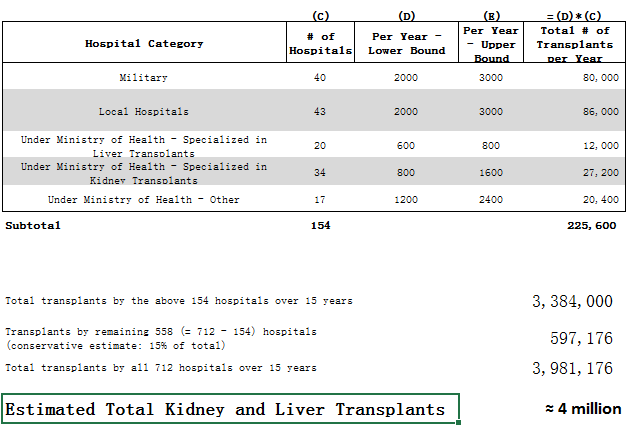
Figure6.26 Estimated total kidney and liver transplants calculation based on method of different categorys of hospitals
Over 15 years, the above 154 hospitals performed a total of 3,384,000 cases of organ transplant. There are 558(= 712-154) others hospitals capable of performing liver and kidney transplants. Since these hospitals all started performing these transplants in 2000, based on public available information released by them, we have conservatively calculated to obtain a total of 401,236 cases of liver and kidney transplants for these 712 hospitals. Then we subtracted 29,290 cases of kidney transplants and 196 cases of liver transplants, which were performed prior to 2000, from the total, and the number of organ transplants performed after 2000 would be 398,120 cases (= 401,236 - 29,290 - 196). And according to the information released by these 558 hospitals, they performed 79,222 cases of liver and kidney transplantation. Therefore, the number of liver and kidney transplants performed by these 558 hospitals are 19.8% (= 79,222 / 398,120) of the total number of liver and kidney transplants performed by the 712 hospitals. When estimating the actual amount of liver and kidney transplants performed by these 558 hospitals, we conservatively calculated based on a ratio of 15%, instead of the 19.8% in our above calculation. So, the actual total number of liver and kidney transplants performed by these hospitals is estimated to be 597,176 [= 3,384,000 / (1-15%) × 15%]. If we add up the estimated actual transplant number of the 154 hospitals and the estimated actual transplant number of the 558 hospitals, we would see that the 712 hospitals performed 3,981,176 cases (= 3,384,000 + 597,176) of liver and kidney transplants, which are approximately 4 million cases.
Therefore, as per our calculation, the estimated number of people slaughtered for organ transplants is more than 2 million. (Please see the detailed calculations in Section IX)
2. By using the calculation method based on the ratios of actual transplant numbers to publicly disclosed numbers, we obtain the results showing that the minimum number of the people killed for their organs is 2 million
1) After comparing these 11 hospitals, we discovered that the actual numbers of organ transplants at these hospitals are at least 10 times of the publicly disclosed numbers
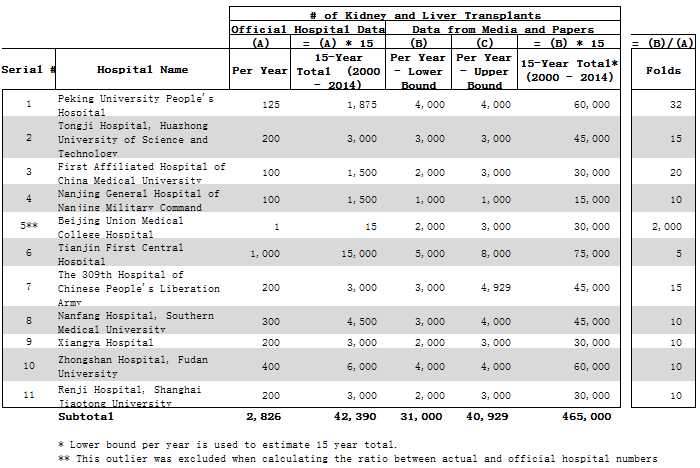
Figure6.27 Estimated total kidney and liver transplants calculation based on the ratios of actual transplant numbers to publicly disclosed numbers
After comparing these 11 hospitals, we discovered that the actual numbers of organ transplants at these hospitals are at least 10 times of these hospitals’ publicly disclosed organ transplant numbers. (Peking Union Medical College Hospital is excluded from the table, since they only disclosed one case of organ transplant.)
2) Based on the validation of number derived from these 11 hospitals, and the further comparable analysis in 44 hospitals, especially when combining with those analysis in Chapters in above, we can draw the conclusion that, it is truth as for the contents reported by witnesses, and the actual annual cases of liver kidney transplants are 2,000 to 3,000 in about 20 large local hospitals in 10 major cities
This is because:
a)These atrocities that this planet had never seen before have been taking place, as a result of Jiang Zemin’s internal policy within the CCP to persecute Falun Dafa practitioners. His instructions are: “deaths by torture are counted as suicides” and “physical elimination”. Jiang Zemin also personally ordered the harvesting of organs from living Falun Dafa practitioners. Therefore, hospitals in China have political security and guaranteed donor sources for a large number of transplants;
b)Given the fact that slaughtering Falun Dafa practitioners is a political task assigned by Jiang Zemin, and the organ transplantation in itself is lucrative, the CCP officials from the central government-level, provincial and municipal Politics and Law Committees, the PLA General Logistics Department heads and the persons in charge of these hospital would inevitably strive to perform as many organ transplants as possible. At the same time, all the participants have desperately been trying to cover up the information, especially after 2006, when the CCP’s organ harvesting organ from living Falun Dafa practitioners was exposed. They are well aware that they are committing crimes;
c)Since 2000, the CCP military and local hospitals have established numerous organ transplant centers and trained a large number organ transplant surgeons, providing the facilities and staff for the large-scale harvesting of organs;
d)Some hospitals’ transplant numbers are much higher than those of other hospitals. Although all these transplant hospitals are on the Ministry of Health’s designated list, their donor supplies vary. Our analysis is as follows: i) The hospitals have different levels of facilities and staffing, as well as different degrees of murderousness; ii) Due to varying degrees of local economic development and the hospitals’ level of influence, the hospitals would receive different numbers of transplant patients; iii) The numbers of Falun Dafa practitioners detained in different regions vary, which translates into the varying numbers of living donors that nearby hospitals can acquire; iv) As the CCP has different levels of control over these hospitals, the number of living donors and support provided by the CCP to these hospitals vary.
In summary, we believe the testimony given to The Epoch Times by the witness is credible. That is, the annual number of liver kidney transplant cases is 2,000 to 3,000 in about 20 large local hospitals from 10 major cities
3)The actual number of organ transplants at core hospitals controlled by the CCP, including the military hospitals, is 10 to 20 times higher than the number revealed to the public
The actual number of liver and kidney transplants at core hospitals controlled by the CCP, including the military hospitals, is 10 to 20 times higher than the numbers publicly disclosed by the hospitals. We drew this conclusion based on the following three factors:
First, the annual transplant numbers that the hospitals publicly reported are seldom larger than 300. Whereas the actual numbers of transplants at core hospitals controlled by the CCP, including military hospitals, are 10 to 20 times higher (2,000 to 3,000 cases per year) than the publicly disclosed numbers.
Second, based on the Ministry of Health’s criteria, considering the CCP’s concealment of the real numbers of transplants at its core hospitals, the actual transplant numbers are possibly 13.3 to 20 times, even 40 times, larger than the publicly released figures.
According to the criteria for the Ministry of Public Health designated organ transplant hospitals, the entry-level standard for a kidney transplant hospital is 30 cases per year. For a liver transplant hospital, the entry-level requirement is 20 cases per year. The entry-level standard for kidney transplant training centers is only 100 cases per year, and 50 cases per year for a liver transplantation training center. As we can see, even if a liver and kidney transplant hospital is also a liver and kidney transplant training center, the annually required cases of transplant are 150. Thus 2,000 to 3,000 transplant cases are 13.3 to 20 times higher than the required numbers.
If a transplant hospital is approved by the Ministry of Health as a generally qualified hospital to perform transplantation, and it is very skillful in covering up the truth, outsiders would never be able to tell how many organs have actually been transplanted in this hospital. Therefore, the actual transplant number might even be over 40 times higher.
For example, the Affiliated Changhai Hospital of the Second Military Medical University is well known for kidney transplantation. BaiShuzhong from the PLA General Logistics Department testified, (please see Chapter II for the partial transcripts of his testimony) “The several military medical universities of ours are able to control (organ transplants). The several military medical universities directly under the PLA General Logistics Department have repeatedly requested, because at that time, Jiang (Zemin) was very aware of this issue, and he paid close attention to this issue.” BaiShuzhong’s testimony confirms that Changhai Hospital is deeply involved in organ harvesting and the numbers of transplants are large.
However, after its former employee and urology specialist Li Baochun committed suicide, Changhai Hospital even deleted its website. According to published papers, the hospital’s annual transplant number was more than 40. We counted 45 cases/year for this hospital in our data analysis (Please See Chapter IV, the second part of Section 2). This number is actually not in line with the fact that the hospital has been directly ordered by the PLA General Logistics Department to vigorously harvest organs, or in line with the hospital’s influence within China’s transplant industry. In fact, considering this hospital’s capacity, the situation at that time, and its peers’ transplant data, Changhai Hospital should have transplanted more than 2,000 organs every year since 2004. The actual amount of transplant for Changhai Hospital therefore is 44.4 times higher than the released data.
4)we conducted an analysis based on the annual average transplant number released to the public by the Ministry of Health-designated liver and kidney transplant hospitals
Table 6.4 Liver/Kidney Transplant Hospitals Designated by the Ministry of Health
|
approved by the Ministry of Health |
Number of hospital |
Quantity of transplant |
Amount of transplant before 2000 |
Annual number of transplant per hospital after 2000 |
|
Liver Transplant |
86 |
80, 114 |
196 |
62 |
|
Kidney Transplant |
128 |
235, 641 |
29, 290 |
107 |
After 2000, the annual average number of liver kidney transplants at these hospitals is approximately 107 + 62 = 169. The actual annual amount of liver and kidney transplants – 2,000 to 3,000 cases - is 11.8 to 17.7 times larger than the number publicly released.
Based on the above analysis, we believe that the actual number of liver and kidney transplants operated by the CCP’s controlled core hospitals is 10 to 20 times larger than what is published.
5)Overall, the actual number of the CCP’s liver and kidney transplants should also be 10 to 20 times larger than the number disclosed
The above analysis does not imply that the actual numbers of organ transplants at other CCP-controlled non-core hospitals are much less. Once the Pandora’s box of organ harvesting is opened, all hospitals, which are able to obtain organs, would desperately seize every opportunity to conduct transplant surgeries for profit, without caring whether they had been approved for liver and/or kidney transplants or not. The CCP would not examine whether these hospitals were being responsible (of performing operations according to their qualifications) anyway, because the CCP’s major hospitals are well aware of the illegality of the organ source and of the political task of slaughtering Falun Dafa practitioners. Therefore, those non-core hospitals, and non-designated transplant hospitals would perform other types of organ transplants within their capabilities, as they are supported by living donor banks.
Unlike the hospitals, which have been approved to perform transplants, these hospitals transplant fewer organs than those core hospitals. The transplant numbers they disclosed are smaller than those of the approved hospitals, as well as their actual transplant numbers. Thus, the actual transplant numbers are still many times than the disclosed numbers.
As our previous analysis in Chapter IV shows, even when we perform a conservative estimate, there are still six reasons for the publicly available transplant figures to be smaller than the actual numbers. For instance, regarding the hospitals, which admitted to be transplanting organs but do not release the transplant numbers, we can only conservatively estimate that they perform 1 to 5 cases per year. There are 278 such hospitals, among which we put 1 transplant case/year for 169 hospitals.
Table 6.5 List of conservative estimates (1-5 cases) for hospitals that admitted to have been carrying out transplants but don’t disclose specific transplant numbers
|
Estimated total transplant number Between 1 to 5 cases |
Number of kidney transplant hospitals |
Number of liver transplant hospitals |
Total |
|
1 case |
98 |
71 |
169 |
|
2 cases |
7 |
14 |
21 |
|
3 cases |
10 |
15 |
25 |
|
4 to 5 cases |
46 |
17 |
63 |
|
Total |
161 |
117 |
278 |
In addition, we discovered during the investigation that, except for 100 military transplant hospitals and 40 hospitals designated by the Ministry of Health (including the former First Military Medical University-affiliated Nanfang Hospital and Zhujiang Hospital), 60 hospitals, which were not designated by the Ministry of Health, still conducted large-scale organ transplants after 2007. Prior to 2006, most of these military hospitals simply announced that they were able to perform transplant surgeries, but never released any information on the transplant numbers. They were simply “making a fortune quietly.”
In summary, as a whole, we believe that the actual total number of liver and kidney transplants is 10 to 20 times larger than the sum of the transplant numbers publicly released by hospitals in China.
6) The total number of liver and kidney transplantation exceeds 4 million, which involves at least 2 million kills
Based on the analysis above, the actual number of organ transplantation by the CCP is more than 401236×10=4012360. Followed calculation showed the number of Falun Dafa practitioners killed for organs is more than 2 millions. ((For detailed calculations, please see Section IX)
VII.The latest investigative phone recording: Chinese Vice Premier Zhang Gaoli Confirms that the CCP Harvests Organs from Millions of Living Falun Gong practitioners
On June 24, 2015, one WOIPFG investigator called Chinese Vice Premier Zhang Gaoli, using the name of a secretary at Jiang Zemin’s Office, in order to verify Jiang Zemin’s crimes of ordering the removal of organs from millions of living Falun Gong practitioners[731].
The investigation confirms:
1. As one of the incumbent Politburo Standing Committee members and Vice Premier, Zhang Gaoli did not actively deny when being asked by the investigator about “Jiang Zenmin’s order to remove organs from several millions of Falun Gong practitioners”. In addition, when asked by Jiang “to stop pursuing the matter at the Politburo meeting”, Zhang promised that “he will” and asked Jiang to “not worry”.
2. Zhang Gaoli promised that he would “handle the rest of the Falun Gong practitioners well”. This suggests that the living organ bank composed of a large number of detained Falun Gong practitioners still exists today.
3. Zhang Gaoli’s remarks also showed that Falun Gong practitioners prosecuting Jiang Zemin inside and outside of China have put considerable pressure on the CCP leadership. Zhang Gaoli, as Jiang Zemin’s loyal servant, is actively using his power to cover up the crimes in order to protect the remnants of Jiang’s faction.
Here is part of the investigation audio.
(Audio download: MP3 )
The following is part of the audio script:
Officer Li Guang: Hello?
Investigator: Is this Officer Li Guang?
Officer Li Guang: Hello!
Investigator: Hello, is Comrade Zhang Gaoli near you? This is Secretary Liu of Comrade Jiang Zemin’s Office.
Officer Li Guang: Hello, Secretary Liu.
Officer Li Guang: Vice Premier Zhang is not yet here.
Investigator: When will he be there?
Officer Li Guang: He needs at least another 40 minutes.
Investigator: Alright, I will call back in one hour, 50 minutes, is that ok?
Officer Li Guang: Yes.
Officer Li Guang: Hello
Investigator: Is this Officer Li Guang? This is Secretary Liu.
Officer Li Guang: Hello!
Investigator: Is Comrade Zhang Gaoli back?
Officer Li Guang: Please wait a moment. I will hand over the cellphone immediately.
Investigator: Ok, thank you.
Officer Li Guang: Ok.
Zhang Gaoli: Hi, this is Zhang Gaoli.
Investigator: This is Secretary Liu from the Comrade Jiang Zemin’s Office.
Zhang Gaoli: Hello, Secretary Liu.
Investigator: Hello! Comrade Jiang Zemin wants me to tell you a few words. He said that recently over 10,000 Falun Gong practitioners sued him at the Supreme Procuratorate. They accused Comrade Jiang Zemin of ordering the removal of organs from millions of Falun Gong practitioners, and they want Jiang to be accountable for this matter. So Jiang Zemin is very worried about this. He hopes…
Zhang Gaoli: Ah.
Investigator: He hopes at the Politburo meeting, you would prevent the pursuit of this matter.
Zhang Gaoli: Ok.
Investigator: Can you do that?
Zhang Gaoli: Yes, yes, yes.
Investigator: You know, the responsibility of live harvesting organs from several million Falun Gong practitioners is enormous. You know that, right? You understand.
Zhang Gaoli: I am now in Kazakhstan.
Investigator: Right.
Zhang Gaoli: I just got off the plane.
Investigator: Yes, I am saying when you go back, when you go back, you need to take care of this matter…
Zhang Gaoli: Tell President Jiang not to worry.
Investigator: There is another matter.
Zhang Gaoli: I.. I…
Investigator: that I would like to ask you.
Zhang Gaoli: I definitely will.
Investigator: You must stop this matter, you know.
Zhang Gaoli: Yes, I will.
Investigator: Comrade Jiang Zemin ordered the removal of organs from millions of Falun Gong practitioners, the responsibility of this matter is very serious.
Zhang Gaoli: ah, um, ah, I wish President Jiang health and longevity. I wish President Jiang health and longevity.
Investigator: When you go back, you must take care of this matter immediately. Also, the rest of the Falun Gong practitioners should be taken care of as well. No mistakes allowed.
Zhang Gaoli: Yes, yes, yes.
Investigator: Alright.
Zhang Gaoli: OK, ok, ok.
Investigator: Bye.
VIII.Three CCP Organ Transplant Experts Confirm that the Actual Number of Transplants far Exceeds Official Published Figures
1. Wu Mengchao: The CCP’s quantity of liver transplant is No. 1 in the world
On May 11, 2011, Wu Mengchao and his student Wang Hongyang were interviewed by Sina. The host Yin Jun asked, “At what level is our country’s current liver transplant?" Wu Mengchao replied, “At present, our number of liver transplants is No. 1 in the world; and both the quality and results are good and have caught up with the international level.[732]"
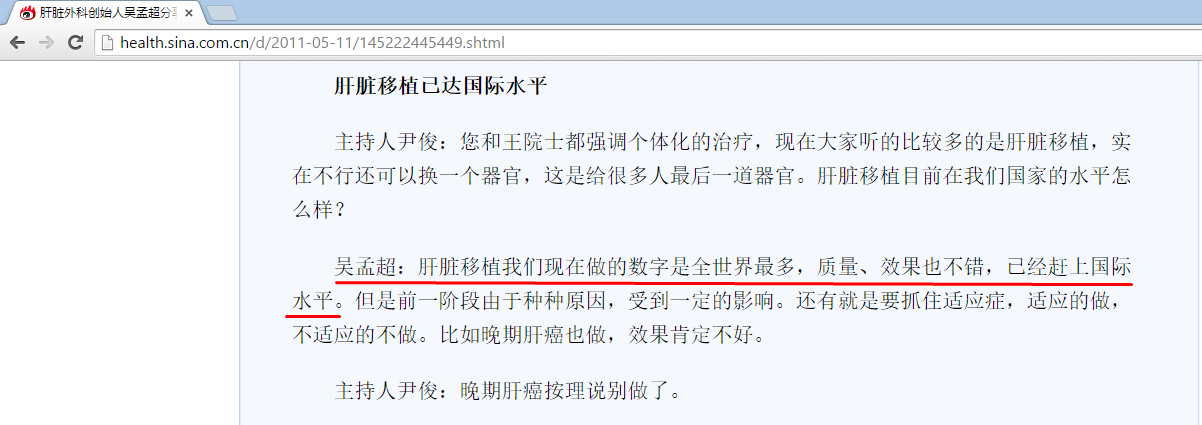
Figure 6.28 May 2011, Sina Health webpage Cached
Wu Mengchao is the president of Affiliated Eastern Hepatobiliary Surgery Hospital of Second Military Medical University, director of Eastern Hepatobiliary Surgery Institute, deputy head of the expert team at General Logistics Department of PLA, and deputy chairman of the PLA Medical Science and Technology Committee[733]. He was named an “advanced individual” for his work for the CCP top leaders’ health. Jiang Zemin received him five times[734], and personally signed an order to award him. The CCP Central Military Commission especially held a general assembly to grant Wu the title of “Model Medical Expert” and awarded him the so-called Class A Hero Medal.
2. He Xiaoshun: “The number of national liver transplant in 2000 is 10 times more than in 1999. In 2005, the number has tripled since 2000.”
He Xiaoshun: Healthcare expert for the CCP central government leaders, member of Committee of Experts on Chinese Human Organ donation[735], academic leader of Organ Transplant Studies and Vice-President at the First Affiliated Hospital at Sun Yat-sen University[736].
On November 5, 2013, an article titled “Inside Story of Human Organ Trading in China” was published on Phoenix Magazine Network. It read, “The year 2000 is the watershed of China’s organ transplant industry,” “The number of national liver transplant in 2000 is 10 times more than in 1999. In 2005, the number has tripled since 2000.[737]”

Figure 6.29 November 2013, Sina news webpage Cached
In 1999, China had 118 cases of liver transplant[738]. According to HeXiaoshun, in 2005 alone, China’s liver transplants reached 5,192 cases. At that time, liver transplants were on the rise, and a large number of liver transplant surgeons, including some military surgeons were trained. So how many livers were transplanted after 2005? For example, how many livers were transplanted in 2006, including emergency transplants?
3. The secret behind Huang Jiefu’s strange remarks
On January 12, 2015, Phoenix Television reported, “Huang Jiefu Recalls His First Participation in Organ Transplants from Executed Prisoners, and Discloses Support from China’s Central Government.”
Asked by host Sally Wu: “We (China) have more than 600 organ transplant hospitals. That is a lot. Is that because of the large gap between supply and demand (in organs)?” Huang’s response was surprising. He said, “Why the annual organ transplant surgeries are less than 10,000 cases? First, there is the economic factor. A transplant surgery is expensive, not many Chinese people can afford it. Second, we do have many qualified hospitals, yet we don’t have enough skilled and experienced transplant surgeons. The third is that we don’t have sufficient donors. But we cannot blame everything on the donors. Currently however, we cannot operate transplant surgery without enough hospitals and doctors even though we have abundant donors.”
Since the CCP has recently been hyping up that 1.5 million patients are waiting for organ transplants; the number of executed prisoners has been decreasing; there are very few voluntary donors; and the quantity of transplant surgeries in China’s hospitals has decreased due to the shortage of donors, Huang Jiefu should have responded that the lack of donors was the first reason. On the contrary, he emphasized that the most important reason was that many people couldn’t afford such surgeries. (Note: when being interviewed by Phoenix Health on March 15, 2015, Huang Jiefu claimed that 22,000 wealthy patients were waiting for organ transplants[739], this number was far greater than the officially claimed available donor number). Huang’s second reason was that there were not enough hospitals or qualified surgeons.
There is only one reasonable explanation for Huang’s strange answer: what he stated is that the need to massacre on a large scale for organs serves is a contrast to the severe lack of wealthy patients, hospitals and doctors. Huang claimed that the transplant number was less than 10,000, which is also an illusion the CCP deliberately fabricates. The real number of transplants is far beyond our imagination.
It should be noted that we did not include the alarming numbers we discussed above in our national liver kidney transplant statistical report. The reason is to present a clearer contrast. The only exception is the Union Hospital in Beijing. Its recorded cases of liver transplant available to the public is almost zero, however, because of Huang Jiefu’s own disclosure, we estimated there would be 5,000 cases of liver transplant performed at his hospital over 15 years (2000—2014). This is only a conservative estimation.
Even for the 400,000 cases of liver transplant, it is an average of more than 26,000 cases per year, which far exceeds the number of executed prisoners and a variety of other possible sources. Moreover, over 100,000 living donors are needed per year because of the existence of reverse matching. Therefore, the CCP can never explain away its donor sources by claiming they are from executed prisoners.
IX. Illustration on the Calculation to obtain the Conclusion that number of Falun Dafa practitioners slaughtered for their organs is suspected to exceed 2 million
Based on the above analysis, we calculated the number of liver and kidney transplants to be 400,000. However, that is only the tip of the iceberg of the CCP’s real number of organ transplants. The real number may be 10 to 20 times more, that is, 4 to 8 million cases of liver and kidney transplant. Therefore, the minimum number of Falun Dafa practitioners killed for their organs is suspected to be more than 2 million. Our projection process is as follows:
1. The total number of kidney transplant is 3.2 to 6.4 million
From 2000 to 2014, the proportion of kidney transplants is 75.9% of the combined number of liver and kidney transplants (based on our previous analysis of 400,000 cases of kidney transplants, kidney: liver = 28: 9). Taking into account the following three factors:
1.1 There are many hospitals not disclosing the number of organ transplants. All such 171 hospitals which only revealed kidney transplantation available could only count as “one case”.
1.2 Economic factor. The approximate price for one kidney transplant is 200,000 yuan, whereas one liver transplant costs 500,000 yuan. Kidney transplants are much more affordable.
1.3 Liver transplants are technically demanding.
Hence, the real ratio of kidney transplants should be higher than 75.9%. According to our conservative estimate, the ratio is 80%. That is, there are 3.2 to 6.4 million cases of kidney transplants.
2. The proportion of two kidneys being utilized simultaneously is less than 50%
One person has two kidneys, but seldom are both used for transplantation (if both were used, the number of people slaughtered should be 1.6 to 3.2 million). In less than 100% of the cases, both kidneys are used. The reasons are as follows:
1)Restricted by “cold ischemia time”
In organ transplant surgeries, an excised organ must be stored in a special nutrient solution as soon as possible, otherwise it cannot be used. Moreover, a surgery must be done within the effective cold ischemia time. There is no such thing as storing an organ for future use. Cold ischemia time refers to the time period between an organ being cold perfused after its blood supply was cut off and the moment when the blood supply is restored[740].
At present, the cold ischemia time for kidneys shall not exceed 24 hours; the cold ischemia time for livers cannot be more than 15 hours; and for hearts, the limit is six hours[741].
2)Donors’ detention, matching, organ excision and transplant are completed regionally
Unlike the United States, China does not have a Network for Organ Sharing (referred to as UNOS). Since donors are executed prisoners, tissue typing is conducted within a small area or locally, which inevitably leads to low rates of two-kidney matching simultaneously, and the waste is obvious.
The following two typical incidences prove that organ allocation is regional:
The first example: the Three Northeastern Provinces Organ Alliance was established in February 2006. On March 2, 2006, Xinhua News Agency published a report titled “Three Northeastern Provinces Organ Transplant Consortium Ushered in its First Beneficiary”. At that time, the Alliance was founded less than one month before[742].
The second example: On September 28, 2005, Huang Jiefu, then Vice-Minister at the Ministry of Health, performed an autologous liver transplant on a liver cancer patient, Yao Shufa, at the First Affiliated Hospital of Xinjiang Medical University, by using two living livers as backup. One day before the surgery, Huang contacted the First Affiliated Hospital of Zhongshan Medical University in Guangzhou and Liver Treatment Center, Southwest Hospital of Third Military Medical University in Chongqing, respectively, and requested they prepare a living liver in case the autologous transplant failed. The operation lasted over 40 hours and was successful. Huang announced that the backup living livers were not needed[743]. This proves that organ donor resources in Chongqing, Guangzhou and Xinjiang are managed separately.
3)The proportion of both kidneys being used simultaneously is very small as a result of matching difficulties plus limited wait times for donor organs
From the perspective of matching, 30% (approximate ratio of same blood type) multiplied by 6.5% (HLA typing rate) equals to 2% (complete matching rate). In recent years in China, kidney transplant patients generally wait less than two weeks for a matching donor to be found. The average number of such patients in one city within two weeks is actually very limited: suppose one or several hospitals transplant 2,600 kidneys per year. This would amount to 100 transplants in two weeks. The proportion of simultaneously matching (for two-kidney or more organs) was very low. The waste of the other organ grafts from “donors” would be very obvious unless many hospitals in a large area were all capable to conduct combined extraction of organs and transplantation simultaneously. However, there was no nationwide organ matching and distribution network before 2014[744]. For many hospitals, there is no other hospital nearby which could conduct combined extraction/transplantation of organs. Many hospitals only distribute the organ grafts to itself without sharing with other hospitals. (See Chapter VI Section I: the testimony given to The Epoch Times by a deputy director of a university hospital). Due to difficulties in coordination and transportation, arranging for simultaneous transplantation operations among hospitals in different metropolitan areas is very hard. In our opinion, the waste rate of organs due to difficult matching would be very high.
4)The living donors are disposable resources
Surgery is necessary to excise an organ. A reasonable deduction here is that the living donor would not be taken care of afterward to be used again for the other kidney or another organ. Thus, it is normal to kill a person for just one of his/her organs if multiple organ excision is not feasible. We rarely see multiple organ excision in published papers, which should also serve as a piece of evidence.
5)The existence of numerous emergency transplants proves that living donors are detained close by; and that there are even living donor concentration camps in some hospitals’ basements or neighborhoods
For the above reasons,again based on our previous discussion regarding a large number of emergency transplants, such as organ transplants performed in less than 72 hours after the patient’s admission. There are even cases where the operations take place within 4 hours. We conclude that many hospitals have living donor detention centers in their neighborhoods; some hospitals even have underground living donor concentration camps.
6)Last,and most importantly,when it is a political task to “eliminate(Falun Dafa practitioners)physically”, would the hospitals care about whether living donors’ organs are fully utilized? The organ supply is abundant and so easily accessible and cheap, killing a practitioner to get one organ is normal for the hospitals involved.
3. The minimum number of Falun Gong practitioners killed for their organs is more than 2 million
Due to the above mentioned reasons, although a person has two kidneys, the probability of using both of them simultaneously is very low. Our estimation is less than 50%. Let’s calculate from the perspective of kidney transplant, at least 2.13 million (4 million × 80% / (1 + 50%)) were killed for their kidneys. After the maximum deduction of other donor sources, the number of Falun Dafa practitioners killed for their organs is more than 2 million.
X.Case Study: Academician Li Leishi, Vice Dean of Nanjing Military Region General Hospital ; How his Military Research Institute of Nephrology Transplanted over 1,000 Kidneys in 2004and his Subsequent Suicide
On March 16, 2010, "the world's leading expert in Nephrology", Li Leishi, vice dean of CCP Nanjing Military Region General Hospital, one of the first academicians of the Chinese Academy of Engineering, committed suicide by jumping from his home on the 14th floor of his residential building on Beijing West Road in Nanjing. His death led to many discussions of what was the real reason for his suicide and raised doubts about organ harvesting once again.
Li Leishi was the founder and leader of the largest military kidney transplant center. In 2009, the CCP Central Military Commission strongly commended his "outstanding deeds" and gave him a first-class merit award. An announcement of “Learning from Li Leishi” by the Chinese military in 2007, said, "Li Leishi built the first nephrologist center in military with ‘two and a half’ doctors and 10,000 yuan in funds allocated by the hospital in 1979. Two years later, he established the National Institute of Nephrology. In the past, kidney transplant was a surgery, but he was a physician. He was involved in the field of kidney transplantation, and under pressure and criticism, but achieved success. Starting with only a dozen cases per year, the number of transplants grew into more than one hundred cases per year. The center became one of the largest kidney transplant centers in China. Up to 2004, the center conducted over one thousand cases of kidney transplant[745]. In addition, academician Li Leishi chaired the first and the second edition of "Chinese Kidney Transplant Manual", which means, he had done a lot of transplant surgeries in mainland China.
The description is a little confusing here and it can have two interpretations: 1. Over one thousand cases of kidney transplant in 2004; 2. By 2004, the cumulative number of kidney transplant was over one thousand cases.
However, according to other CCP propaganda, we found that the above refers to "the cumulative number of kidney transplant was over one thousand cases by 2004."
1. Li Leishi disclosed publicly in 2008, that he conducted 120 cases of kidney transplants in person each year, which confirmed the existence of organ harvesting.
In December 2008, Li Leishi published an article in China, titled "Organ donation after death exists in theory, but in fact is hard to achieve"[746]. "Organ transplant donors have a large gap: Because we are working for a research Institute, the amount of surgeries is not very large. In the past, I could do kidney transplant for 120 patients per year, but now only 70. Just looking at my own number of surgeries, compared to the original number, there is a shortage of at least 50 people." That is, Li Leishi had personally done 120 cases of renal transplant every year, or, two cases every week. For a doctor in his seventies, he would have had to work nearly every day and night. From the perspective of the international transplant community, the number of surgeries he conducted was quite amazing. It is obvious that "organ donors are sufficient"; and that number was sustained by the presence of large "organ donor pool".
Li Leishi also admitted in this article: "Organ donation after the death of a citizen, only exists theoretically in China, but in fact is impossible, because there are no institutional and legal conditions for its existence." Technically speaking he said, "When death has occurred, you contact the families to discuss the donation, but it has already missed the best time. The organ has ischemia too long, so it cannot be used to transplant any more. So in China, organ donation after death does not exist in the system. In addition, legal protection is also one of the problems. China's brain death criteria, organ donation have no legal protections." Since there is no mortality donation for a long time, Li Leishi actually admitted the need of removal of organs from "prisoners” who had no freedom.
2. Is the 1,000 kidney transplants which caused the Nanjing Military Region Kidney Disease transplants research Institute to obtain the first class merit, a one- year amount, or a cumulative total amount?
1)Superficially, it is the cumulative total amount of transplants.
From the current webpage of Chinese Communist Military Institute of Nephrology (http://www.njszb.com), you can find materials about "Organ Transplant Center" (Figure 2), which shows: "Kidney Transplant Center of People's Liberation Army Institute of Nephrology was established in 1994. Under the leadership of academician Li Leishi, it had already carried out more than 1,400 kidney transplants after over ten years of development with the arduous pioneering spirit and hard work "[747]. This figure is in line with the CCP’s propaganda on its military Institute of Nephrology's performance of organ transplantation.
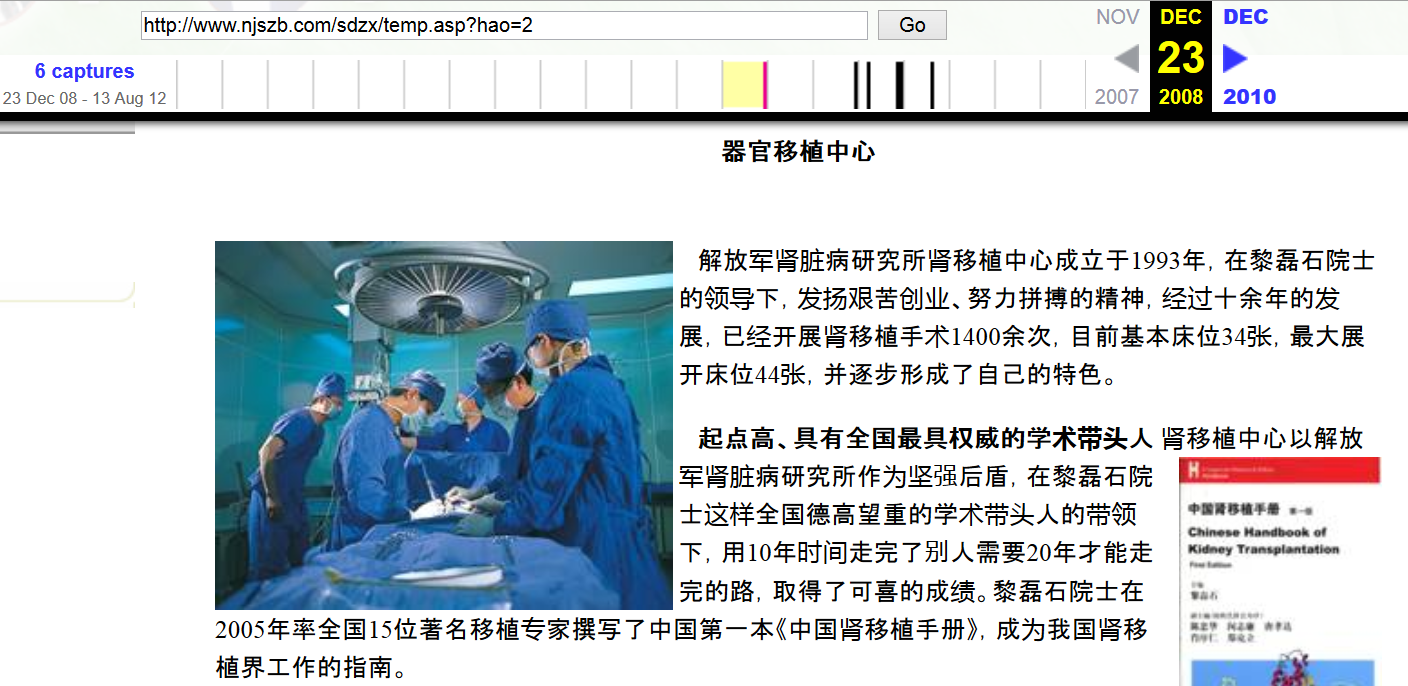
Figure6.30 Introduction to organ transplant center of Li Leishi
Now the question is: are the statistics published by the CCP true? Or just false propaganda to cover up the truth?
2)Contradiction 1: If it is the total amount of transplants, then from 2004 to Li Leishi's death, in 5 years, was it 80 cases of renal transplantation / year, or 40 cases fewer than Li Leishi's number of 120 individual cases / year? !
Because we know that earlier academician Li Leishi said in person at the end of 2008: "In previous years, I could do surgeries for 120 kidney transplant patients, but now only 70 patients." That leader of "PLA Institute of Nephrology, Kidney Transplant Center", eighty-year-old academician Li Leishi can do 120 kidney transplant cases a year, but the number of kidney transplants done at the kidney transplant center for the entire year was only 80 cases. It seems that dozens of other professors and experts of the Chinese Communist Party General Hospital of Nanjing Military Region Kidney Disease Institute had been paid for years without working, but only eighty-year-old Li Leishi, Nanjing Military Region General Vice dean, and an academician of Chinese Academy of Engineering had been working so hard and conducted 120 transplants a year, in which 40 cases were missing, and only 80 cases were reported. So is this the reason for Li's suicide?
3)Contradiction 2: The total number of organ transplant is actually very low, so it was impossible to obtain a first class merit
"General Hospital of Nanjing Military Region had over one thousand cases of renal transplantation". It was an outstanding achievement in the organ transplant industry, and hospitals conducting over a thousand kidney transplants would be very rare at that time, therefore, it was worthy of such publicity. However, according to the article "Progress of the Same Kind of Kidney Clinical Transplant" by Lixin Yu, from the Organ Transplant Center, Nanfang Hospital, First Military Medical University published in June 2204 in the Medical Journal of Chinese People’s Armed Police Forces in Issue 6, Volume 15, as early as 2000, transplant centers in China conducting a total number of 1,000 kidney transplants were already numerous. This included Beijing Friendship Hospital, Guangzhou Nanfang Hospital, the First Clinical Hospital of Sun Yat-sen University, People's Liberation Army General Hospital, First Hospital of Xi'an Jiaotong University, Beijing Chaoyang Hospital." Even before December 2001, Beijing Friendship Hospital and the Guangzhou Nanfang Hospital had over 2000 cases.

Figure 6.31: Part of conditions of kidney transplant centers with more than one thousand transplant cases
The above list only shows a portion of these hospitals. “By 2002, 2,590 cases of kidney transplantation had been conducted." We also found that in November 2004, the Chinese Communist Party's official media, "Guangming" website reported that "Beijing Friendship Hospital kidney transplants had exceeded 3,000 cases"[748].

Figure6.32 Brief History of PLA Urology of Nephrology Center
From 2000 to 2004, is the CCP's so-called period of great development of organ transplantation. Known as the most active, the PLA Nanjing Military Region Kidney Disease Institute, could only reach the lower performance levels of other hospitals in the organ transplant four years previously, so these were not "outstanding deeds" at all. Nevertheless, the PLA Institute of kidney disease obtained a first-class merit in 2004 due to its performance.
4) Contradiction 3: The medical malpractice of three young doctors from the Military Institute of the Nephrology Kidney Transplant Center, performed hundreds of surgeries in one year prior to 2001. However, Li Leishi thought punishing them would only reduce a small amount of cases of renal transplantation, but would not fundamentally affect the results of the whole center.
An excerpt from "An interview with academician Li Leishi" in "China military network", the portion "on medical ethics"[749]:
Li Leishi said, “On the medical staff being strict and harsh, was there one memorable case? In today's society, people are in pursuit of luxury, being flashy, and enjoying life. I can give one or two examples. Again, what I do is in line with what I think. So comrades who worked with me for a long time can understand my actions. It was 2001, I had just conducted a surgery. I was not in charge of the ward then. We had a patient in a ward bleeding after surgery. We did have a doctor there to monitor the patients, but the bleeding could not be stopped. He called the doctor who performed the surgery, but the doctor told him it did not matter, just give him a blood transfusion. Later he called another doctor, who said to take the patient’s vital signs and report them to another doctor. So the doctor on duty phoned another doctor, a 30-year-old doctor. It was about three o'clock in the morning, and it disturbed the other backup doctor. He hurried to the hospital but the patient died around seven o'clock. They did not know what happened, and thought there was always a doctor there taking care of the patient. They did not know about the phone calls. Later, the emergency scene was very big, and the doctors tried their best. But we did not think so ourselves, so we decided finally to fire all three... I struggled with this decision, because all three of them were protagonists and performed hundreds of kidney transplants a year. To fire all three together, people thought I was very brave. I thought, I'd rather do a few less kidney transplants next year, but not harm others, or put the patient in the first place on medical ethics. I'm going to set an example...”
In this text, academician Li Leishi talked about a medical malpractice taking place at the PLA Institute of Nephrology in 2001. They thus dismissed three on duty doctors that day, one "operation doctor", "a director", and "a 30-year-old doctor." The critical information is what academician Li Leishi said himself, “Because they three were all protagonists, and conducted hundreds of cases of kidney transplants a year. To fire all three together, people thought I was very brave. I thought, I'd rather do a few less kidney transplants the next year, but not harm others...” Accordingly, we can tell as early as in 2001, in the PLA Institute of Nephrology where Li Leishi worked, just three doctors on duty that day had "conducted hundreds of cases of kidney transplant a year. According to Chinese interpretation, he could only say so unless there are at least more than three hundred cases. So how many doctors and specialists worked in the PLA Institute of Nephrology? By this calculation, in 2001, what was the total number of kidney transplants at the PLA Institute of Nephrology?
According to the information, the PLA Institute of Nephrology where Li Leishi worked was very active, having nearly 30 kidney transplant specialists: Two academicians in Academy of Engineering, 5-6 experts with national special allowance, about 20 doctors with graduate degrees or with overseas training. The "30-year-old doctor" in the story probably cannot be counted here, because he was "transferred to the clinic" afterwards. In 2001, three doctors on duty on the same day, were not the only ones who conducted surgery. They conducted a few hundred cases of renal transplantation a year, indicating that the PLA Institute of Nephrology simply was not "short of organ donors". That is to say, the PLA Institute of Nephrology where Li Leishi worked had already been using organ donors on a large scale. Even if these three doctors were dismissed, as for the PLA Institute of Nephrology, it was just, "do a few less cases of renal transplant next year". Thus, in 2001, the amount of kidney transplants of the institute was very large, and it would have been more than a thousand cases.
5)To sum up, the only conclusion we can draw is that the 1000 cases of kidney transplantation in CMC citation was an annual amount.
Obviously, "in 2004, the cumulative number of kidney transplant was over one thousand cases," was "false propaganda" by the CCP on Li Leishi's organ transplant center, and the statistics were also forged. So that we can understand why the CCP used the vague statement in the PLA Institute of Nephrology citation that, "in 2004 the number of kidney transplants was over one thousand cases". The CCP actually awarded this center. "In 2004, the annual transplant amount was over one thousand cases."
3. The award given to the "PLA Institute of Nephrology", exposed the severity of the CCP shrinking the number of organ transplants? More than 10 times
According to the report, "General Hospital of Nanjing Military Region Had over a Thousand Cases of Renal Transplantation, a Number of Technologies Reached an International Level" at the end of 2004, "So far the operations amount has exceeded one thousand, the kidney transplant this year alone has reached 113 cases, and the survival rate of patients is 100%". This indicates that the kidney transplant center in 2004 official statistics was only 113 cases of kidney transplants. However, from the above reasoning, we have concluded that the kidney transplant center had "one thousand cases of kidney transplants in 2004". It can be calculated that the actual amount of organ transplants will be 8.85 times the disclosed amount.
According to the CCP’s published statistics, in 2001, the number of kidney transplants was around 5,500 cases, and in 2004, kidney transplants were about 7,000 cases. The number of kidney transplant operations in mainland China in 2004 was 30% more than those done in 2001. According to this growth rate, the PLA Institute of Nephrology should have actually conducted 1,300~2,600 cases of kidney transplant surgeries in 2004. Thus, according to 113 cases of the CCP statistics in 2004, the actual number of organ transplants was about 11.5 ~ 23 times of the statistics.
4. Li Leishi's Institute emphasized technical guidance, rather than the surgical procedure, then how many surgeries did other hospitals conduct?
Li Leishi said: "Because the center is a research Institute, the numbers of surgeries done was not huge." This could be true in a sense, since the PLA Institute of Nephrology had two academicians, five or six experts with senior titles. Although they conducted 1,300 to 2,600 cases of kidney transplants in 2004, in the CCP’s organ harvesting and transplant system, they still emphasized doing "research guidance" for doctors for other military and local hospitals, rather than on "operations". Then what about 40 other military organ transplant centers and hospitals, what was the real number of organ transplants they conducted?
5. Li Leishi was persecuted during the Cultural Revolution. He did not commit suicide because he said, "I am not a counter-revolutionary, I am not sinful." Why did he commit suicide decades later?
Li Leishi had cancer in 2000, when those three doctors began to conduct "hundreds of cases of kidney transplants a year", and when the PLA Institute of Nephrology under his leadership began the large-scale use of "organ donors". It remains unknown if he thought about why he had cancer.
Li Leishi talked about why he did not commit suicide when he was being persecuted by the CCP in his interview. He said, "When I was an active counterrevolutionary person, thousands of people denounced me in a General Assembly. Some people asked me, you suffered so much, losing your wife and children, why don't you commit suicide? I said I would not, I do not think I am counter-revolutionary, and I am not sinful."
Decades later, Li Leishi achieved the peak “honor” in his life. However, facing the denouncement of international justice forces due to the CCP's organ harvesting from living Falun Gong practitioners, he could no longer say “I'm not guilty”.
References:
[516]Exclusive: Exposure hidden in Medical University Hospital in shocking secret:Zhou Yongkang case disclosed the truth will touch the collapse of the Communist regime, Zhou case involved to participate in Jiang Zemin’s launch of "live harvest Falun Gong practitioners' organs." Epoch Times.
[517]Tianjin First Central Hospital, Editor Qu Lulin,"www.enorth.com.cn",June 25, 2014.
[518]Oriental Organ Transplant Center launched yesterday(9/1/2006),"News.Sohu.com", September 2, 2006.
[519]To explore effective ways and methods to protect myocardial, a project from Department of Anesthesiology passed the acceptance check. The result revealed a mechanism of myocardial injury during perioperative liver transplantation. "Tianjin First Central Hospital"
[520]Gu Bo and Tan Qiling, The third Comprehensive Ward improved workflow, shorten the average days being hospitalized for kidney transplant patients. "Western China Hospital, Sichuan University", June 28, 2013.
[521]An Investigation to foreigners going to China to have organ transplants." Phoenix Weekly",Oct. 1, 2010.
[522]The renovation project of First Central Hospital in Tianjin city, "China Building Renovation Network"
[523]Yang, Xu,“China Organ Transplantation Network”“Oriental Organ Transplant Center was put to Use Yesterday”Tianjin Daily, Sept. 5, 2006.
[524]Organ Transplantation Institute,People's Liberation Army (PLA) General Hospital of General Staff Headquarters(PLA 309 Hospital)
[525]An Introduction to Data Center, "Chinese Renal Transplant Scientific Registry System"
[526]2009National Army Organ Transplantation Conference held in Beijing, "Century Library (www.redlib.cn)"
[527]An Introduction to Data Center, "Chinese Renal Transplant Scientific Registry System"
[528]Overview of Organ Transplant Center, "People's Liberation Army 309 Hospital", November 17, 2010
[529]Overview of Organ Transplant Center, "People's Liberation Army 309 Hospital", November 17, 2010
[530]Overview of Organ TransplantCenter, "People's Liberation Army 309 Hospital", November 17, 2010
[531]Tianjin First Central Hospital Organ Transplant Center,"www.enorth.com.cn", April 20, 2009
[532]Memorabilia, "Tianjin First Central Hospital"
[533]Tianjin First Central Hospital,"www.enorth.com.cn", Oct. 26, 2010. Republished on "Phoenix Chinese Medicine"
[534]Acenterin Tianjin completed nearly 2,000 kidney transplants within nine years in total."Xinhua Net TianjinChannel", Dec. 30, 2007.
[535]Overview of Organ Transplant Center, "People's Liberation Army 309 Hospital",Nov. 17, 2010
[536]Overview of Organ Transplant Center, "People's Liberation Army 309 Hospital", Nov. 17, 2010
[537]309 Clinical Department, "Good Doctors Online: the largest medical website in China"
[538]Tianjin First Central Hospital Organ Transplant Center,"www.enorth.com.cn", April 20, 2009
[539]Liao Limin, Shi Bingyi, Liang Chunquan, Cai Ming, MoChunbai, QianYeyong, Jiang Zhizhen andLiZhouli, Report of 7 cases of postoperative tuberculosis after renal transplantation.Urology Department of PLA 309 Hospital, "Chinese Journal of Urology”, Vol10, 1995.
[540]Overview of PLA Organ Transplantation Center, the Second Affiliated Hospital of PLA General Hospital, "Chinese National Knowledge Infrastructure(CNKI)"
[541]Overview of PLA Organ Transplantation Center, Beijing Military District 309Hospital, "xinhuanet.com", Feb.13, 2009
[542]Sun Shubo and Chen Hui,“Shi Bingyi, the doctor whom patients won’t forget”, Pharmaceutical Economy News,Updated Aug.13, 2006. Republished on "Huayuan Pharmaceutical Network(www.hyey.com)"
[543]In total of 2766 cases of kidney transplants and 603 cases of liver transplants, Google search results.
[544]National Army Institute of Organ Transplantation, "People's Liberation Army309 Hospital"
[545]Impressive, touching and thankful, a CPPCC News Special report of Shi Bingyi, the Director of organ transplant Institute (part 4), "People's Liberation Army 309 Hospital", Mar. 20, 2015
[546]Chen Liping, Cai Ming, Qian Yeyong andShi Bingyi, Analysis of Cardiovascular disease risk factors in patients after renal transplantation. Medical Journal of People's Liberation Army, Vol. 39, No. 09, pages 746-750, 2014. Beijing People's Liberation Army 309 Hospital Organ Transplantation Research Institute, zip code100091.
[547]Chen Liping, Cai Ming, Qian Yeyong andShi Bingyi, Analysis of Cardiovascular disease risk factors in patients after renal transplantation. Medical Journal of People's Liberation Army, Vol. 39, No. 09, pages 746-750, 2014. Beijing People's Liberation Army 309 Hospital Organ Transplantation Research Institute, zip code100091.
[548]Expert: the reduction source of organs from executed prisoners will increase the number of patients waiting for treatment. (Sep. 3, 2013). Xinhua News. Source: China Economic Weekly.
[549]Liver and kidney transplant “Peking University People’s Hospital” 2014-07-16 July 16,2014
[550]Liver and kidney transplant “Peking University People’s Hospital” 2014-07-16 July 16,2014
[551]Cut kidney Party rampant in Wuhan, female colledge student killed and dumped, parents petition but battered. (Nov. 30, 2011). Sina Global News.
[552]Wei Jiang Yun : Wuhan evil triangle organ harvesting in the holy Land of Xinhai Revolution; China Historic City of Light hides the most bloody evil of mankind. (Sep. 25, 2010). Epoch Times.
[553]Further Investigation on Organ Transplants at Jiujiang No. 1 People's Hospital (Photos, Recording), clearwisdom.net, November 17, 2006
http://www.clearwisdom.net/emh/articles/2006/11/17/79997.html
[554]David McNeill and Clifford Coonan,Japanese flock to China for organ transplants. Greater China, Apr 4, 2006.“Asia Times”(Republished with permission from Japan Focus)
[555]“IPC(China) network support center” about the donor
[556]“IPC(China) network support center” online communication
[557]“IPC(China) network support center” introduction
[558]“IPC(China) network support center” practical situation of organ transplantation in China
[559]“China organ transplantation net” a brief introduction to the organ transplantation section of the first affiliated hospital of China Medical Science University [Dated: Feb 28, 2011]
[560]“Introduction to the IPC(China) network support center” brief introduction to doctors
[561]“China organ transplantation net” a brief introduction to the organ transplantation section of the first affiliated hospital of China Medical Science University [Dated: Feb 28, 2011]
[562]“Introduction to the IPC(China) network support center” organ transplantation research institute
[563]Profil,Nanfang Hospital of Southern Medical University
[564]Brief Introduction,Nanfang Hospital of Southern Medical University
[565]Annex 1: the list of the hospitals that have passed the examination of board of clinic application of human organs transplant technology of the Ministry of Health, the Notice “Ministry of Health on carrying out correctly the registration of clinic subjects of human organs transplantation”,August 6, 2007,Website of National Health and Family Planning Commission,
[566]“Guangdong Medical Association”, Guangdong Medical Association on the Evaluation of the Quality of Kidney, Liver and Heart Transplant at different hospitals
[567]World Organization to Investigate Persecution of Falun Gong has discovered that it was Jiang Zeming who ordered personally and directly to use the organs of Falun Gong practitioners for organ transplantation.
http://www.zhuichaguoji.org/node/44818
[568]“Southcn.com”, “With Averagely Three Kidney Transplantation, Guangdong Province has one of fifth of the operations nation wide.” By Zhang Xiaolei, journalist of Yangcheng Evening News; Ma Zewang, Intern journalist
[569]“The Development of the clinical transplantation of the same kind of kidney in China”, by Yu Lixin (Center of Organ Transplantation of Nanfang Hospital of No. 1 Army Medical University, Guangzhou 510515), Medical Journal of the Chinese People’s Armed Police Forces) Vol. 15 No. 06 2004-06
[570]“Report of 1082 Cadaveric Renal Transplantations”, by Yu Lixin, Bai Xiwen, Luo Yongli, Wang Jinyi, Xu Jian, Fu Shaojie, Ma Junjie, Deng Wenfeng, Wang Yibin, The Journal of Urology of China,1998 Vol. 2
[571]Hospital Profil, The Third Xiangya Hospital of Central South University
[572]Annex 1: the list of the hospitals that have passed the examination of board of clinic application of human organs transplant technology of the Ministry of Health.doc, the Notice “Ministry of Health on carrying out correctly the registration of clinic subjects of human organs transplantation”,August 6, 2007,Website of National Health and Family Planning Commission,
[573]Big Events, The Third Xiangya Hospital of Central South University
[574]“Lungs Infections and The Analysis of the Related Factors Post-Renal Transplantation”, Wu Kun, Zhang Jinyan, XieWenju, Yi Bin, Li Yuanming, Practical Preventive Medicine, page 489-490, Vol. 10-04, 2003
[575]“The Management of the Follow-up reports of 2000 patients who have received the renal transplantation”, by XieJianfei, Baidu Wenku
[576] “Retrospective Discussion on Prognosis Impact of Splenectomy on Liver Transplantation”, by Ye Qifa, She Xingguo, Ming Yingzi, Cheng Ke, Ma Ying, Niu Ying, Ren Zuhai, Liu Bin, Zhao Yujun, Xiang Ya, (Transplantation Medical Engineering Technology Research Center of Ministry of Health, Xiangya Transplantation Research Center of Central South Univeristy, Transplantation Center of The Third Xiangyang Hospital of Central South University, Changcha, 410013), page 159-161, Vol. 15-03, 2008, “Chinese Journal of Bases and Clinics in General Surgery”
[577]Department of Transplantation, The Third Xiangya Hospital of Central South University
[578]Department of Transplantation, The Third Xiangya Hospital of Central South University
[579]Big Events, The Third Xiangya Hospital of Central South University
[580]“Deputy Minister of Health ‘doing the surgery” for Liver Transplantation at the Third Xiangya Hospital, by Tan Keyang, Li Honghui, September 19th, 2003, Central South University News Web
[581]Big events, The Third Xiangya Hospital of Central South University
[582]“Marching Towards the Ideal Kingdom of Transplantation—Director Huang Zufa on the Development of Transplantation Medicine”, News Paper of The Third Xiangya Hospital of Central South University
[583]Big Events, The Third Xiangya Hospital of Central South University
[584]"social service network at Third Hospital in Xiangya" transplant specialist
[585]Deputy Minister of Health conducted Liver transplantation at the Third Hospital in Xiangya, published: 2003 - 09 -19 Author:Tan Keyang, Li Honghui
[586]“Domestic and Foreign Experts Gather Together in Changcha, Organ Transplantation Law Ready to Come out, September 24th, 2003, Public Health News Paper
[587]Annex 1: the list of the hospitals that have passed the examination of board of clinic application of human organs transplant technology of the Ministry of Health.doc, the Notice “Ministry of Health on carrying out correctly the registration of clinic subjects of human organs transplantation”,August 6, 2007,Website of National Health and Family Planning Commission
[588]Fudan University Affiliated Zhongshan Hospital, 91985.com
[589]“Zhongshan Hospital Joins Hands with The Biggest Organ Transplantation Organization in the World The Organ Transplantation Reaching A New Level”, by Correspondent Qian Sicui, Journaliste Chen Qing, December 9th, 2003, sina.com.cn
[590]“Knowledge and Practice of the Management of Medical Security”, August 2006, Vol. 10-08, by Qin Xinyu, Qin Jing, JinYaping, RongZhaijun, “China’s Hospital”.
[591]Brief Introduction, Organ Transplantation of Fudan University
[592]Anniversary Special Edition, Vol. 184, September 22, 2007, Zhongshan Hospital News Papter, Fudan University Affiliated Zhongshan Hospital
[593]Brief Introduction, Organ Transplantation Center of Fudan University
[594]Renal Transplantation, Organ Transplantation Center of Fudan University
[595]Renal Transplantation, Organ Transplantation Center of Fudan University
[596]Profil of Fan Jia, China’s Famous Doctors Guide
[597]“Fan Jia, the Mysterious Director of the Department of Liver Surgery, October 21, 2005, People, sina.com.cn
[598]Liver Cancer Specialists, Baidu Documents
[599]“2012 My Favorite Health Guardien” polls on the website,Fudan News and Culture Web”
[600]“The First Liver Transplantation from A Liver Donor with a Robot as the assistant during the surgery was successfully carried out”, by Chen Jing, Source: China News Web, March 14, 2014, Sicencenet
[601]“ZhongshanIranman and His Fans”, March 30, 2015, Jiefang Daily
[602]“Only by putting the patient in the center place can one become an excellent ‘Health Guardien’—On Professor Fan Jia, one of the 10 “My Favorite Health Guardien” price winners in 2012”, Zhongshan Hospital News Paper
[603]“The Standard of Selection of Liver Transplantation for Patients of Liver Cancer”, by Fan Jia, Xu Huan (200032, Liver Surgery Fudan University Affiliated Zhongshan Hospital, Liver Cancer Research Center of Fudan University, Shanghai), page 536-537 Vol. 14-07, 2006,Chinese Journal of Hepatology
[604]“Special Edition: The Evidences Collected by World Organization to Investigate the Persecution of Falun Gong on Removing Organs from Live Falun Gong Practitioners”, World Organization to Investitage the Persecution of Falun Gong http://www.zhuichaguoji.org/node/46728#_Toc366574832
[605]National Army Institute of Nephrology. "xinhuanet.com”
[606]Hepatobiliary Surgery Introduction "Peking Union Medical College”
[607]LiuRuihong, Wang He, Li Ying and He Hanfu, "Former Vice Minister of Ministry of HealthHuang Jiefu saying: I want to take the leadtobow to donors."Guangzhou Daily, March 13, 2013.Republishedon "Ocean Net (www.dayoo.com)".
[608]State Council appoints and dismisses national staff,Personnel Division, Ministry of China Human Resources and SocialSecurity,March 12, 2013.
[609]Huang Jiefu,Vice Minister of Ministry of Health,organtransplant will be controlled by national regulations.“Beijing News”, March 14, 2008.Republishedon xinhuanet.com
[610]Regulations of human organ donation implemented in Tianjin onMarch 1st, 2013. Tianjin Daily, March 1, 2013. Republishedon website of China Central Government(www.gov.cn).
[611]An Introduction to the Department of Liver Surgery, Peking Union Medical College Hospital
[612]Profile of Mao Yilei, Peking Union Medical College Hospital
[613]Profile of Sang Xinting, Peking Union Medical College Hospital
[614]Profileof Zhong Shouxian, Peking Union Medical College Hospital
[615]Brief Introducion, Shanghai Jiaotong University Affiliated Renji Hospital
[616]Renal Transplantation Urology, Shanghai Jiaotong University Affiliated Renji Hospital
[617]“Liver Transplantion Team of Organ Transplantation Center of Shanghai Renji Hospital”, June 28, 2007, China Organ Transplantation Web” (transplantation.org.cn)
[618]170 Year-Old Ren Ji: Ancient and Modern, October 16, 2014, Source: Xinmin Weekly, ifeng.com
[619]“Shanghai First Liver Transplantation Demonstration Center Opens Its Door at Renji Hospital”, April 02, 2015, Shanghai Jiaotong University News
[620]Liver Transplantation Demonstration Center Opens Its Door at Renji Hospital, April 03, 2015, Source: Jiefang Daily, Xinhuanet.com
[621]Liver Transplantation: Clinic Project of Liver Surgery, Shanghai Jiaotong University Affiliated Renji Hospital
[622]Transplantation: Maximizing The Hope of Life –On Shen Zhongyan, Tianjin Liver Transplantation Expert and His Team, Jan 6, 2015, China Technology Market News Paper
[623]“Xia Qiang, Marshal in the Domain of Liver Transplantation, by Huang Qi, June 23, 2006, People.com.cn
[624]“Xia Qiang, Marshal in the Domain of Liver Transplantation, by Huang Qi, June 23, 2006, People.com.cn
[625]The Number of Children Receiving Liver Transplantation Hit A New Record at Renji Hospital in 2014, Jan 19, 2015, Shanghai JiaotongUniveristy News Web
[626]“Renji Hospital overwhelmed by the number of liver transplantations Doctors have to stay over night doing the surgeries in the operation room”, August 19, 2013, Eastday.com, wenweipo.com, sh.sina.com.cn,
[627]“Renji Hospital overwhelmed by the number of liver transplantations Doctors have to stay over night doing the surgeries in the operation room”, August 19, 2013, Eastday.com, wenweipo.com, sh.sina.com.cn,
[628]“Xia Qiang, Marshal in the Domain of Liver Transplantation, by Huang Qi, June 23, 2006, People.com.cn
[629]The Ninth China Medicine Price Winner, Director Xia Qiang of Liver Surgery of Renji Hospital, July 4, 2014, by Ren Qiehui, Shi Weiqiang, Looking at the Sky---Institute of Medicine of Shanghai Jiaotong University
[630]“Liver Transplantion Team of Organ Transplantation Center of Shanghai Renji Hospital”, June 28, 2007, China Organ Transplantation Web” (transplantation.org.cn)
[631]“Shanghai, a City with a History of Hundreds of Years Bred
AnesthesiaMagnificantly, The Second Eastern Anesthesia and Perioperative Conference
[632]“Inspired and Created by the Airport The New Section of Renji Hospital Starts on a High Speed of Taking in and Sending out, eastday.com
[633]Top Headline: Doctors from Mainland China testifies that Live Organ Harvesting is still going on The Source is controlled by the Chinese Army, updated on March 20, 2015, ntdtv.com
[634]“Today’s Commentary: What to do if there are not Enough Organs after Executed Prisoners’Orang Donations are Stopped?”Sina News. Dec. 4, 2014.
[635]Profile of Capital Medical University.
[636]The Affiliated Hospital of Shanghai Jiaotong University.
[637]Introduction to Beijing Friendship Hospital’s Urology Department.
[638]Jiang, Yuerong, Meng Qingling and Fan You. “Beijing Friendship HospitalPerformed over 3,000 Cases of Kidney Transplantation”. Guangming Daily. Nov. 19, 2004.
[639] Introduction to Beijing Chaoyang Hospital’s Hepatobiliary Surgery Department.
[640]Multi-organ Combined Transplantation Research Key Laboratory of the Ministry of Health. Baidu Encyclopedia.
[641]“Profile on Expert: He Xiaoshun.” First Affiliated Hospital of Sun Yat-Sen University official website.
[642]“Introduction to the Organ Transplantation Department.” First Affiliated Hospital of Sun Yat-Sen
[643]Introduction to the Kidney Transplantation Department.”Sun Yat-sen University’s Institute of Organ Transplantation.
[644]Ministry of Health’s Key Laboratory of Forensic Science, Xi’an Jiaotong University.
[645]Introduction to Kidney Transplantation Department. First Affiliated Hospital of Xi'an Jiaotong University.
[646]Introduction to Kidney Transplantation Department. First Affiliated Hospital of Xi'an Jiaotong University.
[647]“First Affiliated Hospital of Xi’an Jiaotong University Performed more than 4,000 cases of Kidney
[648] Introduction to Shanghai Clinical Center for Organ Transplantation Center (Affiliated Shanghai First People's Hospital),"School of Medicine, ShanghaiJiaotong University"
[649]Overview of Shanghai Clinical Center for Organ Transplantation, "Shanghai First People's Hospital"
[650] Brief Introduction to the Kidney Transplant Center, "West China Hospital, Sichuan University"
[651]Brief Introduction to the Liver Transplantation Center, "West China Hospital, Sichuan University", Published on Sept. 2, 2004
[652]Remember the oath, strive to be the pioneer in the field of liver transplantation, "Worker’s Union of Sichuan University”
[653]Military Hospital Openly Admits Transplant Organs Come from Falun Gong Practitioners (Photo)
[654]Department of Organ Transplantation, "Shanghai Changzheng Hospital"
[655]Investigation Leads: Report on Organ Transplants in Shanghai (Photos), "Minghui Net"
[656]Fu Zhiren and Ma Jun, Prognostic factorsand treatment after emergency liver transplant for severe hepatitis patients. "Journal of Clinical Surgery", June 2006,Vol. 14, No. 6.
[657]Brief Introduction to Department of Urology and Transplantation, "Fuzhou General Hospital, Nanjing Military District"
[658]Brief Introduction to the Institute of Liver Transplantation," General Hospital of Armed Police Forces"
[659]Brief Introduction to Department of Urology, "People's Liberation Army General Hospital"
[660]Yu Lixin, The progress of clinical allogeneic kidney transplant in China, “Medical Journal of the Chinese People's Armed Police Forces”, June 2004, Vol 15 No. 6. (Organ Transplant Center,Nanfang Hospital, First Military Medical University, Guangzhou510515, China)
[661]Deliver warmth and strength, the first conference of “Friends of Liver”, People's Liberation Army General Hospital, "Chinese Organ Transplant Network", November 14, 2011
[662]Overview of Xinjiang Institute of Organ Transplant, "First Affiliated Hospital of Xinjiang Medical University", March 11,2014
[663]Jiang Cuiqing, Wang Huicai, Wang Lixin, Bi Yuan, Song Bei and Zhou Xian, Preliminary experiences of monitoring 4207 patients after liver transplant." Endemic Diseases Bulletin",2003 Vol. 18, Issue No. 02, pages75-76. (Xinjiang Medical University First Affiliated hospital, Xinjiang, Urumqi, 830054)
[664]《The Xinjiang Procedure》 - The Weekly Standard Jul 29, 2013, Vol. 18, No. 43 By ETHAN GUTMANN
[665]Inside Story of human organs business in China, "Phoenix Weekly Magazine Network", November 5, 2013
[666]"Tongji University History Museum" Academician Wu Mengchao’s Profile, inherit and carry forward the spirit of working hard to build an innovative country!
[667]"Chinese Radio Network" Wu Mengchao’s Biography.
[668]"www.minghui.org" Jiang Zemin’s evil industry of militarizing live organ harvesting.
[669]"Sina Health" Mengchao Wu, founder of liver surgery in China, shares liver disease prevention and longevity. Nov. 5, 2011.
[670]"www.hbver.com" Dealing with end-stage liver disease, there is 'diamond'” Health News newspaper. Dec. 30, 2004.
[671]"Hepatobiliary world. "Liver Transplant Center of Southwest Hospital.
[672]Subject Introduction to “Second Urology scientific net, Xinqiao Hospital, Third Military Medical University”.
[673]“The PLA’s Urology Nephrology Center Performed 24 Cases of Kidney Transplant in OneDay.” Minghui.org.
[674]Introduction to Urology Department at Jinan Military General Hospital"
[675]Jinan Military General Hospital. "www.dzwww.com.” “Qilu Evening News." Dec. 01, 2008.
[676]"General Hospital of Shenyang Military Region" Special Technology of Keratoplasty.
[677]“General Hospital of Shenyang Military Region" GaoMinghong: Ophthalmology’s Academic Leader
[678]"General Hospital of Shenyang Military Region" Special Technology of Keratoplasty.
[679]"General Hospital of Guangzhou Military Region" Special Technology of Keratoplasty.
[680]“Introduction to Hepatobiliary Surgery Department at General Hospital of Guangzhou Military Region”.
[681]"People's Liberation Army General Hospital of Chengdu Military Region," Urology introduction
[682]"People's Liberation Army 303 Hospital" Organ Transplant introduction
[683]www.haodf.com Affiliated Hospital of Armed Medical College, Nephrology introduction
[684]"www.120.net" Dr. Li Hui’s Profile
[685]"PLA Four-seven-four hospital" Center of Organ Transplantation and Blood Purification
[686]" hunan.voc.com.cn - public health reporting version" 10- 21-2005 report
"Hustle and bustle is going on -note the Organ Transplant Center Kidney Transplantation of Second XiangyaHospital "
[687]" hunan.voc.com.cn - public health reporting version" 10- 21-2005 report
"Hustle and bustle is going on -note the Organ Transplant Center Kidney Transplantation of Second XiangyaHospital "
[688]"Bethune First Hospital of Jilin University" Fuyao Wen Ph.D. of surgery (Urology)
[689]"Bethune First Hospital of Jilin University" Fuyao Wen Ph.D. of surgery (Urology)
[690]"Zhujiang Hospital" Organ Transplantation Center
[691]"Jiangsu Provincial People's Hospital" Hospital introduction
[692]"Jiangsu Provincial People's Hospital" liver surgery Introduction
[693]"Jiangsu Provincial People's Hospital" liver surgery Introduction
[694]" official website of Jiangsu Provincial People's Hospital" Wang Xuehao’s Profile
[695]"Xijing Hospital" Hospital Introduction Source: political propaganda department Published: 8-1-2014
[696]'Beijing Navy General Hospital "Medical Center of Hepatobiliary Surgery
[697]"Chinese etiquette training network" Published: 4-8-2010 "medical etiquette training - Zhengzhou People's Hospital Services banner and brand style
[698]"Southern Medical University, People's Hospital of Zhengzhou City" Hepatobiliary Surgery Introduction
[699]"Sina Finance" the largest hospital in annual revenue over 7.5 billion, is joked that they let Henan people liver pain
[700]"interactive encyclopedia" People's Liberation Army 153 Hospital (Eastern)
[701]"China Medical Network" - kidney transplantation - Advertising Source: "WOIPFG: An Investigation Report on the Chinese military, the Armed Police Hospital participating in organ harvesting from living Falun Gong practitioners"
[702]"Sina blog" 254 Hospital of Tianjin male kidney transplant breakthroughs: successes in capture of infection, rejection off (12-14-2009)
[703]"Hebi network-www.hebiw.com " 464 Hospital of Tianjin
[704]"Chinese city map" PLA 464 hospital 3-10-2007
[705]"NetEase" relying on the market to protect the "battlefield" - remember ZHANG Cong, President of PLA 452 Hospital 01-12-2009 Source: Xinhua
[706]"Minghui" Record: Falun Gong practitioners’ kidney are used outspoken by Military hospital 5-2-2006
[707]" Beidaihe Sanatorium of Beijing Military Region " Hospital Introduction
[708]" Beidaihe Sanatorium of Beijing Military Region " Hospital Introduction
[709]" Beidaihe Sanatorium of Beijing Military Region " kidney Transplantation Center
[710]"Chinese Journal of Convalescent Medicine" 8-9 pages 01 item 17 volumes 2008 (English journal name: CHINESE JOURNAL OF CONVALESCENT MEDICINE) "313 cases of bulk kidney transplantation surgery with the organization and management"
Author: Qiaoshu Fang, Zhang Jiyun (Beijing Military Region, the first health resort of Beidaihe Sanatorium, 066100);
[711]"Baidu Encyclopedia" 307 Hospital
[712]"People's Liberation Army 307 Hospital - National Key Minimally Invasive Urology Center," the official website
[713]"Minghui" investigative leads: Beijing 307 Hospital operates kidney transplant every night 5-10-2006
http://www.minghui.org/mh/articles/2006/5/10/127363p.html#2006-5-9-chclues-1
[714]"WOIPFG" WOIPFG evidence album about the CCP organ harvesting from living Falun Gong practitioners"
http://www.zhuichaguoji.org/node/46728#_Toc366574827
[715]"Seventh People's Hospital of Zhengzhou City," Introduction of Kidney Transplantation Nephrology
[716]" www.familydoctor.com.cn " Introduction of Organ Transplant Center
[717]"www.xinhua.net" "ranking list the top hundred hospitals without any Yunnan hospital nominated" 11-3-2014 Source: www.people.com.cn
[718]"Yuhuangding Hospital in Yantai City" GaoZhenli’s Profile
[719]"dk.sun0769.com" Dongguan People's Hospital is eligible for pilot qualification of organ transplants 07-21-2011
[720]"minghui.org" investigative leads: Mainland hospitals attract customers operating kidney transplant in the Southeast Asian actively
[721]“Introduction to Kidney Transplantation at Peking University Third Hospital”.
[722]“Introduction to Urology Department at Wuhan General Hospital of Guangzhou Military Region."
[723]“Introduction to Urology Department at Wuhan General Hospital of Guangzhou Military Region."
[724]“World Organization to Investigate Persecution of Falun Gong”Investigation Report about Alleged Participation of Organ Harvesting from Live Falun Gong Practitioners by the CCP’s Military and Armed Police Hospital System. First draft April 21, 2008. Finished Version May 29, 2012.
http://www.zhuichaguoji.org/node/21820
[725]Special edition about WOIPFG of Evidence of the CCP live organ harvesting from Falun Gong practitioners. The WOIPFG.
[726]Information on Changhai Hospital Urology Department’s Kidney Transplant.
[727]“WOIPFG obtained new evidence: Jiang Zemin ordered the harvesting of organs from Falun Gong practitioners for transplantation” Published online September. 30, 2014
http://www.upholdjustice.org/node/260
[728]Seven sets of figuresrepresenting30 years’leap forward of Chinesemilitaryhealthcare,"xinhuanet.com",December 17, 2008
[729]China said it would strike hard"illegalorgan transplants","Radio Free Asia", Aug. 18, 2014
[730]Development and Status of Chinese liver transplant program,International Liver Disease, March 5, 2013. Republished on "Love liver for your life" [ILTS2011].
[731]"Zhang Gaoli Confirmed the Organs of Millions of Living Falun Gong Practitioners were Harvested." The WOIPFG.
[732]Founder of liver surgery Wu Mengchao shared the mystery of liver disease prevention and longevity,"Health.Sina.com.cn",May 11, 2011
[733]Profile of Academician WuMengchao:inherit and carry forward the spirit of Tongji and work hard to build an innovative country."Historical Museum of Tongji University"
[734]Wu Mengchao biography, China National Radio (www.cnr.cn)
[735]Profile of He Xiaoshun, Department of Organ Transplantation, First Affiliated Hospital of Zhongshan University,yynet.cn
[736]Profile of He Xiaoshun, "First Affiliated Hospital of Zhongshan University"
[737]Labyrinth of organ donation, News.Sina.com.cn
[738]Overview of liver transplant in China's development and progress, "Good Doctors Online (www.haodf.com)"posted by Rao Wei.
[739]"Former Deputy Minister of the Ministry of Health:imprison of Zhou Yongkang breaks the profit chain of organ transplant from executed prisoners.“Phoenix Network”, March 16, 2015. Republished on Finance Network (caijing.com.cn)
[740]Cold Ischemia Time, National Cancer Institute
[741]The Ministry of Health published the Specifications for liver,kidney, heart andlung transplantation practices." China 315Integrity Network"
[742]First beneficiary appeared in Dalian, "xinhuanet.com”
[743]Inside Story of human organs business in China,"Phoenix Weekly Magazine Network",November 5, 2013
[744] "National Health and Family Planning Commission and Chinese Red Cross Have Launched New Organ Donation Online Registration Platform." April 3, 2014. Source: Beijing News. Author: Wei, Mingyan. "
[745]Decision on Learning from Comrades Li Jieshou and LiLeishi,"Chinese Military Network"
[746]LiLeishi,Organ donation after death is difficult to achieve in reality although theoretically possible."Health.Sohu.com"November 27, 2008
[747]Organ Transplant Center, "People's Liberation Army Institute ofKidneyDisease"
[748]Jiang Yueyong, MengQingling(correspondents) and FanYou(reporter),Beijing FriendshipHospital exceeded 3,000cases of kidney transplantation.Guangming Daily,November 19, 2004. Republished on "Guangming Net (www.gmw.cn)"
[749]Interview with Academician Li Leishi,"China Military Network (www.81.cn)"























